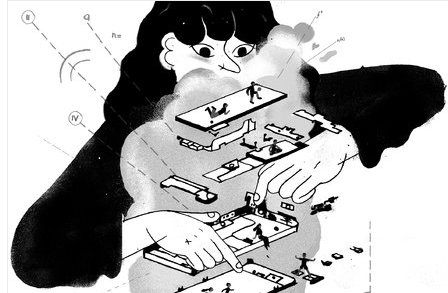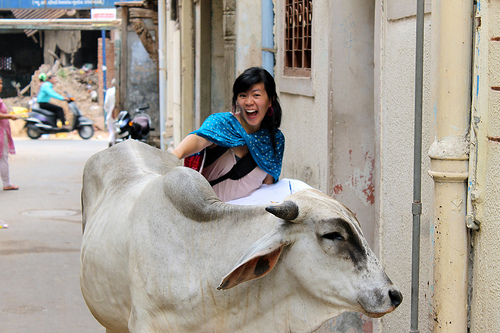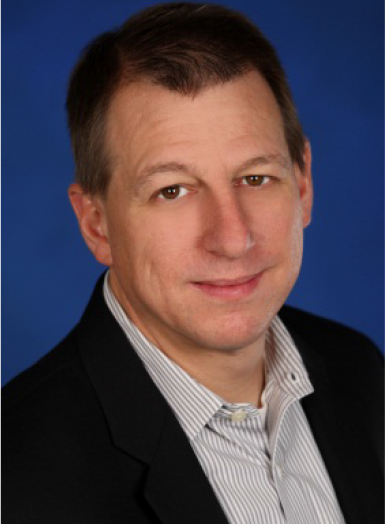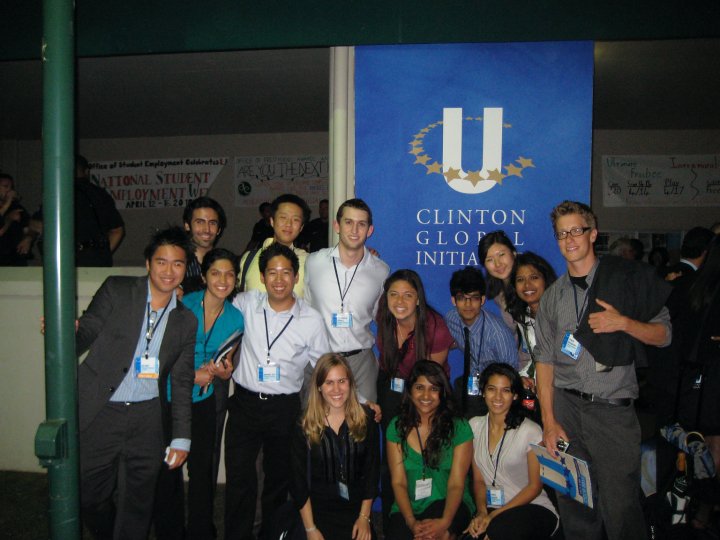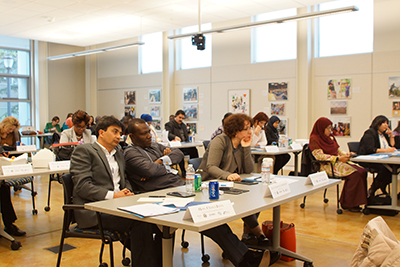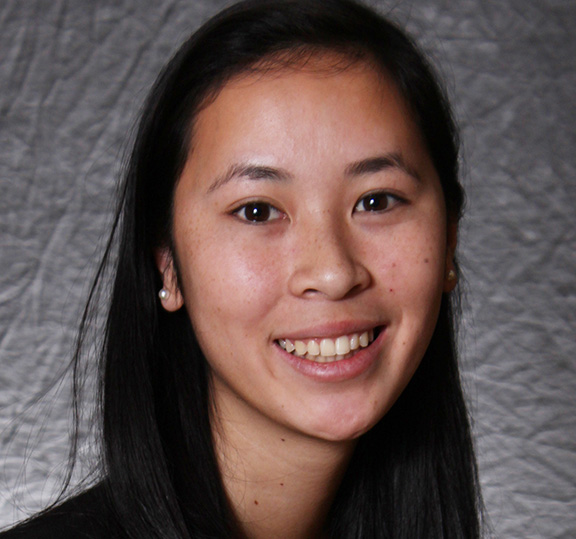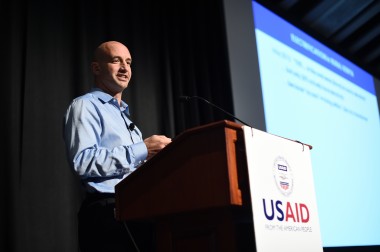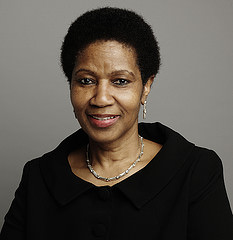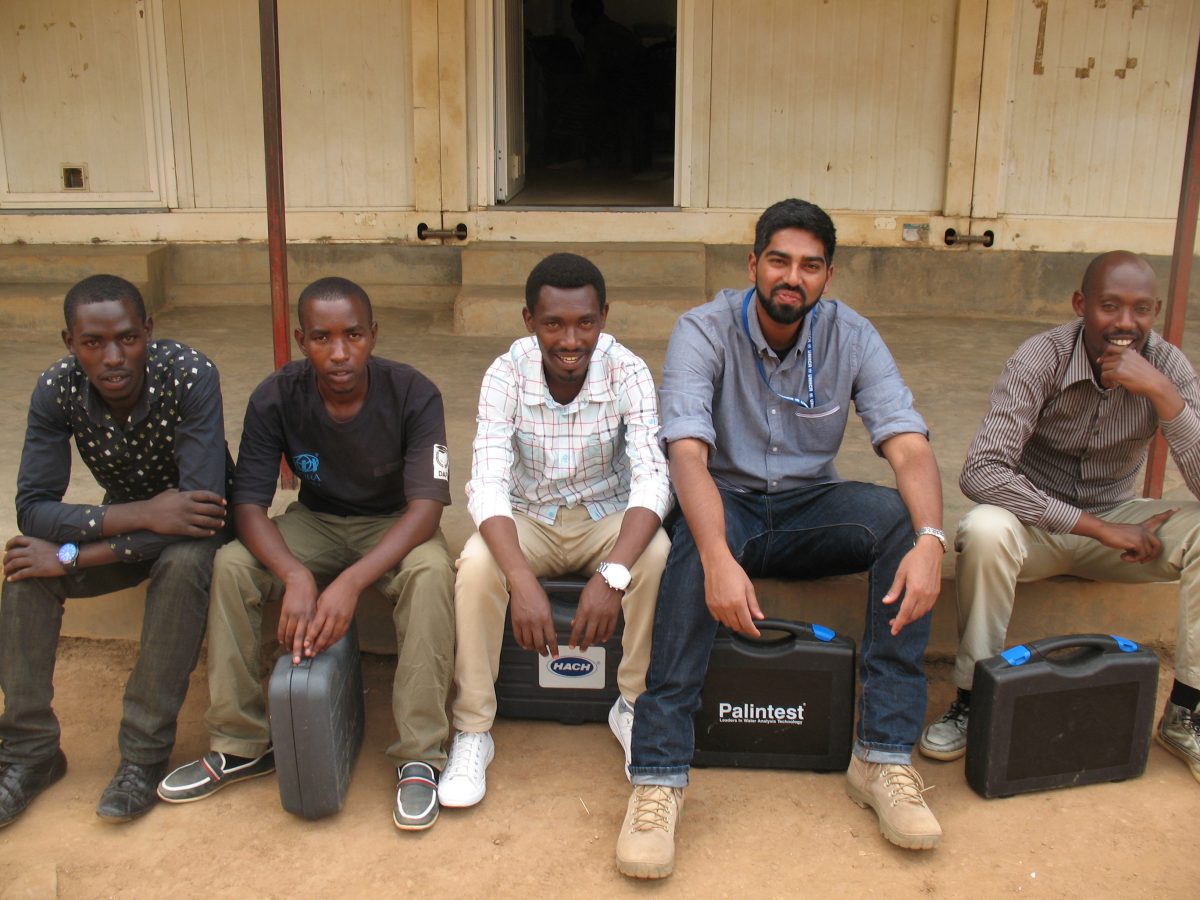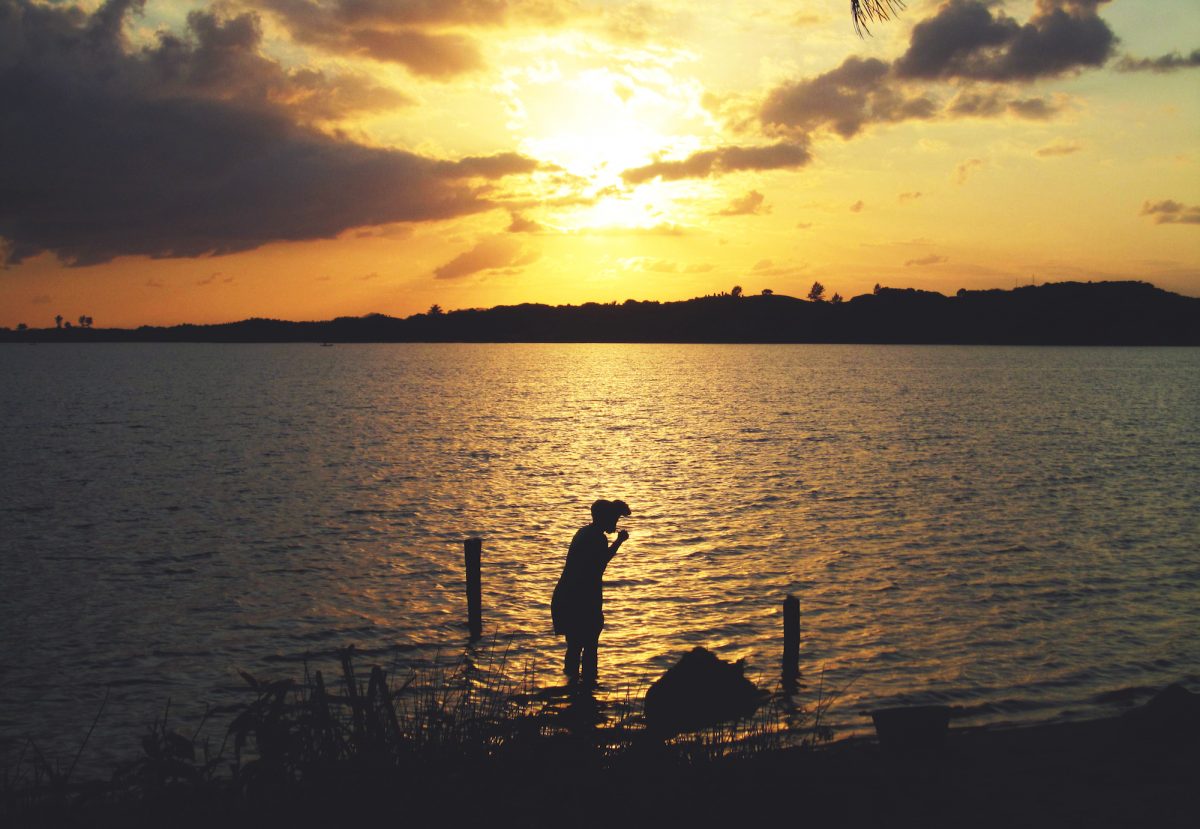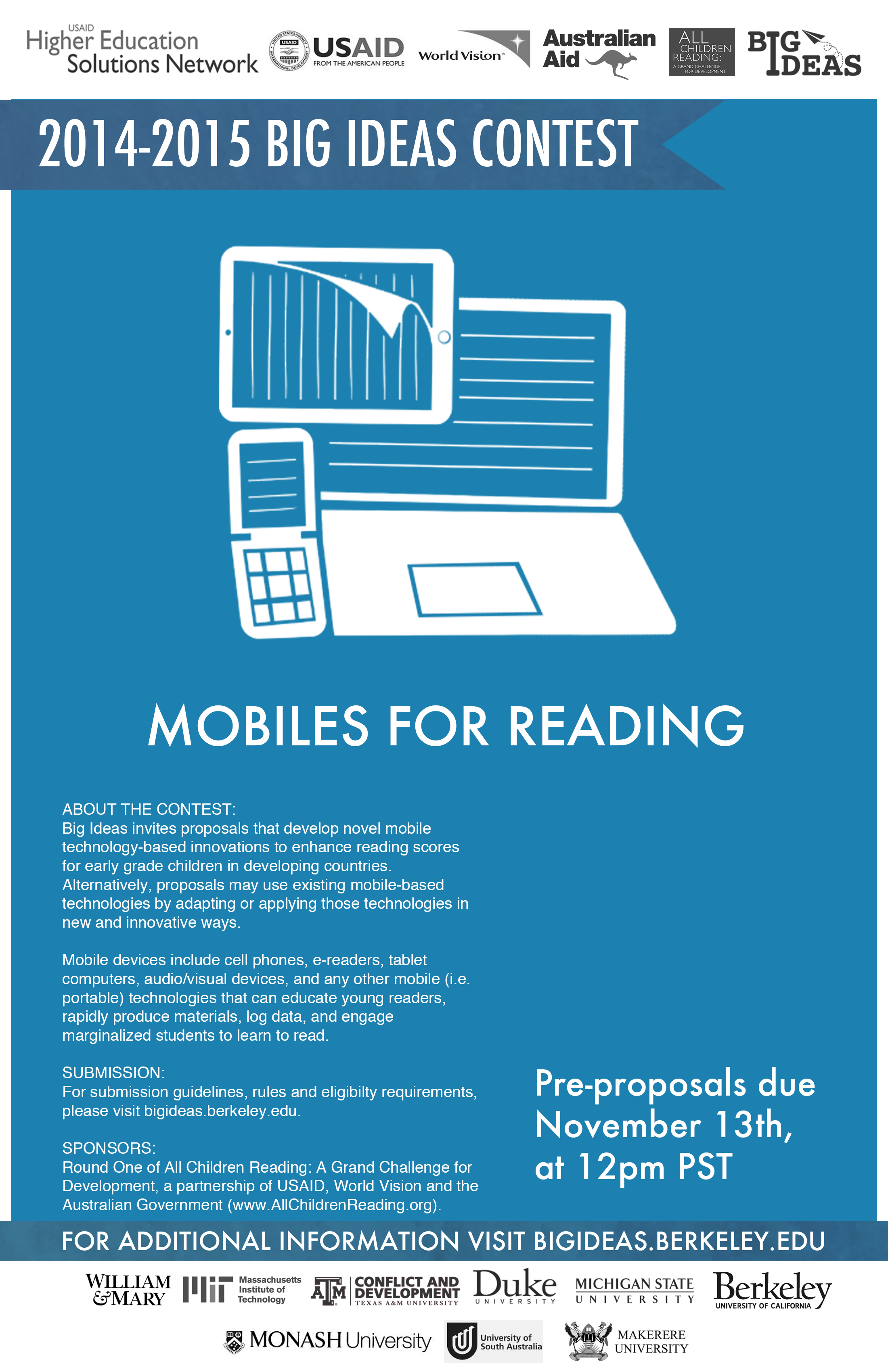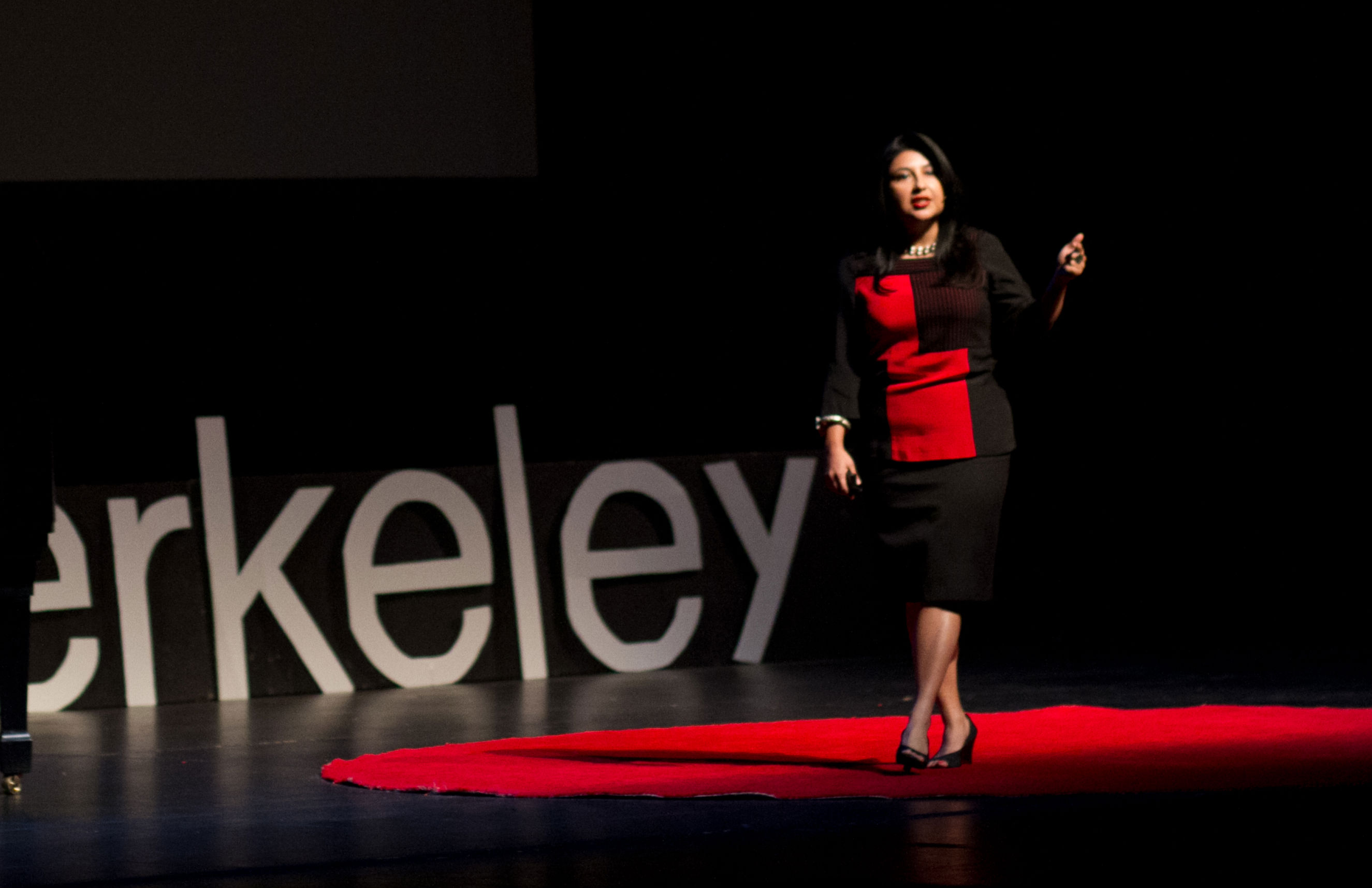http://newscenter.berkeley.edu/2015/05/06/video-cellscope-automates-detection-of-parasites/
Category: News
The Ultimate Innovation Jam: Big Ideas@Berkeley Announces 2014-2015 Contest Winners
Hand-To-Hand: Human Rights Accompanier Kaya Allan Sugerman
By Sean Burns
There are places in the world where, if you are born into a tradition of subsistence farming and you are determined to preserve that tradition, you risk being murdered. The resource rich, Urabá region of northwestern Colombia is one such place. The reasons for this extreme danger are many and complicated, and recent UC Berkeley graduate Kaya Allan Sugerman is learning them first hand or, perhaps more precisely, hand-to-hand.
Allan Sugerman is a “human rights accompanier” for a number of marginalized villages in different parts of Colombia, the most well known of which is called La Comunidad de Paz de San José de Apartadó (Peace Community of San José de Apartadó). In 1997, campesinos from several villages declared themselves a Peace Community in an effort to advance their right for political and economic autonomy in a region plagued by violence. The communities face fierce, multi-actor warfare largely fueled through contestation over land that is ideal for drug trafficking routes. Urabá is adjacent to the border with Panama, and therefore lies at a geographical doorway to the markets of Latin and North America. The Colombian Army, state-affiliated paramilitary groups, and guerilla factions—the best known of which is the FARC—have fought for decades in this area. Civilian causality numbers are horrific. Since 1997, in the small villages of Peace Community alone, there have been 210 killings. The unprecedented 2013 report “Enough Already,” produced by Colombia’s National Center of Historical Memory, puts these numbers in an alarming national context—over 200,000 civilian casualties since 1958, most of these since the 1980s.
To compound this terror, public and private corporations seek profits through extracting the abundant, diverse natural resources of this area and other regions throughout Colombia. Water, mineral deposits, and land for corporate banana farming are at the top of the list. Corporate quests for these resources have historically resulted in mass displacement of indigenous, afro-descendent and campesino communities—an act referred to by human rights lawyers as “involuntary resettlement.” Against these multiple threats to their survival, the Peace Community, for 18 years now, has committed to a non-violent project of autonomy. From the beginning, they knew they could not walk forward alone.
This is where individuals like 25-year-old Kaya Allan Sugerman come into the picture. Allan Sugerman is a member of the international human rights organization Fellowship of Reconciliation Peace Presence (FOR Peace Presence). Its mission is to provide “physical safety, political visibility and solidarity by accompanying communities and organizations that embrace active nonviolence to defend life, land and dignity.” Very importantly, the organization’s commitment to accompany must begin with an invitation.
In 2001, shortly after two massacres in the region, the Peace Community in Colombia, which numbers around 1,500 residents, requested that FOR Peace Presence consider establishing human rights accompaniers in their villages. Human rights accompaniment is a preventative tactic increasingly used by threatened communities in many parts of the world, to diminish violence by having international volunteers physically present amidst their communities.
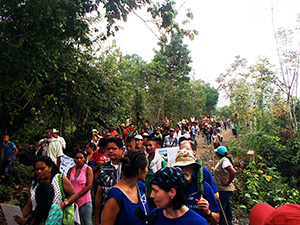 The tactic works for a simple yet disconcerting reason. When poor and vulnerable communities are accompanied, or observed, by people from around the world —then the perpetrators of violence are less likely to commit atrocities for fear of retribution. Thus, human accompaniment works through the power of witnessing—a certain kind of witnessing. Its efficacy reminds us that in our world, some lives are worth more than others. Allan Sugerman, a U.S. citizen, and her fellow FOR Peace Presence members provide protection to campesinos, because they physically embody the potential of diplomatic and economic intervention by powerful, outside states. In this respect, as others have explored, the tactic is inextricably bound up with dynamics of nation, race, and class privilege.
The tactic works for a simple yet disconcerting reason. When poor and vulnerable communities are accompanied, or observed, by people from around the world —then the perpetrators of violence are less likely to commit atrocities for fear of retribution. Thus, human accompaniment works through the power of witnessing—a certain kind of witnessing. Its efficacy reminds us that in our world, some lives are worth more than others. Allan Sugerman, a U.S. citizen, and her fellow FOR Peace Presence members provide protection to campesinos, because they physically embody the potential of diplomatic and economic intervention by powerful, outside states. In this respect, as others have explored, the tactic is inextricably bound up with dynamics of nation, race, and class privilege.
Allan Sugerman’s path toward human rights accompaniment runs right through her experiences in the Blum Center’s Global Poverty & Practice minor at UC Berkeley. “I first got interested in indigenous communities struggling to maintain their land during my practice experience for the Minor,” recounts Allan Sugerman. “I traveled to Malaysia as part of a research team with Professor Gurdial Singh Nijar to assist rural communities in their defense of traditional plants and coveted, traditional medical knowledge.” When Allan Sugerman returned from the field and enrolled in her capstone GPP minor course, she was challenged to reflect on what she had learned in Malaysia and how this learning might translate into her future choices after graduation. A year after getting her diploma, Allan Sugerman was on a plane to Colombia for her first training with FOR Peace Presence.
“GPP taught me that specific injustices are rooted in larger systems of injustice,” says Allan Sugerman. “My biggest reason for signing up for the minor—and doing my work in Malaysia and Colombia—has been my concern for the historic influence of the U.S. government in fostering militarization abroad and fueling conflicts such as that in Colombia, in an effort to advance its own economic interests.”
She adds that the work of accompaniment has enabled her to carry out her commitment both to combating the immediacy of injustice—protecting people’s lives—and to understanding and changing the larger structures that produce and reproduce inequities. That is because human rights accompaniment requires two kinds of work. First, the strategic act of being physically present in the right places at the right time requires enormous amounts of research, planning, and communication. Second, for accompaniment to be successful, all of the relevant actors facing potential violence must be aware of the presence of FOR Peace Presence members. As the social landscape of struggle can often shift, this requires studying who is a threat to the community at any given time and effectively communicating with various kinds of state diplomats to ensure maximum visibility for accompanied communities. Visibility is paramount for accompaniment, and, despite it being an explicit gesture of solidarity, human rights organizations such as FOR Peace Presence must maintain an unwavering commitment to political neutrality. They are present as observers. They bring no material aid and no political opinions.
To carry out these roles, Allan Sugerman splits her time between a variety of rural villages (some coastal, some in mining-intensive areas around Cesar and Magdalena, and some in the North) and the capital city of Bogotá, population 7 million plus. This rotation enables her to conduct research and carry out vital communication in the capital, and then return to different villages three times a month with fellow accompaniers and partner organizations.
While the work of FOR Peace Presence specifically focuses on accompaniment, the broader vision for nonviolence motivates employees and volunteers to collaborate with other NGOs—some of which explicitly advance social justice advocacy work. In the fall of 2014, Allan Sugerman helped coordinate an educational speaking tour to multiple U.S. cities—including Berkeley—with partner organization Tierra Digna. The tour, entitled People, Profits and the Planet: Prospects in the Face of Corporate Supremacy, enabled Tierra Digna human rights lawyer Johana Rocha to build awareness in the U.S. around the extractive industries and large-scale development projects affecting rural Colombian areas such as Urabá. Kaya travelled with the tour as a translator and representative of FOR Peace Presence.
Having worked with FOR Peace Presence for a year and a half, Allan Sugerman has reflected intensely on the meaning and practice of accompaniment. She emphasizes that the most salient characteristic of her relationship with the people of the Peace Community is “the feeling of mutual respect—treating each other as equals.” She says, “My day-to-day interactions feel like an intercambio, a knowledge exchange.” As Allan Sugerman relays these impressions to me, I am struck by how aligned they are with a current, public conversation on the term “accompaniment” as a promising orientation for carrying out social justice work in variety of contexts.
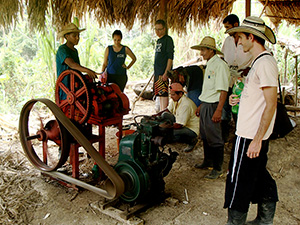 While FOR Peace Presence and other human rights organizations use the term to reference a specific set of protective tactics, other activists broaden its meaning to different kinds of solidarity work. In 2012, for example, U.S. labor and prisoner rights lawyer Staughton Lynd wrote an impassioned book—part memoir, part treatise—entitled Accompanying: Pathways To Social Justice. His central claim is that accompaniment, with its emphasis on humans collaborating as equals, provides an urgently needed corrective to long prevalent notions of “organizing” in North American social justice traditions. Lynd opens his book with an analysis of Dr. Paul Farmer’s well circulated 2011 commencement address at Harvard’s Kennedy School of Government—“Accompaniment as Policy”—wherein Farmer, the world-renowned founder of Partners in Health, describes his understanding of the term. Farmer’s insights stems from decades of observing development projects, some of which have failed miserably, worsening people’s lives through “unintended consequences of social action.”
While FOR Peace Presence and other human rights organizations use the term to reference a specific set of protective tactics, other activists broaden its meaning to different kinds of solidarity work. In 2012, for example, U.S. labor and prisoner rights lawyer Staughton Lynd wrote an impassioned book—part memoir, part treatise—entitled Accompanying: Pathways To Social Justice. His central claim is that accompaniment, with its emphasis on humans collaborating as equals, provides an urgently needed corrective to long prevalent notions of “organizing” in North American social justice traditions. Lynd opens his book with an analysis of Dr. Paul Farmer’s well circulated 2011 commencement address at Harvard’s Kennedy School of Government—“Accompaniment as Policy”—wherein Farmer, the world-renowned founder of Partners in Health, describes his understanding of the term. Farmer’s insights stems from decades of observing development projects, some of which have failed miserably, worsening people’s lives through “unintended consequences of social action.”
For Farmer, accompaniment is an inspiring corrective because it demands a certain kind of accountability defined both by its endurance and its humility. “I’ll go with you and support you on your journey wherever it leads,” he says of the practice. “I’ll keep you company and share your fate for a while. And by ‘a while,’ I don’t mean a little while. Accompaniment is much more often about sticking with a task until it’s deemed completed by the person or people being accompanied, rather than by the accompagnateur.” This last line foregrounds how accompaniment, as a mode of comporting oneself in social justice work, compels a specific approach to evaluating the success of our actions: those who seek to help should not serve as the measurer or the measurement tool for what is working.
As I sit in my UC Berkeley office, listening intently over Skype to Kaya Allan Sugerman share her stories from northern Colombia, thinking about their relationship to the ideas of Lynd and Farmer, I am struck by the relevance of accompaniment to the challenge of social justice.
At its most elemental level, the yearning for a more socially just world presents two problems: what and how? What is the particular vision of social justice? How to go about working toward that vision? Answers to these questions dramatically affected world events throughout the 20th century, and any current effort to advance struggles for social justice should grapple with these complex legacies and sustain these questions. Accompaniment offers a particular way into and a particular way forward for both the what and the how of social justice.
Listening, walking hand-in-hand, these are the practice.
I thank Kaya Allan Sugerman ‘12 for speaking with me; any errors in understanding or analysis are mine alone. The Global Poverty & Practice minor at UC Berkeley creates an educational community for student scholar-activists committed to exploring the difficult ethical and political questions necessary for building social justice in the 21st century.
How to Attract Female Engineers (New York Times Op-Ed by Blum Center Director of Innovation Lina Nilsson)
More Than Hardware: Challenges in Education Technology in Africa
By Sybil Lewis
In 2012, the Inter-American Development Bank concluded that children in Peru receiving computers from the American nonprofit One Laptop per Child did not show improvements in math or reading and that access to the laptop did not significantly increase motivation to learn. This is the kind of survey result that makes technology for development professionals worry—especially since global education technology investments were estimated at $1.1 billion in 2012. In Rwanda alone, 203,000 laptops have been distributed to primary school students through the One Laptop per Child project.
On April 10, the Blum Center hosted a panel discussion on the private sector’s changing and often challenging role in education transformation in Africa. The panel was organized and moderated by James Bernard, senior director of global strategic partnerships for the Education Group at Microsoft and a Spring 2015 Development Impact Lab (DIL) visiting fellow. The panel included John Galvin, vice president of education at Intel; Steve Duggan, director of education partnerships at Microsoft; Sara Kingsley, research consultant at the Microsoft Technology and Policy Group; and Alex Cho, vice president and general manager of commercial systems at HP.
First, all of the panelists emphasized that there has been a shift in the past five years away from providing countries with laptops or devices toward context-specific solutions focusing on educational outcomes.
“The focus has moved from the device to thinking about the appropriate solution and service that will provide outcomes,” said Duggan of Microsoft. “So you can think of the technology not as the end-all, but as a device that delivers a service.”
Indeed, to address the shortcomings of device-only solutions, computer hardware companies are including software development and teacher and IT training into their hardware deployment projects in African and other developing countries. In 2012, for example, Microsoft invested $250 million through its Partners in Learning Project to train teachers in IT and technology subjects.
The panelists explained that one of the biggest challenges in the education technology field has been implementing curricula when government officials are more interested in the quantity of devices sent to students. Another challenge is the lack of reliable Internet connectivity in many African regions, a problem that moved Microsoft, Intel, and HP to place its educational content on USB devices with a 3G connection, so that teachers can provide an alternative way to download information. Africa’s connectivity is changing, however, said Kingsley, who works on affordable connectivity projects for Microsoft in Africa. He reminded the panel that many Internet Service Providers and governments are harnessing the power of solar energy throughout the continent.
While “adaptive learning,” which allows teachers and students to learn at their own pace through online resources, has produced positive results, the role of technology in the classroom remains unclear. The panelists attributed this ambiguity to the lack of data and rigorous assessment.
Alex Cho from HP said that the collection of real-time data from student and teacher interactions with devices and software along with on-the-ground qualitative data allows developers to track where success and failure is occurring, with the potential of creating predictive data. According to Duggan, the fact that only one third of countries have met the UN’s 2015 Millennium Development Goals on education highlights technology’s potential to offer more solutions.
The educational ecosystem in sub-Saharan Africa is complicated by resource challenges. A recent UNESCO report estimated that by 2030 2.5 million teachers will be needed to meet growing secondary school enrollment. Teachers and human interaction will always be essential to learning, Bernard assured, but technological innovations can serve as a guide to navigate a landscape lacking quality teachers.
“We need to look at technology from the framework where it is a compliment, not a replacement, to education in places where resources are running short,” Kingsley said.
The Road from CalCAP: Can the University of California Achieve Carbon Neutrality by 2025?
By Tamara Straus
Ten years ago, Scott Zimmermann left a career as an oil industry engineer to attend law school at UC Berkeley, retool, and try to save the planet. Al Gore’s “An Inconvenient Truth” was just about to come out, and the nation was buzzing with newfound information on the connections between fossil fuel consumption and climate change. Zimmermann said he chose Berkeley because “it was easily the best place in the country for people working on interdisciplinary climate mitigation solutions, especially in the energy space. Virtually every department across campus was making important contributions to climate change research.”
Zimmermann took some good early steps. First, he got Professor Daniel Kammen to serve as his advisor. Kammen had a triple appointment at the Goldman School of Public Policy, the Energy & Resources Group, and the Nuclear Engineering Department, and recently had been named Class of 1935 Distinguished Chair in Energy and co-director of the Berkeley Institute of the Environment. He was also about to win the Nobel Peace Prize as a contributing lead to the Intergovernmental Panel on Climate Change.
Second, Zimmermann met a Berkeley attorney and activist by the name of Tom Kelly. In 2004, Kelly and his wife Jane had started Kyoto USA, a nonprofit to get local jurisdictions to abide to the carbon caps laid out in the Kyoto Protocol. Kelly wanted to institute the caps that the U.S. government wouldn’t at UC Berkeley, and according to Zimmermann, “It fit really, really well within the university and its politics.”
The state also was moving where the federal government refused on climate change policy. California Assembly Member Fran Pavley presented AB32, which would soon become the 2006 California Global Warming Act, the first law of its kind in the country. It would require California to reduce its greenhouse gas emissions to 1990 levels by 2020.
Kammen, Zimmermann, Kelly, and two other graduate students from the College of Natural Resources—Brooke Owyang and Eli Yewdall—decided that the UC Berkeley should commit to the same reductions and, if possible, get ahead of them to prove the university’s leadership in environmental sustainability. They drafted a letter to Chancellor Robert Birgeneau, gathered signatures from 13 professors, lecturers, and deans as well as from Professor Cathy Koshland, vice provost for academic planning and facilities, and requested that the administration “formally endorse the Kyoto Protocol and adopt its underlying principles.” The administration replied with a challenge: to put together a feasibility plan.
“Getting a university to commit to and administrate this kind of goal is not just a really interesting political problem,” remembers Zimmermann. “It’s also a really interesting technical problem.” The first technical problem was quantifying the actual on-campus emissions and understanding them in terms of transportation, consumption, waste, electricity, and so on. The second problem was figuring out how to reduce the emissions through technology, behavior, and other methods.
To tackle these problems, a student-faculty-staff group called the Cal Climate Action Partnership (CalCAP) was formed. As usual, money was scarce. Zimmermann and fellow students Brooke Owang, Sasha Gennet, and Sam Arons applied for a BigIdeas@Berkeley prize and won $5,000, enough to pay a student group to measure the campus’ carbon footprint. Student oversight came from Kammen, Civil and Environmental Engineering Professor Arpad Horvath, Energy & Resources Group Chair William Nazaroff, and 10 other faculty, all of whom were doing cutting-edge work on emissions analysis and technology. Fahmida Ahmed, a recent graduate of UC Santa Barbara’s environmental science and management program, was hired to manage the process. And for 18 months, momentum grew. There were large department and school head meetings, and many hours volunteered from every corner of the campus.
By the spring of 2007, CalCAP was done with its reporting and placed a 117-page plan on the desk of Chancellor Robert J. Birgeneau. He signed it, even though Nathan Brostrom, the vice chancellor of administration, didn’t know where about half the money was going to come from.
“This was one of the most collaborative efforts of students, faculty, and staff I’ve ever seen or been involved in,” remembers Koshland. “It happened because we had a multi-pronged strategy and an amazing group of graduate students who led the charge.”
Koshland went on to chair the CalCAP steering committee, comprised of a 35-member group and overseen by the UC Berkeley Office of Sustainability & Energy. In its first few years, CalCAP produced detailed reports on the path to meet carbon reduction goals and the mechanisms to report the emissions, including the 2009 Sustainability Plan and Climate Action Plan. The efforts led to hundreds of projects across campus on energy efficiency, transportation, procurement, water, and travel. And at each stage, the projects were individually evaluated for feasibility and measured for goal completion.
Kira Stoll, who became involved in CalCAP in 2006 as transportation staff and is now the campus’ sustainability manager, said that one of the largest efforts has focused on buildings, which account for 39 percent of C02 emissions in the United States. There were plenty of surprises. For example, Stoll and her colleagues originally assumed that there wouldn’t be much financial payback from lighting retrofits. “But what we found through tracking those projects,” says Stoll, “is that we were getting 60 percent faster better payback.”
In 2012, the Office of Sustainability launched the Energy Management Initiative, including a campaign called My Power. My Power is a simple behavioral program that has incentivized Cal departments to reduce emissions by showing them detailed reports of how much energy they use—and then giving them money back, if they go below specific targets. Stoll reports that the Energy Management Initiative has saved UC Berkeley more than $2 million since it was launched.
Also part of the Energy Management Initiative is a platform called Energy Office, which aggregates 100 real-time energy dashboards that change on 15-minute intervals. In 2012, Assistant Professor Duncan Callaway and his class noticed an inexplicable bump up of energy use on Barrows Hall’s dashboard, and notified the Energy Office. Stoll says her colleagues used the dashboard software to sort through possible causes of the increased use. They quickly found an equipment problem, went to the building, and resolved it. The avoided annual energy costs to Cal were up to $45,000.
By November 2013, UC Berkeley announced it had reduced its carbon footprint to 1990 levels. The CalCAP-initiated goal was met two years ahead of schedule and beat the state the deadline by eight years. Because of its data management, CalCAP knew exactly how and why goals were met. It gave three main reasons. First, through energy efficiency investments, building retrofits, and sustainable transportation practices, the university saved 20 million kilowatt hours of electricity and 1 million gallons of fuel. Second, Pacific Gas & Electric, which provides the campus electricity and is required by state law to provide 33 percent renewable energy mix by 2020, helped out in reducing emissions as it began to replace coal and oil with wind and sun energy. And third, and perhaps most instructive, reductions came through improved data and reporting methods.
“This shows that if you don’t measure it, it’s incredibly hard not only to act on it but to have a substantive conversation,” says Kammen. “You really need to have targets and goals. Setting them—doing the analysis to figure them out, and then doing the measurement work and adjusting—is what CalCAP has proved.”
Kammen is speaking not just about UC Berkeley’s first set of carbon emissions goals—but about the next set of goals, which UC President Janet Napolitano announced in November 2013. They demand that the entire University of California system commit to carbon neutrality by 2025.
Matt St. Clair, who was part of the original CalCAP team and who in 2004 became the first sustainability director for the University of California’s Office of the President, believes the goals are reachable but there are plenty of challenges ahead. “Energy efficiency is hard work and complex and requires investment,” says St. Clair. “We’ve done a lot of it, and we plan to do a lot more. We also don’t want to rely just on supply side solutions, where we use as much energy as we want because we can directly procure carbon-free sources of energy. That’s a big, ongoing challenge.”
Both St. Clair and Stoll say that UC Berkeley reached its first carbon reduction goals in part by grabbing at low-hanging fruit: cost-effective methods that were as dependent on behavioral changes as much as on new technologies. What the University of California needs now, they say, is financial investment and continued ingenuity.
“We really need to find a way to finance new renewable energy initiatives,” says Stoll. “The technology is available, so it’s feasible if we can find the finances for it and do it in a 10-year time frame.”
Stoll mentions that Stanford University is about to finish a $438 million electric heat recovery system to replace its cogeneration plant. The new Stanford Energy Systems Innovation project is expected to reduce carbon emissions by 68 percent and save the university an estimated $300 million over the next 35 years. Of course, these kinds of upfront costs are not something the University of California can contemplate in the midst of the budget crisis.
Stoll and St. Clair say there are other tactics UC might employ, including purchasing more solar and wind power from energy wholesalers and developing a biomethane substitute for natural gas.
“What’s exciting about a system-wide carbon neutrality policy and office of sustainability,” says St. Clair, “is that each campus has its own strengths that the others can learn from.”
St. Clair notes that Berkeley was the first to do a climate action plan, which his office used to help the other nine campuses develop their own plans. Whereas, UC Santa Barbara pioneered green building efforts with the country’s first Platinum LEED certified building, and UC Irvine developed a smart laboratory program, through which it has retrofitted more than a dozen laboratory buildings and cut energy consumption in those buildings by on average 60 percent, becoming a national and international model.
This year, Costa Rica became the first nation to use only clean energy. The country’s state utility company announced in late March that it went the first 75 days of 2015 without using fossil fuels like coal or oil for electricity, and expects to rely on renewable energy for more than 95 percent of its electricity for the remainder of the year.
Can the University of California one-up this hydropower-reliant country and achieve carbon neutrality by 2025? For many involved, it’s the ultimate hot potato question. Daniel Kammen, however, says the answer is “unambiguously yes.”
“It sounds like a revolutionary number to make the energy system carbon free by 2025,” says Kammen. “But if the UC system can really innovate and use its physical campuses as living laboratories, I think it’s absolutely doable. What it will take is a scale-up in efficiency—solar, wind, biomass, geothermal—that we have been talking about for a while. Ten years is an incredibly tight timetable. It makes you gasp a little. But we’ve seen these transitions happen on this scale already.”
Scott Zimmermann, Kammen’s former student who is now an energy lawyer at the San Francisco firm of Wilson Sonsini Goodrich & Rosati, argues that getting to carbon neutrality is a bigger step. “It’s not something you can necessarily do while saving money,” he says. “The earlier steps at UC Berkeley were easier because they enabled departments to save money. Now, if there’s extra money, the question is: Do you put the money into carbon reducing facilities or hire another professor? Those decisions are harder to make.”
A Pattern Searcher from Cal: Rebecca Hui Connects Art, Cows, and Urban Development
By Sybil Lewis
During her sophomore year, Rebecca Hui was still wrestling with her decision not to attend art school—and was tepidly observing her fellow students’ focus on professional careers. Through a friend, the double major in architecture and business got an internship at a landscape architecture firm in Gujarat, India. But her boss refused to let her work; instead, he encouraged her to delve into Indian culture and discover what intrigued her.
Hui decided to follow around cows.
“I was shocked by how much respect cows received in the city—they were like a bourgeoisie,” Hui said. “I wanted to know why I had trouble crossing the road, but all the cars stopped for a cow.”
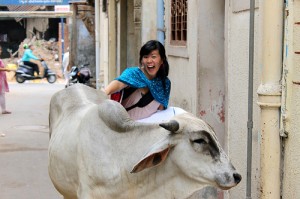
In Hinduism, the cow is considered a sacred animal; and in many areas, such as Gujarat, vegetarianism is the norm. Hui’s interest in human-animal interactions was influenced by her roommate, an adherent of Jain, an ancient Indian religion that advocates a high social consciousness toward animals. Her roommate allowed pigeons to live in their home.
“She would say, ‘If we build our houses on their houses, why can’t they build their houses in ours?’ It became normal to wake up with pigeons flying around my room.”
After her summer in Gujarat, Hui decided to switch her second major from architecture to urban studies and to apply for the BigIdeas@Berkeley competition in the Creative Expression for Social Justice category. She won $3,000, enough to start her project.
The Secret Life of Urban Animals is not a typical BigIdeas project. Hui followed cows in different parts of India to better understand their cultural significance as well as urban planning and sustainable development in the world’s most populous democracy. Upon graduation, she received sponsorship to continue the project as a Fulbright-Nehru Research Fellow and National Geographic Society Young Explorer.
Hui wrote in a July 2011 blog entry: “a system’s state can be understood by observing how molecules bounce around in its environment. I figured that in the same way, much can be revealed about the state of a changing society by following how its inhabitants, a cow in this case, ‘bounce’ around its surroundings. Who knew that following a cow could reveal so much about the city’s changing cultural, social, and even political fabric?”
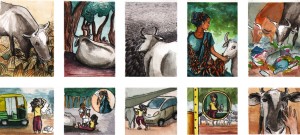
Following cows in the densely populated city of Mumbai, Hui noted that people’s relationship to cows varied immensely between rural and urban areas. In rural areas, cows are integrated in everyday life and play an important role as sources of milk and farm labor; they are treated with more familiarity compared to more urban settings, where they are mainly used for commercial activities and in some cases face physical harm from people.
Hui has argued that protection of urban animals and wildlife can strengthen urban planning and public policy. As an expansion of her project, she attempted to study elephants in Tamil Nadu and leopards in Mumbai’s Sanjay Gandhi National Park, and noticed that that bureaucracy or real estate interests were often prioritized over conservation. If the elephants’ migration patterns were accounted for, she argued, then city planners could create grassy overpasses and roadways to protect wildlife, while still developing for larger human populations.
Some may see this line of reasoning as overly idealistic, especially since India is projected to replace China as the world’s most populous country by 2050. While Hui does not advocate for cows and other animals to roam freely in cities due to the health concerns, she argues that taking into consideration human-animal interactions is imperative to preserving ecosystems that humans benefit from.
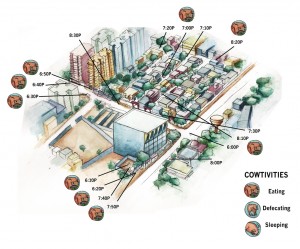 |
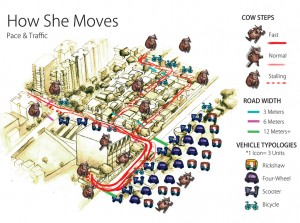 |
|
Maps that Hui drew to document how cows inhabited the city and dealt with different urban realities such as traffic. |
|
Hui admits she has never been a conventional thinker. As part of an independent research project her junior year, she decided to observe how different groups interact with Legos. She left the sets in public areas at the Haas Business School, the university’s architecture building, Wurster Hall, and a local elementary school. She found that the Legos at the business school were built into hierarchical structures, such as pyramids; the architecture students tended to make intricate designs, including Star Wars figurines; and the most creative structures came from the elementary school children.
In her undergraduate classes, Hui often put a twist on her assignments. For the business course Entrepreneurship to Address Global Poverty, her goal was to get the Cal student community more aware of social entrepreneurship opportunities on campus. The end result was a series of illustrations of an octopus, whose tentacles served as a metaphor for the reach of different social entrepreneurship opportunities.
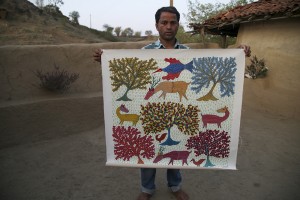
“When she first came back with the octopus drawing, I chuckled and did not understand it,” said the course’s professor John Danner. “But the end result was much better than the original idea—she has an idiosyncratic way of putting ideas and issues together that stop people in their tracks.”
Hui just likes to search for patterns in human development and thinks that her ability to notice subtle differences in societies stem from her upbringing. Her father was a professor and during his sabbatical leave Hui moved around nine times as a child between Hong Kong, New Jersey, and Arizona, and said she learned to adapt quickly in order to “fit in.”
While the Secret Life of Urban Animals project concluded in September 2014 with a two-week exhibition of Hui’s paintings, drawings, and cartoons at the David Sassoon Library in downtown Mumbai, Hui’s work in India is far from over.
Currently, she is working to found Toto Express, a social enterprise that she says is the first design-licensing agency for rural artisans in India. During the Secret Life project, Hui met many rural artisans whom she learned were unable to generate enough income due to lack of connectivity and marketing. When they migrated to urban areas in search of employment, they ended up encountering a different form of poverty in the slums.
Hui believes it is important to create alternatives to urban migration—what she calls a “prosperous village” that can recognize villagers’ inherent skills and assets. Over eight months in 2014 and 2015, she has conducted three pilot projects with tribes specializing in the traditional art forms of Dhokra metal casting, Phad scroll painting, and Gond painting. She intends to get artisans to upload their designs to an online platform for licensing by corporations.
The platform will capitalize on the estimated $2.5 billion market of holiday gift giving by corporations and a 2014 law requiring that 2 percent of corporate budgets be allocated to corporate social responsibility. Hui hopes that Toto Express’ platform will provide a way for corporations both to meet their gifting needs and meet government mandates. In turn, artisans will benefit from growing profits that will allow them to stay in their trade and village.
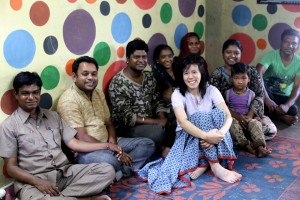
“Many NGOs and craft ventures work with these artists, which is fantastic, but it seems they are often harrowed by supply chain and inventory challenges,” Hui said. “Toto Express increases artists’ incomes without having to send the artwork or artist to urban areas—which usually adds more layers to the supply chain, reducing the actual cash that artists receive.”
Moving forward, Hui is planning a fourth pilot project that would place permanent design centers in three to four villages, to help artists adapt their artwork for various corporate gifts and better use the Toto website.
“I am dedicated to this project because I relate to artists whose reasons for leaving their art spoke back to my reasons for pursuing a more ‘respected’ career path within the often risk-adverse Chinese American community,” Hui said. “But to see that happen to these communities where art is intimately connected to identity, hurt tremendously. I want to change that.”
Down to the Wire on Big Ideas@Berkeley’s IT for Society Competition
By Andrea Guzman
On April 10, the seven finalist teams in the Information Technology for Society category of this year’s Big Ideas@Berkeley social innovation contest went through the nail-biting process of presenting their projects to a panel of judges at Sutardja Dai Hall.
Finalists included: Piezoelectric Shoe Sole GPS Tracker, a low-cost, ergonomic children’s shoe design with an embedded data logger powered by piezoelectric materials; BCAPI, an open-source Brain-to-Computer Interfacing software for creation of assistive technologies; and TIRO, an interactive hotline management system designed to give small NGOs serving vulnerable clients in China better record-keeping and reporting capabilities. Also presenting were the Smart Diaphragm group, which aims to detect vaginal infections in pregnant women, and Lifenik, which creates games that help kids develop their brains for optimal emotional health.
Sponsored by the Center for Information Technology Research in the Interest of Society (CITRIS) and the Blum Center for Developing Economies, the IT for Society category challenges students to develop a project that demonstrates the capacity of information technology to address major societal challenges. Past winners have included: Transence, a mobile application enabling hard-of-hearing people to interact more freely with the rest of the world; and Sahay, an information and communication technology platform connecting workers in the informal household sector (e.g., domestic workers, cooks, drivers, security guards, etc.) in India with employment opportunities.
Among this year’s contestants was Team Aqua Power, which is designing a water measurement device to be installed on faucets and showers, to make people more conscience of their water consumption. Thuria Narayan said the yearlong competition allowed her team to further develop their idea, particularly with help from their mentor. “Our mentor helped us in the areas that we lacked,” she said.
For Shyam Kumar of OhMyCause!, a web platform that connects people with causes and nonprofits, BigIdeas@Berkeley motivated him to just start the project. “Big Ideas is a great channel for people to take their ideas to the next level,” he said. “Without it, people may choose to focus on something less socially driven. The contest really brings out the best in us.”
The judges in the competition seemed impressed with the quality and maturity of the proposals. “It is great to see university students not just think about these problems but to have the courage to go forward with them,” said judge Jayarami Reddy from Cisco.
Awards will be announced in mid April, with $22,500 in prizes for the Information Technology for Society winners. Awards for all categories will be celebrated on May 5, 2015, 2-4 pm, in B100 Blum Hall.
The Measurement Revolution: An Interview with Temina Madon
By Tamara Straus
 Temina Madon is executive director of UC Berkeley’s Center for Effective Global Action (CEGA), whose mission is to improve lives through innovative research that drives effective policy and development programming. Madon also serves as the managing director of UC Berkeley’s Development Impact Lab, which CEGA and the Blum Center co-administer. She has worked as a science policy advisor for the Fogarty International Center of the National Institutes of Health and as a Science and Technology Policy Fellow for the U.S. Senate Committee on Health, Education, Labor and Pensions. She holds a PhD from UC Berkeley in visual neuroscience and a BS in chemical engineering and biomedical engineering from MIT. The Blum Center sat down with Madon to gather her views on impact evaluation, technology for development, and the changing intersections of development economics, engineering, and social science.
Temina Madon is executive director of UC Berkeley’s Center for Effective Global Action (CEGA), whose mission is to improve lives through innovative research that drives effective policy and development programming. Madon also serves as the managing director of UC Berkeley’s Development Impact Lab, which CEGA and the Blum Center co-administer. She has worked as a science policy advisor for the Fogarty International Center of the National Institutes of Health and as a Science and Technology Policy Fellow for the U.S. Senate Committee on Health, Education, Labor and Pensions. She holds a PhD from UC Berkeley in visual neuroscience and a BS in chemical engineering and biomedical engineering from MIT. The Blum Center sat down with Madon to gather her views on impact evaluation, technology for development, and the changing intersections of development economics, engineering, and social science.
Impact evaluation has become extremely important to the field of international development, but many complain that funding is still difficult to come by. What do you think about this disconnect?
Temina Madon: William Savedoff of the Center for Global Development and Ruth Levine from the Hewlett Foundation recently wrote that approximately $130 billion is spent each year in official overseas development assistance, compared to about $50 million for evidence—i.e., for rigorous evaluation of programs. That’s less than one percent. Would any private sector company that is serious about its products spend that little on R&D? If you look at Google, Intel, and the companies that deliver the services we use everyday to enhance productivity, they are spending 15 to 20 percent of their revenue on product development. I’m not saying that government operates in the same way as the private sector, nor should it. But you would think that for the delivery of essential public services that safeguard people’s health, livelihoods, and basic security, more than 1 percent would be spent on product development and evaluation.
What would it take to get the pace of investment in evidence to where it should be?
Temina Madon: I think it would take a wholesale shift in the attitude of governments away from process and consensus, toward performance—toward delivery of services that actually improve people’s health, their security, and their workforce readiness and education. Bureaucrats need to be incentivized to deliver outcomes, not programs.
What do you say to people who don’t understand impact evaluation or the cost of rigorous program evaluation?
Temina Madon: First, some programs are actually harmful, just as some drugs tested in clinical trials prove to be harmful. For example, there are programs that try to put money and empowerment into the hands of women, but sometimes they can drive negative outcomes, related to domestic violence and inter-household conflict. These kinds of programs, while very much intending to empower women, can put them at greater risk, if not implemented appropriately. You want research, evidence, and careful design of services to ensure they are implemented in ways that do no harm.
There are also many programs that have no impact. So there is an imperative to allocate money to high performance programs. We like to say that the public has, in some ways, a relatively unenforceable contract with government. We vote for politicians—essentially entering into a contract with our leaders to deliver services that keep our society functioning. But that contract cannot be enforced on a regular basis, because we vote only once in four to five years. A good government, ideally, is accountable day-to-day for the performance of public services. So it is a breach of contract when elected officials allocate resources to harmful or low-impact programs. If you have limited resources, you are supposed to invest in proven, evidence-based policies or programs. This is how you fulfill your contract with the people. Of course, we need a way to identify the highest performing programs—and that’s where rigorous evaluation is needed.
To what extent can international development efforts in the U.S. be separated from U.S. foreign policy interests?
Temina Madon: I honestly don’t know the answer to this question. But I know that USAID has tried to pivot under the current administration, away from implementing programs that are “business as usual” and more toward knowledge generation. In other words, how do we contribute knowledge that helps governments in poor countries perform more efficiently? Knowledge can be in the form of scientific advances and technologies, evidence that governments can use, and even capacity building. It is a pivot away from providing commodities for consumption, like surplus grain (during famine) or condoms to prevent HIV. We are starting to equip governments and communities to increase their resilience, improve their public service delivery, and adopt new technology. I don’t know if you can ever separate foreign assistance from foreign policy objectives. USAID reports to the Department of State. But under this administration, there has been a movement toward more knowledge sharing, technology transfer, technology development, and investment in product and service design.
Is that the right way to go? Intrinsically, as an American citizen, I prefer that we give the best that our country has to offer. U.S. overseas assistance should not be a channel for dumping surplus. As a citizen, I’d prefer that we contribute our innovation, our knowledge and management skills. We have this rich human capital; I love the idea of helping Americans to do good in the world, by connecting with opportunities to transform economies.
CEGA is among a handful of university centers experimenting with wireless sensors, mobile data, and analytics to evaluate poverty-alleviating programs. Do you do see a time when one or more of these approaches will become primary or replace randomized control trials in impact evaluation?
Temina Madon: We see these innovations as tools for measurement in impact evaluation. Rigorous evaluations just expose the causal links between programs and outcomes. We’ll always need this approach. But how you measure your outcomes, in large part, determines the cost of an impact evaluation.
Often, evaluations are expensive, because you are doing thousands of pen-and-paper surveys. You may have to hire hundreds of enumerators to carry out two-to-three hour interviews with representative households across multiple villages, districts, and regions. You have to pay fuel and housing costs for the enumerators when they travel. If you’re measuring biometric outcomes, your surveyors need to be well trained. They may even need to be certified health workers; it depends on the tests you’re administering. You may have to pay for the rapid transport of diagnostic tests to a laboratory. This is where the high cost comes from.
If we can shift toward mobile phone surveys and wireless sensors, the costs could drop dramatically. We just need to know that newer methods are as reliable and accurate as door-to-door surveys.
Again, impact evaluations just compare the outcomes—of people, or communities, or markets—in the presence and absence of a program. But they’re also a way to give a voice to poor and vulnerable households, to allow them to express whether or not a program has worked for them. If we capture this input using sensors, mobile technology, satellites—it is still impact evaluation. We’ll still be looking for causal link between the intervention and its impact, but the technologies reduce the cost of gathering the data. They make it easier to understand the lives, outcomes, and aspirations of the people we care about.
Give me an example from either UC Berkeley or another university of where new technologies are effectively helping to evaluate development programs?
Temina Madon: One of the projects supported by the Development Impact Lab (DIL) is trying to expose use of improved cookstoves by women in Ethiopia. The stoves reduce biomass consumption and, with it, health risks from pollution. The question is what kind of educational or marketing interventions could get women to use the stoves. This project started with simple pen-and-paper interviews with women to ask about their stove use—a method that is costly and quite unreliable and biased. If you ask me whether I use your excellent new stove, I’ll probably say, “Yes!”
DIL supported a group of researchers to put temperature sensors on the stoves, in order to gather reliable, high frequency data on stove use. Sensors could lower the cost of evaluation significantly, given the amount of data and the quality of data being captured. The team started to use tablet-based surveys running ODK (Open Data Kit), and then benchmarked their survey data against the sensors, to understand the reliability of each approach. There is an upfront cost for benchmarking a new technology, and you are going to see that with all these emerging measurement technologies.
CEGA is funding another project that is looking at crop yields among smallholder farmers in Kenya and Uganda. Currently, when you send enumerators out to measure crop yields in a region, you take a random strip of a farm plot, cut or harvest the produce in that strip, and then estimate what the rest of the plot will yield. This is incredibly costly. We are trying to do that now with microsatellite data. Very soon, microsatellite operators expect to get optical images, updated daily, of landmass for practically the entire planet. We think we can infer crop yields on very small plots using this high resolution, high frequency data that give time slices throughout the harvest cycle. Crop yields in the context of agriculture are something development economists really care about, because we think they generate increases in income for poor households.
Another new measurement approach is crowdsourcing. Premise is a tech company in San Francisco that CEGA is working with. Premise maintains a network of community members equipped with smartphones, all over the world. The company pushes customized tasks to the smartphone user, such as: identify where there is scarcity in consumable water in your neighborhood; or take a picture of houses that lack connection to the grid within 2 kilometers of your house. Premise gets the images, which are location- and time-stamped, and pays the contributors for every accepted observation. Premise is then able to produce real-time aggregate information. They can create consumer price indexes by capturing, for example, food prices from 60 markets across a district. To spur development, we can then intervene in half of those markets, and see how market prices change. This is an impact evaluation—a randomized trial control trial. But instead of sending enumerators out to measure outcomes, we are doing low-cost data collection using a new technology.
This is why we see the measurement agenda as essential, but also complementary, to surveys. You’re not ever going to want to get rid of surveys wholesale, because even if they introduce bias, you’re gaining beneficiaries’ perceptions. What beneficiaries tell you may not be the actual reflection of their behavior—but you may want to know what they think and say. Also, with satellites and sensors, you may not be able to capture as much information as you would with a survey. So we see these technologies as complementary and as tools that could be embedded within an impact evaluation.
What is the skill set for people going into economic development?
Temina Madon: The bottom line is that very few people have all the skills needed, and this is why we are taking a “team science” approach. We are helping to create a new discipline, development engineering. In this new field, you can’t be an economist working alone. You might need a computer scientist, an electrical engineer, a mechanical engineer, and other social scientists to work with you on the measurement component of your research. There is a fertile territory for measurement advances that engineers can contribute to and get credit for, because real innovation is required to sense physical properties or to observe trends in the field.
There are a few people who have been able to cross disciplines. In fact, this is where we got the idea for the development engineering as a PhD minor. Joshua Blumenstock was a Cal PhD student in computer science who is now an assistant professor at University of Washington. He got his PhD in the Information School, but he also did a master’s in development economics. He took the core econ courses, because he was interested. So he has the engineering insights to build systems for “big data” analytics, but he also understands econometrics and he can tease out the causal linkages between interventions and their impacts. He can leverage new measurement tools, like the call detail records (CDRs) that are generated by mobile network operators. Right now, there is another UC Berkeley student in the I-School, Robert On, who is building this same hybrid skill set.
What other skills might students gain if development engineering were to blossom?
Temina Madon: There are a lot of people with a lot of opinions on this question. But the whole idea for “development engineering” came up in a discussion with Eric Brewer and Ted Miguel. We were saying: Josh Blumenstock has these unique abilities, and can tackle unique problems, because of the methods he has been exposed to. How could we create more students like him, who will know how to work with someone from a different academic tradition? We started thinking that the obvious first step is knowing what you don’t know—understanding enough development and economic theory to know that there is a body of statistical and data collection techniques that you could tap into, through collaboration. That is one piece.
The other piece is knowing how to do fieldwork. Eric Brewer’s concern was that while engineers have become “interventionists” in the ICTD [information and communication technologies for development] community, they don’t understand how to access representative, population-level data to inform their work. They are doing focus groups. But when your technology’s design is informed by a small number of focus groups, the technology is designed for that population. It’s not necessarily scalable, or representative of something that could scale. So we need to teach people how to do field experiments, impact evaluations. We need to teach about the political economy of technology, the regulatory institutions that play a role in scale-up, and how to bundle those into the design of a technology intervention.
The flip side is that for an economist, you need to know the body of technologies that exist. You may not have the modeling or hardware skills to build sensors, deploy a network, and then analyze the data. But you should at least know about the toolkit that is emerging, so that you can think more creatively about measuring outcomes in the field. So again, knowledge about new approaches outside your own discipline is so important.
What do you make of the conversations in the popular press about women in science, both in higher education and industry?
Temina Madon: I have been fortunate to grow up in a household where women are expected to be scientists and engineers. Yet I did not become a faculty member, because I did not have that desire in the discipline in which I was trained: visual neuroscience. A lot of people say women tend to seek work that has more social impact or social relevance. I don’t know if that is true or not. But it is true for me, personally. It was a big pivot in my career to move toward work that was more applied. I think “development engineering” gives an avenue for women in quantitative sciences and engineering—fields where they tend to be underrepresented—to find social impact in their research. We think development engineering is promising in that regard. But honestly, if you look at economics and engineering, the lack female role models at the level of faculty is a pervasive problem. It is even harder for women in developing countries. A lot of our collaborators in developing countries are male, because those are the people who have risen in their universities. We have very few female research partners in developing countries.
Can you tell me a little more about your upbringing? Did you come from academics?
Temina Madon: I grew up in California. My parents are chemists; my mom ended up going into medicine, but my dad was in the “biotech revolution.” It is funny to me that I ended up working with a bunch of social scientists. CEGA is interdisciplinary, but 40 percent of our affiliates are economists and social scientists. We say we are trying to be a Bell Labs for development. I find it strange that I have migrated toward social sciences, because my family is biased towards science and engineering. My grandfather was an electronics engineer. He is Indian, and worked after Independence on building India’s engineering capacity, bringing radar into the country. He initially started in the military, and then went into the energy sector, but he was constantly pushing tech transfer, seeing the transformation of the country through its adoption of technology and infrastructure. He brought a real focus on technology as a driver of development into our family’s values.
Neuroscience and mental health are among your areas of expertise. Would you talk about your interest in those disciplines?
Temina Madon: My background was in neuroscience and that was an intellectual interest. When I was a grad student, my partner died from suicide—and that, in large ways, pivoted me toward mental health policy. I used my background in neuroscience to understand and explore the biological mechanisms responsible for depression, bipolar disorder, suicidality. I looked at the prevention tools we have. It turns out, there are very few. There is relatively little rigorous public health research on mental illness prevention, or even treatment. There are very few randomized trials. There is a lot of observational work and demonstration projects, but there is very little evaluation of community interventions to prevent suicide, or even innovation in how to measure suicide.
What trends in your field make you most hopeful?
Temina Madon: In his annual letter two years ago, Bill Gates talked about measurement. He said you can’t fix something until you have measured the problem; and you can’t even perceive something as a problem or an opportunity until you’ve measured it. I, too, am excited about the measurement agenda. I feel like so many things in our lives today are instrumented—from the web browsers we use, to our mobile phones, the GPS on our phones, the Fitbits we are wearing, and the sensors in our cars and homes. There is so much being measured, and it has created such a rich data environment. Yet much of the rest of the world is still invisible. There is very little measurement in poor communities. If you can’t record someone’s existence, if you can’t capture their life and death, their aspirations or communities’ needs—then you can’t know how to approach shared challenges with ingenuity, innovation, and intervention.
I feel like there will be a real blossoming in economic and social development with better ability to measure outcomes. But again, benchmarking is going to be important. If you are going to use new kinds of information, measurement, and data for policy intervention or program design, or to monitor and keep governments accountable, there is a lot of work to prove to ourselves that our new measurement tools are as reliable as the current gold standard.
Microsoft’s James Bernard on the Intersection of Education, Technology, and Development
By Tamara Straus
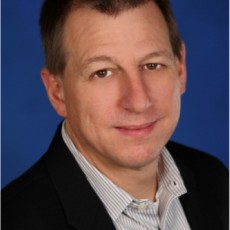 James Bernard is senior director of global strategic partnerships for the education group at Microsoft, where his team builds multilateral partnerships in more than 130 countries. The core focus of these partnerships is ensuring that technology serves as an accelerator of effective school management, innovative teaching practice, and students’ acquisition of 21st-century skills. The Blum Center talked with Bernard in advance of his two-week fellowship supported by UC Berkeley’s Development Impact Lab.
James Bernard is senior director of global strategic partnerships for the education group at Microsoft, where his team builds multilateral partnerships in more than 130 countries. The core focus of these partnerships is ensuring that technology serves as an accelerator of effective school management, innovative teaching practice, and students’ acquisition of 21st-century skills. The Blum Center talked with Bernard in advance of his two-week fellowship supported by UC Berkeley’s Development Impact Lab.
What have been some of the takeaways from your time at Microsoft bringing technology to developing countries?
James Bernard: One of the key takeaways has been that there is no single answer to this question. There are so many local contexts that are relevant and so many stakeholders, that every situation needs to be approached differently. Nonetheless, I offer three key takeaways:
- Ensure that the government is included in and feels ownership of all technology decisions. At Microsoft, we see the government as a major stakeholder that needs buy-in and ownership to create long-term sustainable change. But to be successful, the public sector needs the help of many other players, including civil society, the private sector, donors, and other nongovernmental players. In education, many governments make the mistake of thinking that technology—and in particular, the devices they want to give students—will solve all the problems in their education systems. The reality is that technology is only a platform and will never be successful without the right supports, including teacher training, content and curriculum, and assessment of outcomes. Not to mention that the government also needs the necessary buy-in from stakeholders that might be against technology, such as teacher unions or parent-teacher groups. So we work with ministries of education to develop a long-term strategy to bring in the right technologies for the context of that country. We do this through a series of policy-level discussions facilitated by a third party like UNESCO or British Council, but led by the ministry of education, and involving all key stakeholders. This should lead to an ICT [information, communication and technology] strategy before the government goes to tender on devices, and will hopefully ensure that the right choices are made.
- Ensure that the right technology is being used in the right context and even whether technology is the right solution. Will it create more access or more of a divide between the haves and the have-nots in a community? Will it withstand the rigors or a harsh physical environment? Will people know how to use it? How does it get replaced? Can a mobile solution be used or is a laptop/tablet right?
- There is tremendous creativity and innovation happening on the ground in many developing countries. Don’t assume that something that worked in the West is going to work in Africa, or something that works in Africa will work in Latin America. Find local solutions to local problems, and local enterprises to solve those problems. M-Pesa would never have worked in the U.S., but it was timed perfectly for Africa. It is a great example of a locally created solution.
How can NGOs be most effective in promoting economic development in poor countries and regions?
James Bernard: NGOs have two things that many multinational, private sector organizations sometimes lack: credibility and reach. In many cases, these organizations have worked for years or decades in developing countries and have deep relationships with local communities and/or governments. They bring a credible, non-biased opinion that the government trusts. By partnering with such organizations, private sector companies—which often want the same outcomes as other stakeholders—can overcome the perception that they are simply vendors to the government. Second, NGOs have reach into local communities that the private sector will never have. For example, in Ghana, a country with a $38 billion GDP, Microsoft has two to three people in the country, covering all segments across the entire country. One of our NGO partners, Plan International, is active in 500+ communities in Ghana alone. NGOs may be mission-driven, but ultimately many see the investments of funding and human capital as a way to build a more productive society that will help alleviate poverty.
How can higher educational institutions like UC Berkeley advance international development goals?
James Bernard: Higher education institutions play a critical role, because they can provide research and development in the space that has been lacking in the past, particularly in the area of technology. Most technology companies are optimizing their R&D resources for markets where they see the greatest growth in the near- to mid-term. Unfortunately, this means many companies are focused on technologies that are relevant for the West. (I think, however, that there is great opportunity for market growth in technology is in developing countries, where most technology users are net-new versus in the West, where technology is essentially a renewal business.) NGOs don’t have R&D budgets for the most part—although a few, like PATH, do some R&D, but they are the exception not the norm. So universities can play a critical role in pushing change in development by working with both NGOs and private sector companies. Additionally, universities can provide agnostic research into successful strategies and implementations.
What are the biggest changes you have seen in the intersection of development, education, and technology during your career?
James Bernard: First, I see a greater willingness for different stakeholders to come together to solve some of the big issues facing education: ensuring students have access; driving a greater focus on student learning outcomes; ensuring teachers have time on task; keeping girls in school and out of dangerous situations. Additionally, we are seeing some critical technology trends that increase digital access:
- The evolution of the User Interface. Touch screens are now almost ubiquitous on most devices. This allows technology to be used in both online and tactile learning environments. Nothing can replace good teaching, but when teachers are supported by interesting content that takes advantage of the UI, magical things can happen. We are seeing many companies now reinventing what it means to serve educational content. For example, one company created an app that allows students to see a forest, drill into an individual tree, then a leaf, then the cell and the molecular structure of the leaf. They can spin the elements around, and can pull in data from other sources. It changes the way we perceive of educational content.
- The role of the device. Device form factors have changed drastically in the last 10 years. We now have more computing power in a mobile phone than many early mainframe computers had. In addition, the cost of devices has reduced significantly, to the point where it’ll soon be possible to have a high-end device for less than $100 a unit. The danger here is that governments begin to focus on the device rather than supporting it in the right ways. So it’s critical that funds, which would have been used for devices in the past, be used for content, assessment, and teacher training. No matter what, a device cannot replace a teacher, so teachers need to understand how to use devices as a part of their teaching practice.
- Universal access. It’s continuously getting easier for people to get online, even in some of the more remote areas of the world. More can be done with 3G and 4G wireless connections, and we’re seeing a number of new technologies becoming more ubiquitous, including TV White Spaces, which use unused TV band spectrum (essentially unused channels) to deliver long-range Wi-Fi that can cover up to 100 square kilometers, and does not require line-of-site access. We’re already piloting this technology in a number of countries, and believe that with effective cooperation among wireless providers, regulators, and other players, TV White Spaces can be a game changer in providing last-mile digital access. If we have better access, you can easily imagine kids living in a community without a fulltime teacher being able to learn from a trained teacher elsewhere using Skype.
- The move to the cloud. With greater access to high-speed connections, comes a greater opportunity for education systems to take advantage of cloud services. This unlocks a number of opportunities—from new ways to finance technology (reducing device costs through services models), to better collection and distribution of data, to providing richer, more individualized content for learners, based on where they are in their learning journey. Many of our partners are working on adaptive learning algorithms that allow teachers to identify where a student is, and the system will provide content based on their level of learning.
What areas are being overlooked in the intersection of development, education, and technology?
James Bernard: As I said earlier, too many education decision-makers still view the device as the answer. And this isn’t just a developing world problem. Look at what happened in LA last year with their iPad rollout. It’s a well-documented failure, because the devices were not well supported. Or the One Laptop Per Child program in Chile or Rwanda. These examples prove that if the devices aren’t supported with teacher training, content, assessment, etc., they will fail in education. In many parts of the world, school or system-wide policy does not account for technology’s role in driving 21st-century skills or student learning outcomes. A study we did in 2011 in seven countries (including developed and developing countries) showed that teachers who used innovative practice—allowing students to learn inside and outside the classroom, allowing students to learn at their own pace, and using appropriate technology—increased the acquisition of 21st-century skills that ultimately will make students more employable. But many schools don’t even allow students to use cell phones in class, and are geared more toward teaching methodologies that were relevant 100 years ago.
If you could make one magic technological fix in the world today, what would it be?
James Bernard: Low-cost solar base stations that could tap into the unused wireless spectrum, and regulations that support this kind of access. Access is the key to all other technologies being used effectively, and gives students the power to find the knowledge that we take for granted every day.
James Bernard will be speaking at a Development Impact Lab panel on “Tech Innovation and Partnerships for Education in Africa” on April 10, 2015, 3-5 pm. For more information and to RSVP, click here.
Daniel Zoughbie’s Contagious Model for Public Health
By Tamara Straus
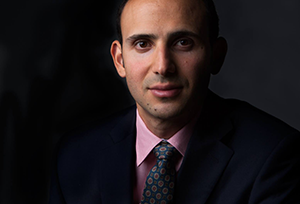 Among the global health reports that keep Daniel Zoughbie up at night is a World Economic Forum and Harvard School of Public Health study, which predicts that over the next two decades the global economy will lose $47 trillion to noncommunicable diseases, such as diabetes and cardiovascular disease.
Among the global health reports that keep Daniel Zoughbie up at night is a World Economic Forum and Harvard School of Public Health study, which predicts that over the next two decades the global economy will lose $47 trillion to noncommunicable diseases, such as diabetes and cardiovascular disease.
“Yet a very modest intervention that tries to make small changes in people’s behavior can have an enormous impact in terms of prolonging lives and saving under-resourced communities millions upon millions, even billions, of dollars,” says Zoughbie.
The modest intervention to which Zoughbie refers is a social network for “contagious health” behavior, basically a small group of family or friends who support each other to eat healthy and exercise regularly. Zoughbie has obsessively backed this social network idea since 2005, when he founded Microclinic International, using personal scholarships and startup funds from the BigIdeas@Berkeley competition. The UC Berkeley and Blum Center-seeded nonprofit has since gone on on to affect more 1 million people through the establishment of “microclinics,” community initiatives, and media campaigns across four continents.
The idea of positive peer behavior leading to positive health results may seem obvious, and that’s because it is. Microclinic International’s social network approach is based on old notions of community and self-help, says Zoughbie.
The idea also comes from a personal loss. As a junior in college, Zoughbie reflected on the premature death of his grandmother in the West Bank due to diabetes and had two intertwining epiphanies: 1) his grandmother did not have the public health information she needed to help her manage her disease; and 2) if she had been given basic preventative information and found a supportive network, she would have changed her diet and health regiment and lived much longer.
“She simply was not able to access a basic level of quality healthcare and education,” says Zoughbie, who was born and raised in the Bay Area.
Under the mentorship of UC Berkeley Professor Ananya Roy, an expert in urban studies and international development, Zoughbie began investigating how lower income communities organize themselves from the bottom up in the absence of effective or existent services. He travelled to Palestine and observed that community, not individual or institutional, ties are dominant—and that health behaviors are often social or cultural in nature.
In Palestine, for example, he observed one family with a diabetic father who passed around chocolate when entertaining a guest. Zoughbie remembers the daughter, who had learned about the dangers of diabetes from a Microclinic International program, admonishing her father for reaching for one of the chocolates.
“The daughter told her father that under no circumstances was he to eat that chocolate,” remembers Zoughbie. “In Middle East culture, this is a bit taboo: to tell your father what to eat or not to eat in front of guests. But the daughter cared more about saving her father’s life than causing some societal embarrassment.
“From these and other interactions, I realized that positive health behaviors could be just as contagious as negative health behaviors.”
Zoughbie was named a Strauss Scholar and a Haas Scholar in his junior year. He studied social anthropology at Oxford University on a Marshall Scholarship, and completed his doctorate in international relations there as a Weidenfeld Scholar. Yet he was not a traditional student. All the while, he used his university honors and credentials to travel, conduct research, and network on behalf of Microclinic International.
“While I was a Marshall Scholar, I went to South Africa and was on a bus, where I met somebody who introduced me to somebody else,” remembers Zoughbie. “One thing led to another, and I put in an application to the World Diabetes Foundation. We applied for almost $100,000 and, to my great surprise, Microclinic International got it.”
Stephen Shortell, UC Berkeley’s Blue Cross of California Distinguished Professor of Health Policy and Management, remembers Zoughbie as a young man easy to support. “He came up to me at a Blum Center function and asked whether we could meet and talk,” recalls Shortell. “He was attacking a very big problem—diabetes in developing countries—and I could see his concept was both promising and low-cost. I made some introductions.”
Zoughbie, now 30, has spent much of the past decade hustling to scale up his nonprofit. The key ingredient, he explains, has been persistence and endurance, “talking to lots and lots of people, and bluntly saying, ‘Hey, I have this idea, which has been piloted; it’s pretty simple and inexpensive to scale, and could save a lot of lives in under-resourced communities.’”
This kind of persistence led in December 2006 to the formulation of a Microclinic International pilot in Jordan, with support from Queen Rania’s Royal Health Awareness Society, the Jordanian Ministry of Health, and a former British Ambassador to Jordan. With support from A. W. Clausen, a former president of the World Bank and Bank of America, Zoughbie was able to establish Clausen Fellowships, hire really bright people, and take a more quantitative approach to understanding the effectiveness of the organization’s work and refine its model.
Microclinic’s diabetes social network model is based on four key strategies, or “4 Ms”—Meals, Movement, Medication, and Monitoring—and is intended not just to alter dangerous health behaviors but, more importantly, to sustain positive ones in groups of family and friends. As principal investigator for Microclinic International, Zoughbie has initiated several major trials, including a two-year, Jordan-based study published in Lancet Global Health, which found that for most patients, improvements in blood sugar control were sustained for two years after signing up.
Microclinic International also has achieved evidence of impact on the other side of the globe, in Bell County, Kentucky. There, it partnered with the health insurance company Humana to conduct a randomized control trial of 552 participants from five neighborhoods in rural Appalachia, where obesity and diabetes are widespread. Again, clusters of two-to-eight friends and family voluntarily came together to establish and spread healthy norms, such as regularly checking weight and blood sugar, exercising, watching calories, and eating fresh fruits and vegetables. A 16-month follow up of the cohort, published in a 2015 study in American Heart Association journal Circulation, found that a substantial majority of the TeamUp4Health patients experienced and maintained decreased in weight, waist size, and blood pressure.
“Leveraging the social network and peer influences and social networks for support may be important for fighting obesity,” said Harvard School of Public Health Scientist Eric Ding, who served with Zoughbie as co-lead author of the Circulation study and is director of epidemiology at Microclinic International. “We need to focus on more than the individual obese patient in isolation, and look to family and friend networks and the communities where people live.”
Zoughbie, whose PhD is in international relations—and who also serves as a political science scholar at UC Berkeley’s Center for Middle Eastern Studies (his recent book Indecision Points: George W. Bush and the Israeli-Palestinian Conflict was published recently by MIT Press)— views public health as fundamental to regional and international security.
“When a community is falling apart,” he says, “health problems often create a vicious cycle, in which people are poor because they’re unhealthy and they become more unhealthy because they’re poor. This cyclical nature of poor health creates the seeds for social unrest. It creates disaffected young people who don’t see any hope for the future.”
This connection between public health and societal stability is what drives Zoughbie to replicate the Microclinic International model in as many insecure places as possible. Backed by the Centers for Disease Control, Google, the International Diabetes Federation, Humana, Mulago Foundation, the Robert Wood Johnson Foundation, and the Horace W. Goldsmith Foundation, Zoughbie’s nonprofit is in expansion mode, working with over 260 people. Currently, the United Nations is partnering with Microclinic International to train 1,000 healthcare workers to reach hundreds of thousands of Middle East refugees through social networks by spreading health behaviors and thwarting preventable diseases and their complications.
“I see our model as helping repair the broken fabric of society,” says Zoughbie. “Groups of people helping each other to get healthier is a first step for broken communities to rebuild a future. There’s an old Arab proverb I like to quote: ‘When there’s health, there’s hope. And when there’s hope, there’s everything.’”
Generation Innovation: Sarvottam Salvi’s Pivot to Development Economics
By Sybil Lewis
When Sarvottam Salvi came to UC Berkeley in 2011, he was intent on double majoring in chemical engineering and economics and “interested in making some money.” By his third year at Cal, however, he had crossed chemical engineer off the career list, kept economist on it with an emphasis on development finance, and declared a minor in Global Poverty & Practice.
Born and raised largely in Illinois, Salvi said the year he lived in Pune, India during eighth grade exposed him “to issues of inequality and poverty and remained a backdrop in my mind.”
During his first year at UC Berkeley, he recalls a meeting of the student club Engineers Without Borders. There, Blum Center Professor Khalid Kadir pushed the group to think about the political and cultural implications of implementing engineering projects, causing Salvi to want to learn more.
“Kadir was poking at us to look at the power and cultural dynamics [of engineering projects], and I could tell that my engineering buddies were not really understanding what was going on, which is why I went looking for courses in development and poverty issues.”
Salvi enrolled in Global Poverty & Practice 115 taught by Professor Ananya Roy, which focuses on social and political models to alleviate poverty. Salvi said he found the course intellectually stimulating, but what he really craved was an understanding of the practical side of development work.
That sense came from a 2013 student-run Decal course on the Peace Corps, where he met returned volunteers who shared their experiences working around the world. “The Decal allowed me to relate the personal aspect of development to what I had learnt in GPP 115 and that’s when I made a U-turn,” he said. “I thought to myself—I’m done with consulting and finance. I will focus my economic course load on development.”
Salvi declared a minor in Global Poverty & Practice and during the summer of 2014 traveled to Mumbai, India to intern with Svasti Microfinance, as part of the minor’s “practice experience.”
He said he was initially skeptical about whether microfinance—a financial service that provides small loans to people who lack access to traditional banking—was a successful development tool. In GPP 115, Salvi learned of the failures of microfinance due to predatory lending and rigid repayment structures of some firms. And he was aware that in 2010 more than 200 residents in the state of Andhra Pradesh, India killed themselves after being overwhelmed by microloan debt and pressured by the microfinance firms to repay.
Yet in Mumbai, Salvi saw that Svasti had a strong lending model, granting small loans to people who were financially stable enough to make payments. At Svasti, he was also able to do hands-on work. He used his economics knowledge to build a tool for the company estimating loan affordability for clients—something that is tricky because many potential loan takers work in the “informal” economy, as street food venders and jewelry-makers. Thus their income is harder to track and model by the government or lending agencies like Svasti.
“People in lower socioeconomic brackets also need financial services like everyone else, not charity,” said Salvi. “Microfinance is not just about giving people money, but realizing that sometimes without these loans the opportunities available to people are very limited.”
In modeling people’s varying and unofficial incomes, Salvi said what he found most useful was not the economic and statistical analysis skills he learnt in school, but intuition and on-the-job-training.
He also thought that his Indian language skills and cultural background—his family is from the state of Maharashtra, where Mumbai is located—would spare him some of the challenges that his non-Indian peers faced. But he quickly realized that there was a lot of “cultural weight” in how people perceived and reacted to him. “Whenever I went with the workers from Svasti, they would always introduce me as the ‘Sir from America,’ which was weird because they were older than me and better at the work,” said Salvi.
Conducting surveys and interviews throughout Mumbai’s largest slums, Salvi noted the strong sense of community despite acute levels of poverty. “Money was not related to respect in that setting—people respected each other because of their relationship to each other,” said Salvi. “I was struck by the community aspect, which seemed more powerful than whatever money they did or didn’t have.”
After the two months in India, Salvi said his assumptions about microfinance and his possible role in development work changed drastically. “When I was doing the surveys and talking to people I thought, ‘Oh, I am doing development now,’” said Salvi. But he soon realized his skills are better suited for economic modeling and evaluation.
“I think it is necessary to do fieldwork,” he explained, “but I don’t think that I need to be the one doing it. I think that the best way for me to make an impact in issues of development is to use my education in economics.”
Salvi has taken several courses in impact evaluation at UC Berkeley, such as Professor Edward Miguel’s Economics 172 (Case Studies in Economic Development), and is currently working as a research assistant on a project by Associate Professor Federico Finan, a development economist.
Salvi, who graduates in May, is applying for jobs at organizations that specialize in research related-development in the areas of poverty, health, and financial inclusion.
Eat.Think.Design: A Public Health Course for the Startup Generation
By Tamara Straus
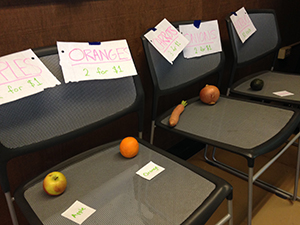 For the creators of the UC Berkeley course Eat.Think.Design, two things are certain. First, the United States is facing a food and nutrition crisis, with rocketing rates of diabetes, hunger, and health disparity. Second, graduate students today—from fields as different as public health, business, information technology, and engineering—want their education to be more hands-on, more interdisciplinary, and more “impactful” to society at large. In the case of the Eat.Think.Design course, they want to spend class time not just learning about food and nutrition problems, they want to devise actual food and nutrition solutions.
For the creators of the UC Berkeley course Eat.Think.Design, two things are certain. First, the United States is facing a food and nutrition crisis, with rocketing rates of diabetes, hunger, and health disparity. Second, graduate students today—from fields as different as public health, business, information technology, and engineering—want their education to be more hands-on, more interdisciplinary, and more “impactful” to society at large. In the case of the Eat.Think.Design course, they want to spend class time not just learning about food and nutrition problems, they want to devise actual food and nutrition solutions.
This may sound grand, but for the course’s three instructors— Jaspal Sandhu, a UC Berkeley lecturer in design and innovation; Nap Hosang, a longtime Kaiser Permanente medical doctor and UC Berkeley School of Public Health instructor; and Kristine Madsen, an associate professor in the Joint Medical Program and Public Health Nutrition at Cal’s School of Public Health—there is nothing grand or inappropriate about letting students attempt societal solutions while in school.
“The reason we emphasize experiential learning is because it has proved to be more effective,” says Sandhu, who is also a partner at the Gobee Group, a consulting firm he runs with two other multilingual Fulbright scholars with UC Berkeley roots. Sandhu speaks Punjabi, Spanish, Mongolian, and English, and prior to Gobee worked with the Mongolian Ministry of Health designing mobile health information systems.
Sandhu emphasizes that his students’ backgrounds demand more than lecturing. Among the 25 people enrolled in Eat.Think.Design this spring, many have relevant work experience. At least three have started their own companies, several have worked for big companies like IBM, Deloitte, and Eli Lilly, and most have about five years under their belts working for government agencies or large nonprofits. “To keep the attention of such students,” says Sandhu, “we need to give them actual problems to focus on.”
Working in interdisciplinary teams of three under an instructor, Eat.Think.Design students spend the bulk of the semester on one project, conducting ethnographic and market research, investigating models, and constantly devising and then revising potential solutions. Members of last year’s class, for example, streamlined SNAP federal nutrition benefits payments at San Francisco’s Heart of the City Farmer’s Market, worked with the Kossoye Development Program in Ethiopia on strategies to make home gardening more accessible, and built a pilot program with Partners In Health: Navajo Nation to test a pop-up grocery store in areas that are one hour’s drive from fresh food. Although the project in the Navajo Nation helped COPE to receive a three-year, $3 million REACH grant from the Centers for Disease Control & Prevention to pursue healthy eating programs in the vast American Indian territory—Hosang argues that the course is not designed to incubate social innovations per se.
“Our goal is to incubate innovative people—people who can be influencers in the public health sector,” he says. Hosang, who has served as head of the interdisciplinary online MPH degree program for the past 15 years and executive director of the Interdisciplinary MPH degree program since 2010, is not subtle in his criticism of public health teaching. “Most academics are in a silo,” he said, “and their silo has driven them more and more into their specialist thinking.” Yet this specialist thinking, Hosang argues, is running counter to the view that public health is enmeshed in almost every field—from architecture and transportation, to product design and education. “We need to change the way public health professionals approach problems,” said Hosang, “and we need them to be in touch with people from other disciplines to inform their problem-solving processes.”
Hosang and Sandhu started working on their public health course in October 2010, after Hosang read Sandhu’s dissertation on public health design research in rural Mongolia and was impressed by the combination of grassroots and trial-and-error learning. In the spring of 2011, they launched their course, with financial support from the Blum Center for Developing Economies, which seeds interdisciplinary, social impact courses on campus. Madsen joined the course in 2014 when the focus narrowed from designing innovative public health solutions to designing innovative food solutions. In a March 2015 article in the American Journal of Public Health titled “Solutions That Stick: Activating Cross-Disciplinary Collaboration in a Graduate-Level Public Health Innovations Course at the University of California,” the three instructors describe how their approach is part of a much-needed pedagogical shift. They write:
“A Lancet Commission, convened to discuss the education of health professionals in the 21st century, argued that educational transformation is critical to meet the public health problems we face in this century. Specifically, the commission called for a higher level of learning, moving beyond informative learning, which transmits knowledge to create experts, to transformative learning, which transmits leadership attributes to create agents who can successfully implement change.”
Sandhu explained that when he and Hosang came up with the idea for the course, not only was this “change agent” approach novel but no one was applying design thinking or human-centered design approaches at the School of Public Health at UC Berkeley. (He describes those approaches as ones that enable teams to systematically develop novel, effective solutions to complex problems.) Yet Sandhu says it is clear there’s a demand for this kind of problem solving.
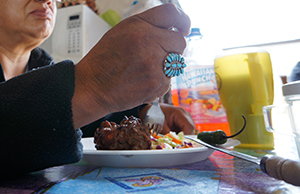 Sandhu’s proof is the continual over-enrollment in and rave reviews of his course. This year, 60 students applied for 25 spots. And for the past four years, 40 percent of students indicated it was the “best course” they took at UC Berkeley, with the other 40 percent stating it was in the “top 10 percent” and the remained saying it was in the “top 25 percent.”
Sandhu’s proof is the continual over-enrollment in and rave reviews of his course. This year, 60 students applied for 25 spots. And for the past four years, 40 percent of students indicated it was the “best course” they took at UC Berkeley, with the other 40 percent stating it was in the “top 10 percent” and the remained saying it was in the “top 25 percent.”
Christine Hamann, a MBA/MPH candidate who took Eat.Think.Design in 2014, confirmed that “the teaching team is phenomenal—both in terms of the academic leadership and the mentoring of graduate students.” She also confirmed that she and her fellow students want “practical challenges in graduate school,” adding “we are tired of theory.”
Hamann is one of the many students who has brought past work into the classroom. Before grad school, she worked for seven years at Partners In Health, most recently on the nonprofit’s COPE Project in the Navajo Nation. She said the course forced her to look at Navajo Nation residents’ consumer needs around food and nutrition—and to see food less as a supply issue and more of a demand issue. “Traditional public health approaches focus on supply, but that is why you see programs that don’t meet the needs of the community,” she said.
Hamann and the three other graduate students opted not to focus on the best truck routes to bring fresh produce into the 27,000 square mile territory—and instead focused on seeing what citizens there want to consume and what can last in what is a food (and actual) desert. During the summer of 2014, with funding from the Blum Center, Hamann created pop-up grocery stores in Navajo, to determine which food items were most in demand and could help reduce chronic diseases like diabetes, which affects 20 percent of residents. This exploration helped lead to the aforementioned $3 million CDC grant for COPE.
As to why so many Cal students are so focused on food and nutrition, Hamann has this to say: “From a public health perspective, I think we’re seeing the ramifications of the American diet play out in really scary chronic disease indicators.” She also noted that there is a general heightened awareness of food systems—“of where food is coming from, the corporations that own it, and the detrimental effects those relationships can have on both health outcomes and business models.” Third, Hamann said a growing number of students want to see tech innovation applied to less wealthy and less urban populations—“the people,” she said, “who need it.”
Then, there are the galling statistics: Americans throw out an estimated 40 percent of food grown per year. An estimated 50 million Americans do not have access to enough food. As of 2012, about half of all adults—117 million people—have one or more chronic health conditions, such as heart disease, stroke, cancer, diabetes, obesity, and arthritis. And childhood obesity has more than doubled in children and quadrupled in adolescents in the past 30 years.
Sandhu is aware that a course on food innovation is well timed at UC Berkeley. In 2013, UC Berkeley’s College of Natural Resources, the Goldman School of Public Policy, the Graduate School of Journalism, Berkeley Law, and the School of Public Health joined forces to create the Berkeley Food Institute to improve food systems locally and globally. A year later, UC President Janet Napolitano launched the UC Global Food Initiative—to prompt all 10 campuses, UC’s Division of Agricultural and Natural Resources, Lawrence Berkeley National Lab, and a consortium of faculty, researchers, and students to address food security, nutrition, and sustainability issues. Even BigIdeas@Berkeley, the annual student innovation prize, has a contest category on food systems innovation.
“Our timing is either well forecasted or extremely lucky,” said Sandhu.
Eat.Think.Design may be a popular course—and may inspire copycats—but both students and instructors are quick to point out that the course cannot serve as a model for every class. “It is difficult to take more than one experiential class per semester,” said Hamann. “The time commitment with fellow students and with our client is just too big.” Amy Regan, who took the course in 2013 and now works with the San Francisco Unified School District’s Future Dining Experience program, agrees that “compromising and agreeing on the best approach among a group takes time.”
For instructors, Professor Madsen estimates the course requires one and a half to two times more time than an average School of Public Health offering, because she, Sandhu, and Hosang each mentor three student groups during and after class time. The three instructors also spend time cultivating their connections to bring in student projects from nonprofits and government agencies. During the class on Feb. 4. 2015, 16 pitches were made by representatives of various organizations, including California Farm to Fork, San Quentin State Prison, and Project Open Hand. “Much more work goes into creating the class because of all the connections to be made,” said Madsen.
And very little is scripted. This gives the course the feeling of a kind of pedagogical startup, exciting but uncertain. Madsen said this atmosphere comes with a distinct disadvantage for professors. “You have to admit you don’t know as much,” she said. “If your identity is wrapped up in being an academic expert, this won’t work; you’ll always default to the more narrow but comfortable path.”
For Sandhu and Hosang, who are adjuncts, there is less face to lose. “I think over the last seven years, since the start of the Great Recession, there’s been a transformative energy happening in higher education,” said Hosang. “It’s coming from the younger generation who see the world has changed and who no longer see college as a ticket to success. That’s where this move toward an interdisciplinary, hands-on approach is coming from.”
36 UC Berkeley Students Make “Commitments to Action” for 2015 Clinton Global Initiative University
By Andrea Guzman
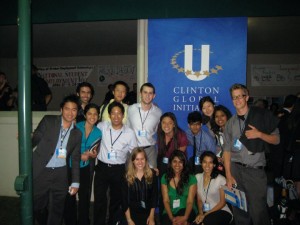 The Blum Center for Developing Economies is supporting 36 ambitious UC Berkeley’s students to attend the Clinton Global Initiative University (CGI U) Conference in Miami, Florida this coming March.
The Blum Center for Developing Economies is supporting 36 ambitious UC Berkeley’s students to attend the Clinton Global Initiative University (CGI U) Conference in Miami, Florida this coming March.
Launched in 2007 by former President Bill Clinton, CGI U hosts student leaders, university representatives, topic experts, and celebrities to come together to discuss and develop innovative solutions to pressing global challenges. This year’s conference, held March 6-8 at the University of Miami, will convene more than 1,100 students to discuss how they are taking action to address challenges in the following five areas: education, environment and climate change, peace and human rights, poverty alleviation, and public health.
The Blum Center has sponsored UC Berkeley’s participation in the CGI University Network since 2012, supporting students through travel assistance and yearlong advising on student projects. The Network is a distinguished body of higher education institutions throughout the world that have made a robust commitment to the principles of Clinton Global Initiative.
In 2015, the number of UC Berkeley students attending the conference jumped to 36 from 28 in 2014, with approximately 65 percent of the students having additional affiliations with the Blum Center. These affiliations include participation in BigIdeas@Berkeley, the Development Impact Lab, the Social Innovator OnRamp course, and the Global Poverty & Practice minor.
“Student-led innovations and community projects are better positioned to thrive when they have a wide spectrum of support and mentorship,” said Sean Burns, Director of Student Programs at the Blum Center. “Because of this, we are thrilled when we see Cal students participating in CGI U, who have been developing their ideas through some of our other Blum Center programs.”
A total of 24 projects will be presented, consisting of 17 group projects and seven individual projects. The projects range from educational programs for survivors of human trafficking to improving energy access in rural, developing areas.
Undergraduate business students Camilo Ossa and Elizabeth Mossessian will be attending the conference representing their project SeedEd Capital. Mentored through the Blum Center’s Social Innovator OnRamp course and a current Big Ideas finalist, SeedEd Capital is an online platform that facilitates investors and donors to support underprivileged “seeds,” or students, with financial resources. It intends to connect individuals who are passionate about education with students across the Bay Area who need financial resources and other support to pursue higher education. In addition to facilitating student-donor interactions online, SeedEd works to mentor and tutor students so they can achieve their academic goals.
Ossa and Mossessian said they are excited to meet like-minded students at CGI U and to connect with experts and influencers in the fields of education, economic empowerment, and youth support programs.
“We believe the interaction that we can get with experienced individuals, who can mentor us and provide feedback, is going to be immensely helpful in the development of the project,” Ossam and Mossessian said in an email.
A Cross Sector Exchange on Governance and Digital Technology
By Sybil Lewis
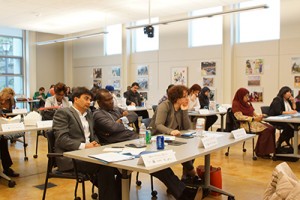
As part of a 10-day program on “Leadership in the Digital Economy,” co-sponsored by the National Democratic Institute, the Institute for Representative Government and the House Democracy Partnership of the U.S. House of Representatives, with support from the U.S. State Department and USAID, 20 members of parliament from 11 countries attended a panel discussion with UC Berkeley researchers at the Blum Center on Feb. 17.
The event was hosted by the Blum Center for Developing Economies in partnership with the Center for Information Technology Research in the Interest of Society (CITRIS)—and the focus of the discussion was how technology can be used to promote open government, civic technology, and the development of a digital economy.
Parliamentary members from 11 countries—Columbia, Georgia, Ghana, Indonesia, Jordan, Kenya, Kosovo, Nepal, Peru, Serbia, and Tunisia—met with Blum Center-affiliated faculty and postdoctoral fellows, who are conducting research on the impact of digital technology on civic engagement, corruption, and public service delivery.
“The work being done by Blum Center-affiliated scholars is enriched by interactions with elected government members who can take up new ideas and enact them,” said Sophi Martin, director of partnerships at the Blum Center. “It was truly exciting to have this distinguished delegation here, exchanging ideas and talking with us about the real implications of technology on government and citizens.”
Among the presenters was Jennifer Bussell, assistant professor of Public Policy and Political Science at UC Berkeley. Bussell researches public services in India, Brazil, and South Africa. Her recent book, Corruption and Reform in India, investigated how digital technologies may be used to facilitate citizens’ access to the state and thwart corruption. Bussell is currently working on a Development Impact Lab-sponsored project to examine opportunities for crowd sourcing information on government performance in India.
Isha Ray, associate professor of UC Berkeley’s Energy & Resources group, also presented to the delegation. Ray’s research projects focus on access to water and sanitation for the rural and urban poor, and on the role of technology in improving livelihoods. She has been among the faculty leaders of a BigIdeas@Berkeley startup called NextDrop, which uses cell phones and SMS messages to alert people in low-income urban neighborhoods in India when they will receive water. Ray described how in India and other Asian countries, intermittent water supplies greatly inconvenience people, forcing many to wait at home for the taps to start running. The NextDrop team has been training water valve operators in the twin cities of Hubli-Dharwad to send text messages to neighborhoods receiving water. The project is currently rolling out in Bangalore as well.
The third Blum Center scholar to present was Kweku Opoku-Agyemang, a postdoctoral fellow at the Development Impact Lab. Opoku-Agyemang works on the political economy of development—on how both economic and political factors affect social change, with an emphasis on technological innovations. He has been using voice message surveys to understand changes in civic engagement with local governance in Ghana.
In the discussion, members of parliament expressed enthusiasm about the potential cost-effectiveness and ease of using technology to address governance and democratic process, particularly for historically marginalized groups.
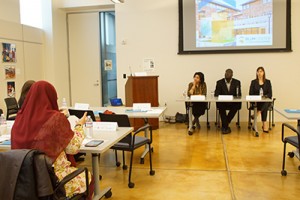 Udaya Shumsher Rana, a member of Constituent Assembly for the Federal Democratic Republic of Nepal, asked how politicians can adjust incentive structures to avoid corruption among bureaucrats in charge of government projects.
Udaya Shumsher Rana, a member of Constituent Assembly for the Federal Democratic Republic of Nepal, asked how politicians can adjust incentive structures to avoid corruption among bureaucrats in charge of government projects.
“We need to think of how formal and informal structures of government are set up, and figure out how to adjust those structures to produce incentives that encourage better behavior,” Bussell responded.
Ray provided examples from her fieldwork in India, where she studied incentives to the people who operate the water valves. She noted operators are often bribed into changing water paths or leaving water on longer in one neighborhood over another. She said that the valve men themselves come from low-income backgrounds and there may be other incentives besides money to get them to operate the valves fairly.
Johnson Arthur Sakaja, a member of the National Assembly of the Republic of Kenya, asked whether the panelists viewed technology as a tool for government officials or as a means of transforming governance itself.
Opoku-Agyemang responded by way of example. He said the surveys he conducted in rural Ghana were no “silver bullet” for understanding citizen views or for improving governance. “At the end of the day,” he said, “technology tools will only be as useful as the trust communities foster in government”—in other words, citizens who respond via mobiles or other technological means to government projects and measures must feel that their input is translating into real policy change.
Ray added: “In general, I feel that information and technology can empower people, but it won’t always lead to power. Yet keeping knowledge and information from people does lead to powerlessness. So to the extent that I do believe in these technologies, I believe in their ability to widen the stroke of democratic participation, but it cannot guarantee it by any means.”
During its Bay Area tour, the international government delegation also met with elected government officials from San Francisco, Palo Alto, and Vallejo and with technology industry representatives from Facebook and other Silicon Valley companies.
—
Delegation on Leadership in the Digital Economy
Republic of Colombia:
Hon. Angelica Lozano, Member, Congress
Georgia:
Hon. Tinatin Khidasheli, Member, Parliament
Hon. Chiora Taktakishvili, Member, Parliament
Ghana:
Hon. Emmanuel Bedzrah, Member, Parliament
Hon. Ama Pomaa Boateng Andoh, Member, Parliament
Republic of Indonesia:
Hon. Ledia Hanifa, Member, People’s Representative Council
Hon. Diah Pitaloka, Member, People’s Representative Council
Hashemite Kingdom of Jordan:
Hon. Najah AlAzzeh, Member, House of Deputies
Hon. Assaf AlShawabkeh, Member, House of Deputies
Republic of Kenya:
Hon. Jessica Mbalu, Member, National Assembly
Hon. Johnson Arthur Sakaja, Member, National Assembly
Republic of Kosovo:
Hon. Zenun Pajaziti, Member, Assembly
Hon. Donika Kadaj-Bujupi, Member, Assembly
Federal Democratic Republic of Nepal:
Hon. Udaya Shumsher Rana, Member, Constituent Assembly
Republic of Peru:
Hon. Macias Guevara Amasifuen, Member, Congress
Hon. Julia Teves Quispe, Member, Congress
Republic of Serbia:
Hon. Gordana Comic, Member, National Assembly
Hon. Dubravka Filipovski, Member, National Assembly
Republic of Tunisia:
Hon. Sabrine Ghoubantini, Member, Constituent Assembly
Hon. Hayat Omri, Member, Constituent Assembly
Generation Innovation: Ashley Tsai on Tropical Disease Research and Eradication
By Andrea Guzman
In spring 2013 Ashley Tsai, a UC Berkeley Bioengineering and Material Science major and Global Poverty & Practice minor, enrolled in Public Health 112, which examines health at the individual and community level through multiple factors. Among the draws to the course were its regular guest speakers, including Dr. Peter Jay Hotez, dean of the National School of Tropical Medicine at Baylor College of Medicine.
Hotez is one of the most influential experts in raising awareness about tropical disease research and control, particularly neglected diseases such as hookworm infection, schistosomiasis, and leishmaniasis—which are among the most common infections of the world’s poorest people.
“He was really passionate and inspiring,” said Tsai. “I decided I wanted to learn more about these diseases.”
After Hotez’s lecture, Tsai searched online for laboratories that conduct neglected tropical disease research and found Kohn Kaen University in Thailand, which welcomed foreign students. The research sparked her interest and the laboratory was fortunately English speaking. Through a GPP minor fellowship, she headed to northern Thailand for the summer of 2014.
Tsai soon learned that much of the laboratory’s research was focused on liver fluke infections, which affect the rural poor in more than 50 countries. “Not a lot of people know about these infections,” said Tsai, “and there is not much research or investment in finding out more.”
The transmission cycle for liver fluke goes from infected humans, to snails through human feces, to fish that share habitats with the infected snails, and finally back to humans, who consume undercooked fish that carry the parasite. Infections may range from asymptomatic to presenting symptoms, such as abdominal pain, fever, jaundice, and gallstones. Perhaps most seriously, Southeast Asian liver fluke, the type Tsai studied, is classified as a carcinogen and strongly implicated in cancer of the bile duct. Tsai’s primary job was to compare the snail proteins and the fluke proteins for further research.
Tsai said she was glad to find that very good research is happening at universities in developing countries. “I realized that it’s important to collaborate instead of [universities in wealthy countries] always taking the lead,” she said. “Local laboratories working with local diseases probably have more insight than labs at places like UC Berkeley, because the former know the culture and customs a lot better.”
She also described how the Kohn Kaen lab took a holistic approach in eradicating diseases. Its efforts involved not just documenting disease transmission but focusing on how to stop transmission by collaborating with other universities and with government agencies and community organizations focused on public education and sanitation.
“This approach showed me that technology and science by themselves are like Band-Aids,” said Tsai. “For real change to happen, it has to come from public policy and the local community.”
Tsai said liver fluke is easily treated with a drug, but that the drug does not prevent infection from occurring again. In one of the areas where she and Kohn Kaen University researchers were studying, the problem largely derived from a cultural component: people ate raw fish. Thus to be successful in eradicating the disease there, researchers had to create an education campaign about the dangers of consuming fish that was not cooked.
Sean Burns, the Blum Center’s director of student programs, said Tsai’s field experience allowed her to engage in the kind of interdisciplinary problem solving that is increasingly valued in the fields of development, public health, and poverty alleviation.
“During her practice experience, Ashley began to see that complex development challenges needs complex solutions,” Burns said. “She and her fellow researchers are envisioning solutions that bring together breakthrough lab science with grounded insights into culture, politics, and social behavior. It’s at this intersection, of what we have begun to call “development engineering,” that we will see important contributions to poverty alleviation in the 21st century.”
Tsai’s GPP practice experience at Kohn Kaen University has altered her career plans. “The practice experience taught me that I can live very well on much less material possessions, and that important and fulfilling work is being done in many organizations all over the world,” she wrote after the trip. “As a result, I am now strongly considering a career in the academic or nonprofit sector.”
Tsai plans to attend a masters program in chemical biology with a focus on neglected tropical diseases and health issues that affect the global poor.
“The GPP minor made me want to look into a field of global health, and taught me that policy change is very important as well as working with the community itself,” said Tsai. “Being isolated in a lab and working with science itself is no longer enough.”
From Student to Staff: Five Questions for Anh-Thi Le
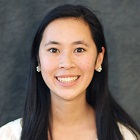 Anh-Thi Le joined the Blum Center in September 2013 as a program coordinator for the Development Impact Lab after graduating from UC Berkeley with a B.A. in Political Science and a Minor in Global Poverty & Practice. As part of an ongoing series with Blum Center faculty, students, and staff, we asked her about her work in poverty action and education.
Anh-Thi Le joined the Blum Center in September 2013 as a program coordinator for the Development Impact Lab after graduating from UC Berkeley with a B.A. in Political Science and a Minor in Global Poverty & Practice. As part of an ongoing series with Blum Center faculty, students, and staff, we asked her about her work in poverty action and education.
Q: What compelled you to focus on public service and poverty alleviation?
Anh-Thi Le: I have always been interested in public service, but it wasn’t until I came to UC Berkeley that it became a career choice. Inspired by Professor Robert Reich’s class on income inequality in the United States, I spent my first two years as an undergrad working with domestic-focused nonprofits—advocating for Asian Pacific American issues in Washington, D.C., developing re-entry services for ex-offenders in Philadelphia, and providing cancer education and awareness on campus. While my work experiences varied, the one constant was a curiosity about how to effectively address and alleviate poverty, not just domestically but internationally as well. I found myself wondering: How can policies be more effective and have greater impact in resource-poor communities? How can we build better bridges between policymakers and community members to ensure that policies reflect the needs of a community? These were some of the questions that motivated me to enroll in Global Poverty & Practice 115 class taught by Professor Ananya Roy, who, by the way, never provided neat answers. Her class inspired me to enroll in the Global Poverty & Practice Minor, to continue engaging in discussions about global poverty and inequality.
Q: What is particular or unusual about the Global Poverty & Practice Minor?
Anh-Thi Le: Being part of the minor is extremely challenging and thought provoking. It exposed me to the international development space, which allowed me to align my public service interests with my international political science studies. Perhaps most important, the minor connected me to people who are equally passionate and committed to social justice and from various academic and cultural backgrounds. I met students majoring in business, physics, chemistry, social welfare, sociology, and environmental sciences—students whom I otherwise would not have met. Together, we discussed the ethics and methods of poverty alleviation; we framed our perspectives about development (through power, privilege, and sustainability, to name a few); we challenged each other (and sometimes our professors); and we spent hours yelling, critiquing, and discussing the frustrations that came with participating in three-month practice experiences. The Global Poverty & Practice Minor provided a trans-disciplinary ecosystem that allowed for holistic discussion, learning, and practice of development issues. This approach is what makes it and the Blum Center so unique.
Q: How did you come to work at a Blum Center project?
Anh-Thi Le: When I was in India in June 2012, conducting my GPP practice experience with Nest, a U.S.-based nonprofit organization committed to empowering women through market access and capacity building initiatives, my minor advisor notified me about a student position available with CellScope, a UC Berkeley lab, funded partly by the Blum Center and led by Professor Dan Fletcher, which was focused on turning a cellphone into a mobile microscope for disease diagnosis in low-resource regions. A one-year study of the CellScope device was to be conducted in Vietnam, and Fletcher’s group was looking for a Vietnamese-speaking student assistant to help support the project. Luckily, my parents, who came to the U.S. in 1975 following the Viet Nam war, had put me through six years of Vietnamese language classes in California and I got the job. While I was extremely excited to work on a global health initiative, I also remember feeling nervous about my qualifications. On the one hand, how could a political science student with little background in global health technology work in a bioengineering lab? On the other hand, the opportunity allowed me to align my passion in the social and economic development of South and Southeast Asia, with an interest in learning more about the role of technology in international development. The first few weeks in the lab were certainly challenging. The CellScope integrates standard microscope options with the visual interface and wireless data capabilities of a mobile phone. With its durable construction, battery power, and ability to digitally record and wirelessly transmit test results, CellScope allows for screening of patients in rural health centers that previous lacked the tools to diagnose TB. For someone who has fairly little technical expertise in this area, the support I received from the CellScope team made the learning curve that much easier.
Q: How did you use your Vietnamese language skills for the CellScope project?
Anh-Thi Le: Neil Switz, then a postdoc with the Fletcher Lab and now a faculty member at Evergreen State College, and I conducted weekly Skype calls late at night with Dr. Ha Phan, UCSF’s in-country representative in Vietnam, to troubleshoot any problems with the device. We spent hours replicating, testing, and solving errors when problems arose with the software and hardware, reviewed hundreds of images to conduct quality control, and created countless manuals and instruction guidelines on everything from computer usage to reading sputum slides to support Dr. Ha and the Vietnam National Tuberculosis Program staff. While my Vietnamese skills may have allowed the CellScope team to overcome any language barriers, I must note that Dr. Ha spoke English fluently, had professional public health experience in both Vietnam and the U.S., and ultimately served as a tremendous asset and collaborator for the project.
Q: How did you come to work as a program coordinator at the Development Impact Lab, and what do you do there?
Anh-Thi Le: I began working as a program coordinator for the Blum Center’s Development Impact Lab in September 2013. I had recently graduated from UC Berkeley and knew I wanted to continue working in the global development space. After spending a year with CellScope, I became increasingly interested in the role of technology and university-based innovations in international development. Working for DIL and the Blum Center seemed like a natural fit. In my role as a program coordinator, I support DIL’s student engagement programs and organize various programs, including the DIL Salons, DIL Workshops, and Practitioners in Residence.
UC Berkeley Science Shop: Connecting Community to University for Research
By Sybil Lewis
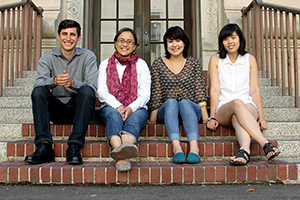
When Karen Andrade, a PhD student in the School of Environmental Science, Policy & Management, came to UC Berkeley in 2009, she was surprised to discover how challenging it was for outside organizations to partner with students and faculty on research projects.
Although local government agencies, like the San Francisco Department of the Environment, where she worked previously, had countless research topics in need of investigation, Andrade saw “there was no formal, institutionalized way for outside organizations to pose their research questions to the university.”
To address what she called this “discrepancy of power,” Andrade and other students applied for and won a BigIdeas@Berkeley award in Spring 2013 to start the UC Berkeley Science Shop, a publicly accessible entity within Cal that connects small nonprofits, local government agencies, small businesses, and other civic organizations with undergraduate and graduate student researchers.
Science Shop is housed in the College of Natural Resources (CNR). Rachel Morello-Frosch, a professor in Environmental Science, Policy & Management, said that’s an ideal place because a commitment to community participatory research already exists. CNR is home to the Cooperative Extension program, where specialists from UC Berkeley, UC Davis, and UC Riverside conduct research and host public outreach activities to help transfer scientific discoveries from the laboratory to the public.
In its first two years, Science Shop has completed research projects with Nature Village, a sustainability group in UC Berkeley’s University Village residencies, and with Salmon Creek Watershed Council in Sonoma County. Science Shop has provided administrative, financial, and project management support to the researchers and free research to the community organizations.
Kareem Hammoud, an undergraduate in the School of Environmental Science, Policy & Management, contacted Andrade after she presented the Nature Village project to his senior thesis class. Nature Village wanted an assessment of the monetary value and sustainability of new shower valves to control and regulate water flow. Hammoud, who planned to write his thesis on the environmental impact of human behavior change, was eager to get involved—and expanded the assessment into a larger social impact project.
From March 2013 to May 2014, he worked with Science Shop and Nature Village to evaluate the effectiveness of education campaigns on sustainability and give feedback on the water saving potential of the valves. Hammoud recruited 100 households in University Village residencies; half received a low-flow valve and the other half did not. In addition to the valves, some households received workshops and handouts on drought, climate change, and water use.
At the end of the one-year project, Hammoud found that those who used the valves experienced savings of 4 percent, compared to households not using the valves—and that the sustainability education increased savings more than 10 percent. Impressed, University Village administrators did more analysis and determined that if they gave each household a shower valve, the residencies would save an estimated $22,500 to $67,600 per year. University Village is currently planning to install more low-flow valves throughout the residencies.
Andrade argues that experiences like Hammoud’s show that Science Shop can challenge students and enable them to interact directly with the people their research is affecting. But this process requires oversight. For that reason, Science Shop assigns graduate student mentors to undergraduate researchers to provide guidance and ensure quality results.
“It is hard to do research for the first time, if you have never done it before,” Andrade said. “Science Shop provides students with as much support as we can, while also giving students ownership over the project and allowing for an empowering research experience.”
Likewise, Science Shop team members have benefitted from guidance and support from the Blum Center for Developing Economies through drop-in advising hours and workshops. Lina Nilsson, innovation director at the Blum Center and Andrade’s mentor, was especially helpful in launching Science Shop by offering expertise in designing and implementing university innovation projects.
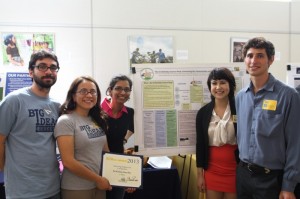
In January 2014, the Salmon Creek Watershed Council connected with Science Shop to understand and map out the relationship between the decline and ultimate disappearance of salmon and the residential development along the Sonoma County creek. Daisy Gonzalez, a UC Berkeley senior majoring in Integrative Biology, was doing research for Cleo Woelfle-Erskine, a PhD student in the Energy & Resources Group, who had worked with the Council for his dissertation and connected Gonzalez to Science Shop and the Sonoma nonprofit.
The Council wanted to understand how water use had changed since the 1800s. Gonzalez spent a six months locating maps of Salmon Creek from the Bancroft Library Archives to generate an analysis of how land use affected water usage. Gonzalez noted that the biggest challenge was transforming the Council’s initial concern into a viable research question.
“I had done research on water before,” said Gonzalez, “but the most difficult aspect of this project was getting out of my comfort zone to find and ask for the resources that I needed.”
Noel Bouck, secretary of the Council, said her organization has displayed Gonzalez’s water usage maps at a local farmer’s market, allowing residents to follow their property as far back to the 1800s. “Working with Daisy has been wonderful, and people can’t resist the maps,” said Bouck, who noted the maps have drawn dozens of people to engage with the Council about the correlations among water usage, land development, and salmon depletion.
Another outcome of the project, said Bouck, is that her organization is connected with new researchers and resources. “One of the most beneficial parts of Science Shop was that it got us access to the UC and all their resources,” she said. “We would never have found the maps or had access to them on our own.”
In addition to aiding local organizations and providing hands-on research experiences to students, Science Shop hopes to increase student retention in the science fields. “People know science is beneficial, but when you are doing it and you write all those papers, you wonder if it will ever reach someone and go out to the world,” Andrade said.
For Gonzalez, who now works for an environmental justice nonprofit in her hometown of Salinas Valley, California, the project with the Council reaffirmed her desire to “serve as a resource to a community.”
Science Shop also operates on the idea that community expertise must be tapped and harnessed. The Watershed Council is case in point; community members there had longtime knowledge of water usage and the creek’s salmon population, and some were former research professors themselves. Since the project with Science Shop began, council members have provided the university with water samples from different aquifers, information which might have future use.
Science Shop is currently working on another project with University Village and Andrade has received over 20 research queries—more than enough to keep the rotating voluntary staff of 10 busy. The main challenge now is to secure more funding and staff to implement more projects. Science Shop recently applied for a two-year, $300,000 National Science Foundation grant to allow the organization become institutionalized in the university, eventually expanding beyond the environmental sciences to other disciplines
“Science Shop is extremely beneficial for people in my field and for scientists in general,” said Morello-Frosch, who guided the organization in applying for the NSF grant. “It’s important to collaborate with communities on scientific projects that require community involvement to both collect data and solve problems.”
The 1,000th Solar Suitcase: Scaling Innovation out of the University
By Tamara Straus
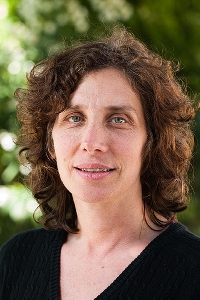
Laura Stachel never meant to be a social innovator. She never imagined working in developing countries. And if you told her 10 years ago, that she and her husband, Hal Aronson, would come to focus on energy poverty in healthcare—and that they would deliver their 1000th “Solar Suitcase” to provide electricity to health clinics trying to recover from the Ebola outbreak in Sierra Leone, she would have looked at you with undisguised amusement.
But this, in an overly simplified way, is what has happened to Stachel over the last five years. In 2008, after a back injury ended her career as an obstetrician, she enrolled at University of California, Berkeley, to earn a master’s degree in public health. An invitation to observe the maternity ward at a state hospital in northern Nigeria came from Daniel Perlman, a medical anthropologist at the university’s Bixby Center for Population, Health & Sustainability. Stachel leapt at the chance to connect her expertise in maternal health to her current studies, and headed to Abuja.
At the Nigerian hospital, as she writes in an essay in the 2013 book The Rise of the Reluctant Innovator, “I was immediately struck by the grim conditions. The labor room had four bare metal delivery tables, a limited collection of obstetric instruments, a newborn incubator that hadn’t worked in years, a broken lamp, two newborn scales in poor condition, and little else. There were no mattresses, sheets, bright lights or monitors characteristic of an American hospital. Most striking were the frequent power outages that left the hospital in darkness, creating an immense barrier to care.”
Stachel was deeply disturbed that the hospital’s frequent power outages meant emergency patient care was delayed, disrupted, or just impossible. And suddenly a statistic—that half a million women die each year in childbirth, 99 percent of them in developing countries—was understandable. She described the desperate hospital conditions in an email to her husband. Aronson, who taught solar energy technology in California, decided the sun could provide electricity to the hospital during outages. And when Stachel returned, they embarked on what could become a lifelong journey to provide portable solar energy solutions to places like the state hospital in Zaria, Nigeria.
Stachel credits UC Berkeley and the Blum Center for Developing Economies as among the main forces that enabled her and Aronson to pursue their ideas and then implement them. “This project has always been part of the university,” she said on a typically busy morning of staff, student interns, and masses of email in her Blum Center office. “We’ve been able to tap into the university’s amazing human resources—faculty advisers in the School of Public Health, the School of Engineering, Lawrence Berkeley National Laboratory, Haas School of Business, and students from across campus. I would never even have been put into a position to see the problems I saw without having the university context of people doing research in Nigeria and exploring maternal mortality through hospital ethnography.”
The Blum Center has provided crucial support from the beginning. When Stachel returned home from Nigeria in April 2008, Aronson worked with her to sketch a design for a stand-alone solar electric system for the Nigerian hospital’s maternity ward, labor and operating rooms, and lab. The problem was how to pay for it. Stachel noticed that the campus-wide innovation contest Big Ideas @ Berkeley, now run by the Blum Center, was advertising a $12,500 prize for a social good technology. But the deadline was less than two weeks away.
Stachel, Aronson, and two students from the School of Information and the Energy & Resources Group, Melissa Ho and Christain Casillas, applied anyway and won a $1,000 honorable mention, not enough to fund the project. Then, a few hours after the winners were announced, Thomas Kalil, a university technology policy advisor who had created Big Ideas, called. “You should have won,” he said. “How much do you need?” Three weeks later, Kalil secured more funding through the Blum Center, whose mission is to alleviate global poverty through education and innovation.
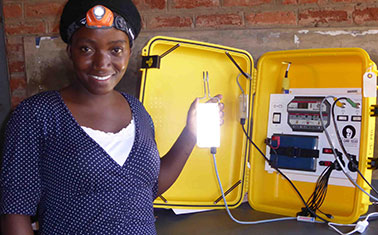 The first year of We Care Solar, as Stachel dubbed the nonprofit, was devoted to developing the solar electric system for the state hospital in Zaria. To prepare for a trip in which hospital workers would give feedback, Aronson placed demonstration solar equipment in a large suitcase for his wife to carry. After she unpacked the suitcase and got the components to work, not only did the head of hospital give approval for the full installation six months hence—an operating room technician by the name of Aminu Abdullahi, said: “You must leave your suitcase here. This will help us save lives now.” The idea for a portable solar system in a suitcase was born.
The first year of We Care Solar, as Stachel dubbed the nonprofit, was devoted to developing the solar electric system for the state hospital in Zaria. To prepare for a trip in which hospital workers would give feedback, Aronson placed demonstration solar equipment in a large suitcase for his wife to carry. After she unpacked the suitcase and got the components to work, not only did the head of hospital give approval for the full installation six months hence—an operating room technician by the name of Aminu Abdullahi, said: “You must leave your suitcase here. This will help us save lives now.” The idea for a portable solar system in a suitcase was born.
When Stachel returned to Nigeria in April 2009 to oversee the larger hospital installation, she saw the fruits of her husband’s work: midwives could perform obstetric procedures throughout the night, doctors and nurses could be summoned quickly through solar-powered walkie-talkies, and patients were no longer turned away for lack of power.
Word spread quickly of We Care Solar’s innovation. After a chance meeting in April 2009 with Nicholas Kristof, the New York Times columnist wrote about Stachel’s successful solar power installation, and the former obstetrician was inundated with requests for similar systems in maternity wards throughout Africa and Asia. “That’s when I realized the need extended far beyond Nigeria,” she said, “and that we needed an intervention that could scale.” Stachel, Aronson, and their small team of volunteers began making portable systems from their Berkeley home, while applying for all manner of fellowships and social innovator contests to make ends meet.
We Care Solar has since won multiple awards from UC Berkeley, including CITRIS’ Big Ideas Award, a Global Social Venture Competition Award, and the Chancellor’s Award for Civic Engagement—as well off-campus recognition from the United Nations Global Citizen Award, the Department of Energy and MIT C3E Award for Advancements in the Developing World, the CBS Jefferson Award for Public Service, and the 2013 CNN Top Ten Heroes Award, among others. Additional support has come from UC Berkeley’s Development Impact Lab, which is funded by the United States Agency for International Development. USAID’s Administrator Raj Shah has cited Solar Suitcases as a lead example of high-impact university innovation.
“We Care Solar is one of UC Berkeley’s social innovation jewels,” said Maryanne McCormick, executive director of the Blum Center. “It rose out of a student innovation contest at Cal and has been nurtured by a constellation of faculty, staff, students, and programs. It’s been an education to see it grow.”
To date, We Care Solar’s staff of six has equipped off-grid medical clinics with power in 17 African countries, 10 Asian countries, and in Mexico, Nicaragua, and Haiti. Solar Suitcases are being used not just to provide medical and surgical lighting in blackouts, but to power cell phones and essential medical devices. In addition to installations in clinics and hospitals, Solar Suitcases also have been used for emergency and humanitarian relief. When the 8.0 magnitude earthquake struck Haiti in 2010, emergency medical providers contacted We Care Solar and Aronson managed to retrofit the suitcase design for the country’s energy needs. After Typhoon Haiyan struck the Philippines in 2013, We Care Solar received funding from the MacArthur Foundation to bring in 100 Suitcases for emergency workers and maternal health centers. In 2014, as Ebola swept through Sierra Leone and Liberia, World Health Organization and ministry of health officials reached out to Stachel for additional Solar Suitcases to power Ebola checkpoint centers and health clinics. Eventually, though a partnership with Direct Relief and three in-country NGOs, We Care Solar sent 15 Solar Suitcases to Liberia and 70 Solar Suitcases to Sierra Leone. Among them, was the 1,000th that We Care Solar manufactured and distributed.
Of course, 1,000 portable solar energy systems is a far cry from the estimated 300,000 that are needed in low-resource clinics and hospitals. On this point, Stachel is not exactly sanguine. “Our goal is to try to get to 5,000 in a few years,” she said, “but I have to say that we had that goal a few years ago. It’s been really humbling to work in foreign countries and to see what’s involved in logistics.”
Stachel continues: “There are people who say, ‘Why aren’t you making 10,000 of these and just sending them out?’ My answer is: We are really sensitive to the fact that the developing world is replete with broken technologies. Training is really important—and training takes time and cultural awareness.”
Stachel used to hand deliver every Solar Suitcase, but that was not scalable. So the nonprofit has been training solar technicians, called “Solar Ambassadors,” to train hospital workers and ministry of health technicians in Eritrea, Ethiopia, Malawi, Sierra Leone, Tanzania, Uganda, and the Philippines. “The most challenging thing is not the training,” said Stachel, “but sustaining the technology. How do you make sure it will work five years from now? By definition, these government health clinics are terribly under-resourced.” Stachel recounts a recent trip to Malawi, where one clinic lacked paper on which nurses could write patient notes. “How is that clinic going to have batteries, when a replacement is needed in two years or five years?”
Like many nonprofits working in poor countries, We Care Solar is obsessed with identifying best practices. Stachel and her team are using their Blum Center funding—and Stachel’s position there as a staff researcher—to explore models for how to get more Solar Suitcases sustainably into the field. The answer, so far, seems to be partnerships. Over the years, graduate students from the Haas School’s International Business Development Program have helped We Care Solar identify international and nation-based healthcare organizations who can share costs and logistics and whose staff can serve as Solar Ambassadors. Current partners include UNICEF, Save the Children, Pathfinder International, World Health Organization, Stiftung Solarenergie Foundation, and many ministries of health—and, due to these associations, the number of installations has been expanding dramatically.
“Right now, we are trying to show a model of what is possible,” said Stachel. “On the one hand, there is no reason that every health center shouldn’t be electrified. We have the technology. On the other hand, priming the ecosystems to accept, install, and be educated on how to use the technology and have a system of maintenance for it, is crucial. If we get enough funding to scale to 300,000 suitcases, we want an ecosystem in place and we want that ecosystem to work.”
Edward Miguel on the Untidy (but Important) Link Between Climate and Violence

An occasional series with Blum Center affiliated faculty
By Tamara Straus
On January 3, 2014, Edward Miguel, the Oxfam Professor of Environmental and Resource Economics and faculty director of the Center for Effective Global Action at U.C. Berkeley, published an article in Science advocating for increased transparency in social science research. The article built on years of inquiry in which Miguel has focused on African economic development, rigorous evaluation methods to test humanitarian interventions, and the interactions between health, education, environment, and productivity for the poor.
In the Science article, Miguel and his co-authors summarized how researchers can improve the quality, credibility, and impact of their work. They also wrote: “Commentators point to a dysfunctional reward structure in which statistically significant, novel, and theoretically tidy results are published more easily than null, replication, or perplexing results. Social science journals do not mandate adherence to reporting standards or study registration, and few require data sharing.”
Miguel is not following this trend. Among the research projects he has pursued over the last decade, and with provision of all data, is the untidy link between climate change and human conflict. In an August 2013 Science article, Miguel and co-authors Solomon Hsiang, a climate economist in the Goldman School of Public Policy at UC Berkeley, and Marshall Burke, an environmental economist from Stanford, quantified the influence of higher temperatures on conflict, bringing together the results of 50 previous studies on the topic.
The reaction was divided. Some social scientists commended their analysis, which found “strong causal evidence linking climatic events to human conflict across a range of spatial and temporal scales and across all major regions of the world.” Others argued the link had considerable shortcomings—even though the authors made clear that rarely is climate change the only factor in increased rates of violence.
Criticism and debate have not stop the three scholars from continuing their analysis. In October 2014, the National Bureau of Economic Research (NBER) published their follow-up study “Climate and Conflict,” which added several more studies to the meta-analysis, confirmed previous findings, and detailed a few more, notably that “temperature has the largest average effect by far, with each 1σ [1 standard deviation] increase toward warmer temperatures increasing the frequency of interpersonal conflict by 2.4% and of intergroup conflict by 11.3%” and that “the 2-period cumulative effect of rainfall on intergroup conflict is also substantial (3.5%/σ).” To better understand the new study as well as how it is affecting social science research, the Blum Center asked Professor Miguel the following questions.
Q: What compelled you and your co-authors to undertake the analysis in the first place?
Edward Miguel: I had been working on this issue of extreme climate and violence since 2002/2003. I wrote papers on large-scale civil war and crime, and a few years after, when I was a visiting scholar at Stanford, I joined forces with Marshall Burke. Sol Hsiang was a grad student at Columbia at the time, working on related things. I think it was Marshall and Sol’s idea to aggregate the studies and say what is the common effect.
It took us about a year to complete the Science paper, with the three of us and a bunch of researchers. And then it was another few months of work for the NBER follow up. When there are a lot of data sets floating around, it takes a lot of effort to keep everything straight. You need to standardize everything, normalize everything. The NBER paper is more current—not just because it includes more studies, but because we break things down into current effects and lagged effects, temperature effects and precipitation effects. So we went deeper into what we were already doing.
Q: What were the biggest surprises?
Edward Miguel: I think it’s interesting that the evidence continues to accumulate from different parts of the world, with different types of violence, yet the patterns remain the same. That’s really the point of putting this together. There really is a striking pattern—and not just in the overall effect of extreme climate on violence, but in that temperature effects seem to be stronger than precipitation effects. Even in rich countries like the U.S., we found that when you have higher than normal temperatures, you have more violent crime.
We feel there’s a pretty strong relationship at this point linking climate and conflict, and there’s an increasing among data to support that link. There have been critiques—people saying, “You guys are lumping together lots of types of violence” [such as domestic violence, road rage, assault, murder, and rape for “interpersonal violence” and riots, ethnic violence, land invasions, gang violence, civil war and other forms of political instability, such as coups, for “intergroup conflict”]. We acknowledge that and we understand that. That’s why we make a distinction between crime and interpersonal violence on the one hand versus more large-scale violence on the other. I do think that it’s striking that whether you’re looking at land invasions in Brazil, or civil war in Africa, or Hindu-Muslim riots in India, you get these similar patterns. There is something deeper going on.
Q: Do you expect scholarship on the link between climate and conflict to grow—and, if so, in what discipline?
Edward Miguel: It’s always been an interdisciplinary effort. The first published paper I wrote on this in 2004 in Journal of Political Economy was with two political scientists. Even Sol and Marshall, my coauthors, in addition to their economics training, have a lot of climate science training—so there’s this intersection of different types social scientists in this area.
The scholarship is certainly increasing. And in the year and a half since the Science paper came out, that paper has been cited about 170 times. That’s because people are looking at it as a benchmark in the literature. To do a meta-study, we had to make a lot of the decisions about how to normalize data and standardize climate variables. Now, all these papers are coming out adopting our approach to normalization and standardization. We are having an effect on the development of the literature, because we’ve made it easier for the different studies across disciplines to speak to each other.
Q: What does the standardization involve?
Edward Miguel: It’s pretty simple. We’re looking at the local distribution of climate variation and then standardizing it. We look at the effect of what’s called the “one standard deviation change” in local climate. For example, Northern California’s climate is very different from the climate of the East Coast, which is very different from the climate of tropical Africa. Year-to-year, we actually have much greater temperature variation here in northern California than in West Africa. Yes, they have high temperatures, but year-to-year they don’t have that much variation in temperature. The more northern latitudes have greater temperature variation.
We take that into account and say, a shift of a few degrees Celsius up in Canada is not a big deal; they’re used to it or have adapted to it. But a shift of three degrees Celsius in West Africa—for the crops that they grow, for their economic activity—is a huge effect. So we allow a certain degree Celsius shift to have a big effect in the places where it is significant and a small effect where it isn’t. This is kind of sensible, but no one had said, “Hey, we can combine all this data by making this assumption.”
Q: What are the policy implications of the climate and conflict meta-study?
Edward Miguel: We certainly want policy makers to react. In the 2014 IPPC [Intergovernmental Panel on Climate Change] Report, two of the chapters cite the Science paper and the authors frame some of their results around it. So I feel our voice is being heard. In terms of what we want people do, we don’t really have a solution. No one really has the answer, because it’s been so hard to adapt to climate change. But what we want is for policymakers to begin the process of figuring out what the right adaptations are.
It’s striking that even the U.S. is not adapting to changing climate. We’re such a rich country, we’ve got great technology, but year to year, especially in a hot year, agricultural production does fall—and we’ve not been able to deal with it. So what are folks in the Sahel region, in West Africa, supposed to do? They don’t have our resources, our technology, and there’s been very little political will. There’s all this discussion of rich countries creating a massive fund to help poor countries adapt to climate change, but it’s mainly talk. So we don’t have the answer, but we hope the research encourages policymakers to seriously try to find a solution.
Mezuri: Eight Questions for Eric Brewer on Data and Development
By Jordan Kellerstrass
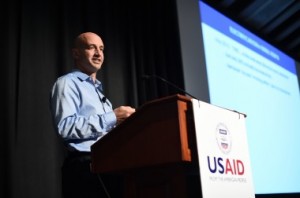 For most of its history, international development has been an inexact science. Validation of development interventions to improve health or economic outcomes was generally unfounded. With the increasing reliance on data to prove that a program is effective, however, the field is entering a new era. Data-centric evidence is becoming the lead arbiter of whether an intervention is renewed or scaled.
For most of its history, international development has been an inexact science. Validation of development interventions to improve health or economic outcomes was generally unfounded. With the increasing reliance on data to prove that a program is effective, however, the field is entering a new era. Data-centric evidence is becoming the lead arbiter of whether an intervention is renewed or scaled.
The continual improvement of technology and the digitization of vast amounts of survey, sensor, network, and other numeric and textual data are promising more reliable, timely information for development actors. At the same time, the ability to use this data well is hampered by the lack of consistency in tools and methodologies for end-to-end data management. The Mezuri team — which includes researchers from UC Berkeley’s Technology and Infrastructure for Emerging Regions (TIER) group, University of Washington, University of Michigan, and Portland State University — are addressing this issue. Together, they are building a cloud-based data management platform to support the entire pipeline — from raw data collection to meaningful, actionable results in the form of visualizations and statistics.
Eric Brewer is a professor of computer science at UC Berkeley, where he leads the TIER group and is Mezuri’s principal investigator; he is also vice president of infrastructure at Google. To provide a deeper sense of the story behind the development of the Mezuri Data Platform, we asked him the following questions.
1. What inspired the idea for Mezuri?
The economic development space has a checkered history, which has led to more intensive efforts to “prove” that an intervention is effective and thus should be scaled up — these broadly fall under the phrase “measurement and evaluation,” or M&E for short. This has led to techniques like randomized controlled trials (RCTs) that really aim to meet this bar of proof. However, such an approach implies a significant data management problem: How do you collect, manage, and protect the data you need?
The tools have been rudimentary, typically just laptops and Excel. The consequences are that it is easy to lose data, hard to share it, and even hard to know what exactly was done to the data since you got it.
Making data management and analysis easy and accurate is the essence of Mezuri.
2. How does your background help guide Mezuri development?
A key aspect of Mezuri is leveraging Cloud computing, which is an area of long-time interest for me (and roughly what I do at Google). The Cloud brings reliable data storage with access control, unlimited processing power, and the ability to share not only data but also best practices. Finally, done well, it provides ease of use, as users only need web access to participate and not their own servers or even data centers.
3. Who all is developing Mezuri? How did they come together?
I tried to pull together the best groups I could from around the country to form the whole solution. University of Washington has done a great job with Open Data Kit, which is the basis for the survey aspects of Mezuri. Evan Thomas at Portland State has done the most work with real users (e.g., economists and NGOs) and real data with his SweetSense data collection system; his field experience is particularly valuable. Colleagues at University of Michigan [Lab11] are experts in novel sensors and high-volume, real-time data collection. Bringing these elements together is not easy, but I love the team we have.
4. Why is this possible now? How is this project part of the story of computer science?
The two big enablers for us are the Cloud for scalable data storage and computing, and the rise of mobile phones, especially smart phones, which enable high-quality surveys and data collection pretty much anywhere in the world. These two together will change not only the practice of “development” but are also one of the greatest shifts not only in computing, but in the history of the world. The impact of phones has already been remarkable, but I think the Cloud will be bigger (unless they are viewed as one transition in the end).
5. What is Docker and what role does it play?
Docker, at its core, is a change in the level of abstraction of Cloud computing. Traditionally, the basic unit of abstraction was the “virtual machine” — it is as though you have a raw server and you need to install an OS and applications, and then maintain the OS. This is a high burden, even for computer scientists. The new abstraction is the “container,” which is a bundle of applications that fit together well and that can be created once and then reused easily by many. The details of the machine and OS matter less, and users can pick containers that have the software they need (and already know how to use).
6. Who will benefit from a system like Mezuri?
The immediate target audience is social scientists and economists that need to manage data well as part of their research. This should lead initially to better data management and later to more aggressive evaluations that include more kinds of data and that mix surveys and sensors well. However, the real goal is to benefit those in developing regions, by making better investment decisions due to better data.
7. How does Mezuri enable or encourage data sharing?
First, just having data safely in the Cloud is a good start — that is the easiest path to sharing, similar in spirit to Dropbox and Google Docs. Because some of this data has important privacy risks, the key to sharing is actually being able to limit the sharing to just those that should have access. We can also share data at different levels of processing and summarization: often we can share the anonymized or aggregated data, but not the raw data. Finally, it is equally important to share the workflows, that is, the template of processing steps necessary to convert raw data into knowledge. Sharing workflows enables formal review of processes, sharing of best practices, and also enables repeatability.
8. What are the short and long term visions for Mezuri?
In the short term, we need to get real users to collect, manage, and analyze data using the system. This will teach us a great deal about what the real requirements are and what we need to do to make the system sufficiently useful in practice. Long term, I hope to see Mezuri emerge as the de facto way to do data management for the social sciences and a key part of better decisions around how to best spend the world’s development money.
—
Jordan Kellerstrass is a PhD student in computer science, a researcher in the Technology and Infrastructure for Emerging Regions (TIER) group, and a member of the DIL Idea Team.
Fighting for the Last Mile of Women’s Rights: The Head of UN Women and UC Berkeley Gender Scholars Look Toward 2015-2030
By Sybil Lewis
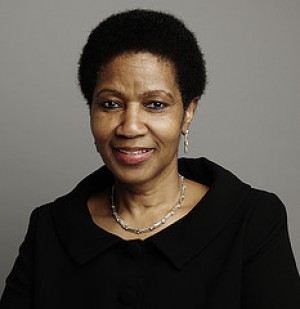 On Dec. 9, Dr. Phumzile Mlambo-Ngcuka, UN Undersecretary and Executive Director of UN Women, attended a panel at UC Berkeley’s Blum Center for Developing Economies with leading gender academics to discuss the state of affairs for women and girls around the world.
On Dec. 9, Dr. Phumzile Mlambo-Ngcuka, UN Undersecretary and Executive Director of UN Women, attended a panel at UC Berkeley’s Blum Center for Developing Economies with leading gender academics to discuss the state of affairs for women and girls around the world.
Titled “Gender for a New Century: Countering Violence and Social Exclusions,” the event served as an opportunity for academics and policymakers to engage in dialogue and marked Mlambo-Ngcuka’s first formal visit to an American university.
“Our knowledge about gender has moved so far in the last 30 years, even though many of the problems remain the same,” said Raka Ray, Professor of Sociology and South and Southeast Asian Studies and an affiliated faculty member of the Blum Center for Developing Economies. “Strangely, there has not been enough sustained conversation between those who produce knowledge about gender and those who create global policies around gender.”
The event was part of a worldwide 16 Days of Activism Against Gender Violence that started on Nov. 25, the International Day for the Elimination of Violence against Women.
Nine distinguished UC Berkeley female faculty members from various departments and centers, ranging from Law to Gender and Women Studies, presented different forms of violence and discrimination against women that reflect the intersectionality and complexity of gender-based problems.
Panelists brought attention to gender problems around the world, including the lack of protection for female migrant workers, the alarmingly high rates of sexual assault against disabled women, and cultural values that normalize violent traditions, such as female genital mutilation. The panel also addressed forms of non-physical violence and discrimination, such as policies that are constructed without recognizing women’s physical needs and others that alienate those that fall outside the gender binary.
“You cannot understand gender in isolation; you also cannot understand class, race, and all the other dimensions of oppression and inequality without understanding how they work in and through one another,” said Gillian Hart, Professor of Geography and Co-Chair of Development Studies. “This is one of the absolutely crucial challenges that we are facing in the world today.”
Mlambo-Ngcuka responded to questions posed by faculty members on the ways that the UN and transnational policy can address violence against women and social exclusion, while also noting challenges and limitations within the UN.
For instance, she shared concerns brought up by Professor of History Tabitha Kanogo about the dangers of universal gender goals and the importance of local variations. “When we want to target differences and not apply a one-size-fits-all solution, we have to allow for differentiation; but there are times when that is not an appropriate stance to take and we have to insist on universality,” said Mlambo-Ngcuka. She mentioned the ways in which national sovereignty arguments are used to avoid implementing human rights legislation. “Nationalism is sometimes a refuge for scoundrels.”
UN Women was created in July 2010 to promote gender equality and the empowerment of women and is the UN’s youngest agency. Thus far, the institution has spearheaded several campaigns, including HeForShe and UNiTE to End Violence Against Women.
Mlambo-Ngcuka and her colleagues’ appearance at UC Berkeley coincided with visits to Silicon Valley technology companies, such as Apple, Mozilla, Twitter, Facebook, and others, to start a dialogue about how technology leaders can promote UN Women’s agenda and goals. Cheryl Sandberg, Chief Operating Officer of Facebook, originated the invitation to Mlambo-Ngcuka, who served as Deputy President of South Africa from 2005 to 2008.
Lopa Banerjee, Chief of UN Women’s Civil Society Section, said the meetings aim to find ways to increase women representation in positions of power and to look at how data can be used to better understand gender issues.
“We need to begin the conversation on how Silicon Valley marginalizes gender,” Banjeree said. “The Internet is mostly defined by the users, but [social media company] owners also have a responsibility to be conscious of the politics of that space.”
Mlambo-Ngcuka identified economic participation, particularly in leadership positions, and violence against women as areas where countries have underperformed the most.
UN Women is preparing for the 59th session of the Commission on the Status of Women in March and the UN General Assembly in September to discuss post-2015 development goals. Mlambo-Ngcuka stated that UN Women is working to improve and build on goals established in the 1995 Beijing Declaration and Path for Action, whereby member countries agreed to address 12 areas of concern affecting the lives of women and girls.
While the Beijing goals are not perfect, UN Women will not discard them. Rather, the agency seeks to modify the goals, to minimize the risk of them being “chipped” away. “We have relative control of the Beijing goals and need to sell them as a package to the member states,” Mlambo-Ngcuka said.
Mlambo-Ngcuka ended her talk by calling on campuses to mobilize in the fight against gender inequality and violence against women. Specifically, she would like university scholars to provide more research and data about women and girls “to help surmount the trivialization of women’s issues.” Said Mlambo-Ngcuka: “The UN is not going to win the struggle, the people will—and the people will do that in the streets. Therefore, mobilizing is critical and we need students and the intelligentsia to speak much louder.”
Mlambo-Ngcuka called the next 15 years, 2015-2030, a critical period for women’s rights internationally. “I would like us to see this period as the last mile. We are going to intensify the struggle of hundreds of years. We should not, however, see this as an open-ended struggle,” Mlambo-Ngcuka said. “In Portuguese we call it ‘A Luta Continua’ (the struggle continues), but it must end at some point.”
Full list of panelists:
Aihwa Ong, Professor of Anthropology and Southeast Asian Studies, University of California, Berkeley; Catherine R. Albiston, Professor of Law and Sociology, University of California, Berkeley; Juana Maria Rodriguez, Professor of Gender & Women’s Studies, University of California, Berkeley; Tabitha Kanogo, Professor of History, University of California, Berkeley; Isha Ray, Associate Professor, Energy and Resources Group and Co-Director of Berkeley Water Center, University of California, Berkeley; Gillian Hart, Professor of Geography and Co-Chair of Development Studies, University of California, Berkeley; Charis Thompson, Chancellor’s Professor and Chair of Gender & Women’s Studies, University of California, Berkeley; Raka Ray, Professor and Chair, Sociology; Professor, South and Southeast Asian Studies, University of California, Berkeley; Marsha Saxton, Research Director, World Institute on Disability; Lecturer, Disability Studies Program at UC Berkeley
Beyond Providing Clean Water: A Profile of Development Engineer Syed Imran Ali
By Tamara Straus
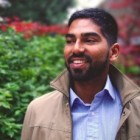 In August 2010, while floods from monsoon rains covered a fifth of Pakistan, Syed Imran Ali, an environmental engineering PhD student from University of Guelph, sat in a newly built lecture hall at the Indian Institute of Technology in Madras. Ali was in South India to research safe water systems in slums—and, as is typical in academia, a visiting professor had come to give a lecture and graduate students were expected to fill the hall. The lecture, by a Purdue University professor, was on a stochastic method to predict floods, and as Ali sat there, his demeanor, characteristically courteous, attentive, and collegial, started to shift.
In August 2010, while floods from monsoon rains covered a fifth of Pakistan, Syed Imran Ali, an environmental engineering PhD student from University of Guelph, sat in a newly built lecture hall at the Indian Institute of Technology in Madras. Ali was in South India to research safe water systems in slums—and, as is typical in academia, a visiting professor had come to give a lecture and graduate students were expected to fill the hall. The lecture, by a Purdue University professor, was on a stochastic method to predict floods, and as Ali sat there, his demeanor, characteristically courteous, attentive, and collegial, started to shift.
“I started to think: I don’t know what you’re talking about, and I don’t think anyone else in this room knows what you’re talking about,” said Ali, now a postdoctoral fellow at UC Berkeley’s Blum Center for Developing Economies. “Moreover, I began to think: I don’t care. Talking about forecasting floods—when there was a flood next door and people were dying in it—was just untenable.”
Ali went back to his office, turned on his computer, and began calling NGOs, government agencies, and UN offices, offering his water and sanitation expertise to help respond to cholera outbreaks in Pakistan displacement camps. He was told he would need to formally apply, and he was told he would need to be interviewed, and he was told he would need to be approved before being sent into the field. He also sowed confusion when he explained his background: a Canadian engineer, of Pakistani origin, working in India, seeking to go to Pakistan, India’s enemy, to help with the flood.
Finally, Ali got hold of the number for the Pakistan headquarters of Médecins Sans Frontières (MSF/Doctors Without Borders) and found himself on the phone with the head of mission, an Italian nurse, “who was totally frazzled.” “He asked me,” said Ali, “whether I could work a water treatment unit. I told him I could figure it out. He told me to send him my CV. That evening, I had a phone conversation with MSF in London, and two days later I was flying to Pakistan.”
Ali’s job was to set up a water treatment unit, to supply safe water to one of the many camps for internally displaced persons in Sukkur, Pakistan. Sukkur had been the third largest city of the Sindh province, but by the time Ali arrived in August 2010 the Pakistani army was evacuating 350,000 people from low-lying areas and bringing them to the higher grounds of what would become a refugee city of half million. Ali was told an experienced WASH (water, sanitation, and hygiene) specialist from MSF would supervise his work. But the specialist got held back at another camp with a cholera outbreak, so the 26-year-old had to wing it. “It was sort of like Lego,” said Ali of his experience assembling the MSF equipment entirely from manuals. He worked there for five weeks, treating river water and training local staff to operate the water treatment plant.
Since that time, Ali has grappled with what it means to be a development, or humanitarian, engineer. His dissertation, published in 2012, was not typical of an academic engineer. Instead of focusing only on new techniques for efficient and safe water systems for South Asian slums, he questioned the moral and political complexity of their implementation. Ali advocates a “participatory design” approach, in which technicians like himself collaborate with “users” (in his case, slum residents), to come up with sustainable and contextually appropriate solutions to water and sanitation systems.
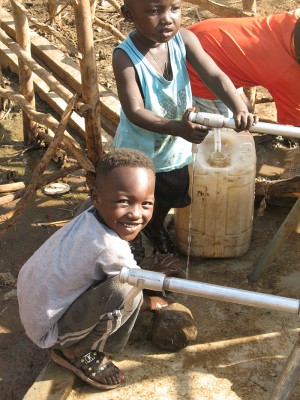 The impetus for this has come from deep reading of post-colonial scholars like Frantz Fanon and Paulo Friere. It also has come from the four on-and-off years Ali spent in a slum called Mylai Balaji Nagar on the outskirts of Chennai, India. There, about 10,000 residents continue to rely on highly polluted surface water. Ali first showed up in the ramshackle sprawl of a town in 2009, as part of a University of Guelph-IIT project that he started. His goal was to remove contaminants from the water system, which was drawn from a polluted lake and was pumped, often untreated, into standpipes where it was used for bathing, food preparation, and drinking. But the longer he stayed in Mylai Balaji Nagar, the more Ali learned that the residents’ views of clean water did not necessarily cohere with his or his university colleagues.
The impetus for this has come from deep reading of post-colonial scholars like Frantz Fanon and Paulo Friere. It also has come from the four on-and-off years Ali spent in a slum called Mylai Balaji Nagar on the outskirts of Chennai, India. There, about 10,000 residents continue to rely on highly polluted surface water. Ali first showed up in the ramshackle sprawl of a town in 2009, as part of a University of Guelph-IIT project that he started. His goal was to remove contaminants from the water system, which was drawn from a polluted lake and was pumped, often untreated, into standpipes where it was used for bathing, food preparation, and drinking. But the longer he stayed in Mylai Balaji Nagar, the more Ali learned that the residents’ views of clean water did not necessarily cohere with his or his university colleagues.
Through interviews and focus groups, Ali gleaned a couple of key details: that the residents of Mylai Balaji Nagar had been forcibly moved there in 1995 to make way for the city’s railway expansion; that the government had never consistently supplied adequate or clean water to the area; and that residents considered water and sanitation services to be a government, not a community or individual responsibility. Ali also learned that everything that the community had managed to get in terms of education, health, or housing supports—had come from lobbying the government.
“I came to realize that much of my work in Mylai Balaji Nagar was what University of Toronto Anthropology Professor Tania Li calls ‘rendering technical,’” explained Ali. “Residents viewed the water supply as the responsibility of the government and they demanded water and other rights through collective political mobilization and direct action. Often, they won. But we engineers were focusing on doing water treatment with residents at the household level.
“You see,” continued Ali. “I rendered technical the water supply problem at Mylai Balalji Nagar. And in doing so, I submerged the political economy of water in this community’s history.”
Ali defines rendering technical as stripping a phenomenon of its complex social, political, and economic realities and distilling it to just its technical aspects. He said people in international development do this for two reasons: “One, we are technical experts and see the world through the framework of the solutions we have to offer; and two, it gives us something to do.” Ali adds to this list a third reason: human fallibility, especially in crisis situations.
In September 2012, Ali enlisted for a second humanitarian crisis. He joined an eight-month mission with Doctors Without Borders in South Sudan, where the newly independent country was being overwhelmed with refugees escaping years of violent clashes. Ali’s job was to implement emergency water treatment systems in refugee and transit camps, manage water and sanitation infrastructure and staff in MSF healthcare facilities, and lead camp sanitation building projects. He was witness to a severe health crisis at a camp called Jamam on the Upper Nile state of South Sudan, to which 30,000 people had fled. Jamam, which means “swamp” in Maban, was picked in haste by authorities of the United Nations High Commissioner for Refugees (UNHCR) and in part because it was 50 km from the Sudanese border, a UNHCR requirement. The place lived up to its name. When the rainy season hit in May, the camp flooded and diarrheal illnesses and hepatitis E overwhelmed the refugee population.
Ali and his colleagues worked tirelessly. In a Jan. 29, 2013 MSF blog, he wrote: “I’ve stopped thinking. The last time I stopped to think something out, to parse it, to give it a name, was months ago …. [Yet] I had a home that was not this place, this strange, inhospitable, impossible place that is now home for 15,000, 65,000, 115,000 people, who had to run here, and from where it seems like they won’t leave for a long time still, for the abode of war still reigns in their hills.”
Among the reasons that Ali’s brain was functioning only for emergency purposes was because by January he was also working in a nearby refugee camp called Batil, which had become home to 35,000 people and where a third of the camp had no sanitation services. The result was another large hepatitis E outbreak from so many people defecating outside. “There’s a structural problem in the humanitarian system,” said Ali in response to why the story of aid seems often to be one of failure. “There’s no feedback mechanism. No one in the field has the capacity, because they’re always reacting.”
But Ali has found a way to provide feedback. During his time at the Jamam refugee camp, he realized that chlorination levels for camp water systems were based on standards for municipal water systems with sophisticated infrastructure—even though a refugee camp is radically different from a city. To deal with the daily reality of sick and dying people, Ali began to study how free residual chlorine in water behaved in the refugee camp setting. He soon discovered that it was inadequate—that within four to six hours of collection, the chlorine was mostly gone. He set out to correct this oversight.
Ali’s current work at the Blum Center may very well rewrite the UN guidelines for refugee camp water systems, protecting upwards of 50 million people. “This project will help to build the evidential base for safe water practices in humanitarian settings, something which is almost totally lacking at present,” said one of Ali’s mentors, Ed McBean, a professor of engineering at University of Guelph, who holds the Canada Research Chair in Water Supply Security. “The work will improve best practices for safe water supply in emergencies the world over.”
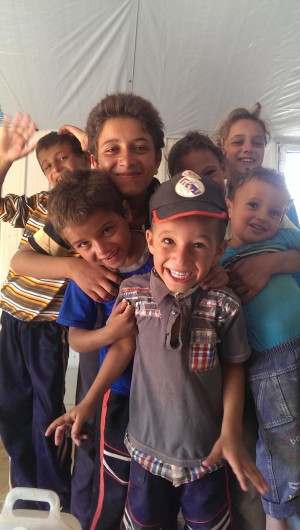 Last summer, in collaboration with UNHCR, Ali collected chlorination level data at the Azraq refugee camp in Jordan, and in 2015 he will do the same at two more sites, in Rwanda and Jordan, and take data during the winter to observe any seasonal effects. By 2016, he expects he will have analyzed and generated a revision document for varying refugee camp conditions, which can feed directly into the UNHCR guidelines. Ali does not expect implementation will be difficult, as his work is “an evidence-driven improvement of existing practices.”
Last summer, in collaboration with UNHCR, Ali collected chlorination level data at the Azraq refugee camp in Jordan, and in 2015 he will do the same at two more sites, in Rwanda and Jordan, and take data during the winter to observe any seasonal effects. By 2016, he expects he will have analyzed and generated a revision document for varying refugee camp conditions, which can feed directly into the UNHCR guidelines. Ali does not expect implementation will be difficult, as his work is “an evidence-driven improvement of existing practices.”
When Ali tells people about his discovery at the Jamam camp, they tend to be shocked. How could humanitarian organizations overlook something so simple as low chlorination levels in water? Isn’t chlorine in water the most well-known and well-used means to ensure water is safe to drink and use? “I think it’s been the accidental engagement of academic researchers like myself in the field that have encouraged this,” said Ali. “People in the field have already always known [about chlorination problems], they just haven’t had the chance to study it and push it.” Ali adds that the negative consequence of higher chlorination levels is poor taste and odor. The balance is to have just enough chlorine to protect the water, but not so much to drive rejection of the water.
When it comes to the larger questions and goals of international development—the eradication of extreme poverty, safe drinking water and sanitation for all, universal access to maternal health—Ali’s humanism and historicism seems to outweigh his optimism. “The 19th century Prussian general and military theorist Carl von Clausewitz, once remarked, ‘War is the continuation of politics by other means,’” he said. “Since the Marshall Plan and the early years of the Cold War, I believe that development has become the continuation of politics by other means.” Ali does not believe that international development practitioners are doomed to come up with only short-term solutions that avoid the systemic political factors that underlay poverty. But he believes that they, and he, must tread carefully.
“I understand why we’ve moved away from large-scale development,” said Ali. “We’ve been humbled by the technical failures of the 1960s, by the macro level approach. So we’re now looking at development through a micro level. We can’t change the macro conditions of global health, so we create a device that improves healthcare access to rural clinics. In that way, we’re doing a lot of little things and, especially as engineers, we’re doing these things without any real literacy about the sources of the problems.”
Ali hopes a corrective to this problem—to the problem of “rendering technical”—will come through the new field of Development Engineering, which began offering classes to graduate engineering students at UC Berkeley in the fall of 2014. Development Engineering, he argues, is different from traditional engineering in that the field aims to re-center technical issues, like clean water provision, within the larger contexts of political economy and society.
“Introducing non-technical elements in my engineering training was really difficult at first, but I saw it as necessary,” said Ali. “Working with non-engineers was confusing initially, because I didn’t quite understand their language,” he continued, “but there was something important there that I needed to understand. It challenged me to go beyond my own technical lens and learn to see from perspectives of new fields.
“Working across disciplinary divides requires intellectual humility. But it’s given me ideas about how we can use technical solutions to address development challenges in solidarity with the people we aim to help.”
Teaching Leadership, Female to Female
A Device That Could Change Healthcare
By Tamara Straus
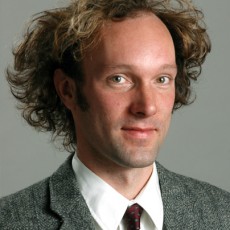 There are three innovations without which, CellScope—a breakthrough microscopy project of Dan Fletcher’s bioengineering lab at UC Berkeley—would not be possible. They are also part of landscape of innovations that may revolutionize global healthcare.
There are three innovations without which, CellScope—a breakthrough microscopy project of Dan Fletcher’s bioengineering lab at UC Berkeley—would not be possible. They are also part of landscape of innovations that may revolutionize global healthcare.
The first is the 3D printer. Before these printers were mainstreamed, students in Professor Fletcher’s lab assembled prototype mobile microscopes from sheets of plastic that had to be cut and glued by hand. New engineering designs usually took weeks and were difficult to modify quickly. With the lab’s Stratasys 3D printer, polished prototypes are now being created in as little as a day.
The second innovation that seeded Fletcher’s leap forward in microscopy is energy-efficient LED lights. Whereas traditional microscopes rely on powerful arc lamps that cost $200 per bulb and burn less than 300 hours, the CellScope uses long-lasting LEDs that cost as little as $2.50 per bulb, provide up to 20,000 hours of use, and function on battery power in areas with unreliable electricity.
The third and probably most important innovation on which CellScope depends is the mobile phone. CellScope has been able to piggyback on tens of billions of dollars of R&D investment by cell phone companies, which have resulted in, among other things, powerful built-in cameras and the mass production of affordable components. As Fletcher pointed out in a Sept 20, 2013 Wall Street Journal op-ed:
“New phones with larger screens and better cameras may not markedly improve our lives, but the push for more powerful devices—and manufacturers’ willingness to respond to demand—is on track to improve the lives of millions of people living in extreme poverty. That’s because customers set on having the latest, greatest smartphones are driving a dramatic decrease in cost and increase in functionality that will benefit people whose total annual income is often less than the cost of a single phone.”
Back in 2006, when one-megapixel cameras started appearing on phones, Fletcher challenged students in his Optics and Microscopy class to see if the camera of a cell phone could be modified to capture images of human cells similar to those captured on his lab’s $150,000 research microscope. Continuing the project the summer after the class ended, Fletcher and a group of students attached a standard set of lenses to his sister’s Nokia phone and were able to image blood cells, malaria parasites, and the bacteria that causes tuberculosis. It was one of those moments that scientists dream of.
“We had discussions, during the course, with doctors about how broadly microscopy is used in clinical medicine, particularly in the developing world. I hadn’t realized that basic optical imaging is still so important to disease diagnosis and that the most definitive diagnosis for many diseases is seeing the actual disease-causing agent in a patient sample,” said Fletcher. “That’s when I realized that if we could do microscopy properly on a mobile phone, the device could be very useful.”
Not only was the potential for disease diagnosis outside of hospital infrastructure considerable, Fletcher and his team knew that mobile manufacturers were in a race to integrate phone cameras with computation, SMS, email, Internet access, and friendly user interfaces. In a few short years, this would mean that CellScope could provide diagnostic solutions at pretty much the same rate as any digitally enhanced microscope in a well-equipped hospital.
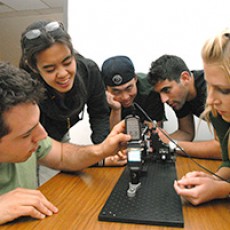 Members of the Fletcher lab could even foresee a time when patients’ blood or sputum smears could be imaged with a mobile digital microscope and then—using a computer algorithm for automated disease detection—proceed immediately to treatment, without the patient stepping foot in a city hospital or medical lab. It would mean, for example, that tuberculosis, which annually kills more than 2 million people and sickens approximately 15 million, could be tackled in places where laboratory facilities are scarce but mobile phone infrastructure is extensive. It would mean that a new point-of-care diagnostic was possible for many diseases that go undiagnosed in many countries, ranging from debilitating eye disorders to chronic blood parasites.
Members of the Fletcher lab could even foresee a time when patients’ blood or sputum smears could be imaged with a mobile digital microscope and then—using a computer algorithm for automated disease detection—proceed immediately to treatment, without the patient stepping foot in a city hospital or medical lab. It would mean, for example, that tuberculosis, which annually kills more than 2 million people and sickens approximately 15 million, could be tackled in places where laboratory facilities are scarce but mobile phone infrastructure is extensive. It would mean that a new point-of-care diagnostic was possible for many diseases that go undiagnosed in many countries, ranging from debilitating eye disorders to chronic blood parasites.
The Fletcher Lab began making its case for the potential impact of CellScope slowly, as it was a side project in a lab focused on making cutting-edge biophysical measurements of cells. In May 2007, CellScope won a Big Ideas@Berkeley award of $8,500, and in January 2008 it received a $100,000 grant from Microsoft Research. By May, The Economist, ABC, Wired, and other media had picked up news of CellScope. In April 2009, the team won another $100,000 grant from Intel’s Inspire-Empower Competition, followed by support from the Vodafone Americas Foundation. And in July 2009, it published its first academic journal paper—in PLoS ONE, documenting how CellScope captured images of the parasite that causes malaria in humans, the bacteria that causes tuberculosis, and sickle-shaped red blood cells. The team also showed in a 2012 National Institutes of Health paper how their images of tuberculosis bacteria could be automatically counted using image recognition software.
By 2011, CellScope had raised a total of $500,000, thanks to additional grants from the Bill & Melinda Gates Foundation, UC Berkeley’s Blum Center for Developing Economies and the Center for Information Technology Research as well as the Vodafone Americas Foundation, and was ready to field test its first device.
Its first large field experiments took place at health clinics in Hanoi Province, Vietnam. In partnership with the Vietnam National Tuberculosis Program and the University of California, San Francisco, Fletcher’s group deployed 15 CellScopes for a full year, to evaluate their uptake and ability to detect TB at health care facilities with little medical or IT infrastructure. The Hanoi Province pilots showed that community health care workers were able to operate the CellScope and that disease diagnosis met the standard quality available at major Vietnamese hospitals. This work motivated development of a second generation device that is being tested in Hanoi.
Recently, another CellScope device was field-tested in Cameroon where the Gates Foundation and the U.S. National Institutes of Health had been struggling to find a way to restart mass drug administration programs to fight the roundworms that cause river blindness and lymphatic filariasis. The problem health workers faced was that patients were at risk of serious health complications, including death, if they were given river blindness medication while co-infected with the Loa loa worm. But to test for Loa loa, health workers needed to draw several milliliters of blood and prepare two blood smears for observation under a traditional microscope—costly and time-consuming steps impossible to carry out across the country. Health programs were basically stuck; they could not proceed with large-scale treatment.
Then in February 2014, CellScope trials of 120 people proved adept at counting Loa loa worms, using only a finger prick of blood and a few minutes of analysis time. The trials also validated CellScope’s automated detection of worms in whole blood, and thus the elimination of time-consuming lab diagnosis. Larger tests involving thousands of patients are planned for 2015.
“The Loa loa trials may be the ones that allow us to bring the CellScope to scale in developing regions,” said Clay Reber, a UC Berkeley master’s student in bioengineering who has been on the CellScope project since 2010. “They could show that the CellScope meets conventional diagnostic methods and will be cheaper and easier to use than current methods. They could enable the much-needed mass drug administration programs against river blindness to restart. Worldwide, there are 130 million people at risk of being infected with the river blindness worms and about 13 million people with Loa loa.”
Another testing ground for CellScope devices is Thailand, where there are only 648 ophthalmologists for the entire country (1.52 doctors per 100,000), with most located in the urban centers of Bangkok and Chiang Mai. Cytomegalovirus (CMV) retinitis, which disproportionally affects HIV patients and can lead to blindness, is treatable, but infection rates are high and diagnosis rates are low. Since 2012, community health workers and other non-specialists have a half dozen Ocular CellScopes to test their utility for patients at risk of CMS. Results are forthcoming.
Professor Fletcher admits it’s challenging to address the many diagnostic opportunities that CellScope could address simultaneously. “The key,” he said, “is great collaborators—great clinical collaborators who have embraced the technology, contributed to its design and implementation, and allowed us to plug into existing field studies and test sites with this alternate technology.”
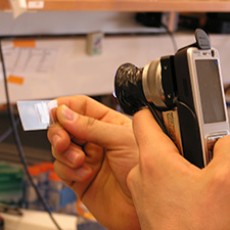 With so many potential applications and field tests for CellScope, it is no wonder that the team has at times felt overstretched. CellScopes have been sent and used literally around the world. In Hawaii, the education nonprofit Kahi Kai is using the mobile microscopes to collect data for various water quality indicators, such as plankton. In Egypt, Dr. Annika Guse of Heidelberg University took CellScope for coral reef monitoring. There is even a CellScope in Antarctica, and Parisian artist Geneviève Anhoury is opening a show this December using images taken with a CellScope.
With so many potential applications and field tests for CellScope, it is no wonder that the team has at times felt overstretched. CellScopes have been sent and used literally around the world. In Hawaii, the education nonprofit Kahi Kai is using the mobile microscopes to collect data for various water quality indicators, such as plankton. In Egypt, Dr. Annika Guse of Heidelberg University took CellScope for coral reef monitoring. There is even a CellScope in Antarctica, and Parisian artist Geneviève Anhoury is opening a show this December using images taken with a CellScope.
Perhaps the strongest example of CellScope’s wide applicability and embrace is its for-profit spinout, CellScope, Inc. In June 2013, Khosla Ventures invested $1 million in the company founded in 2010 by Erik Douglas and Amy Sheng, two former students of Professor Fletcher’s. Since then, the company has secured additional funding on the promise it will create a “smartphone-enabled digital first aid kit.” CellScope Inc.’s first product is an iPhone otoscope that enables parents and physicians to remotely diagnose ear infections in children, an ailment that results in an estimated 20 million U.S. doctors visit per year. The release date for the otoscope is set for 2015. Douglas said 800 doctors and clinicians have been testing it since last December, and 100 California families have been using the device at home.
For Fletcher, the CellScope represents not so much new science as a new approach to the old problem of disease diagnosis, one that moves clinical microscopy forward by solving integration, implementation, and usability challenges. “I think it’s really exciting to see how a technology that has come from an academic lab, was created on a 3D printer, and is intended for use by minimally skilled healthcare workers can help someone in a developing region receive better healthcare and maybe even help seed an industry here in the U.S,” he said. Fletcher has no objections to the domestically oriented for-profit spinout, but hopes “there is continued attention—and funding—to support solving the often very different healthcare problems of developing countries with these devices.”
Fletcher’s mind tends toward scientific skepticism, toward the need for real-world proofs and repeatable results. But he is willing, after some urging, to forecast his device’s possible impact. “My hope is that CellScope will present a new way of delivering healthcare,” he said. “It has the potential to provide much faster access to disease diagnostic information as well as more regular information about our own healthcare. Our technology is part of a fundamental change in healthcare that will see each of us able to take much better care of ourselves by collecting and analyzing personal health data with devices like mobile phones. And CellScope is just one device in that direction. The mobile healthcare revolution has begun.”
Crawling the Campus for International Development Innovations
By Sybil Lewis
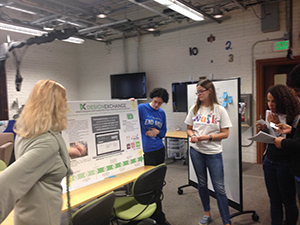 A dozen UC Berkeley graduate students eager to learn about different campus initiatives on international development participated in the second “Innovation Crawl” Nov. 20, hosted by the Development Impact Lab (DIL) and the Blum Center for Developing Economies.
A dozen UC Berkeley graduate students eager to learn about different campus initiatives on international development participated in the second “Innovation Crawl” Nov. 20, hosted by the Development Impact Lab (DIL) and the Blum Center for Developing Economies.
With the support from the U.S Agency for International Development, DIL hosts events such as the Innovation Crawl and funds projects that are at the intersection of technology and international development. The Innovation Crawl was organized by DIL’s Idea Team—a group of interdisciplinary graduate students dedicated to bringing together students, researchers, and faculty working on international development and promoting cross-campus exchange.
“Top-tier research, professional development, and graduate initiatives in international development are going on across this campus, but the average individual misses them,” said Pierce Gordon a member of the DIL Idea Team and MS/PhD Student in the Energy and Resources Group. “DIL’s Idea Team, which was founded last year, aims to gather the communities passionate about global poverty issues and to introduce the great work being completed on this campus.”
Participants at the Innovation Crawl come from diverse interests, countries, and disciplines. They included Master’s and PhD students in Public Health, Business Administration, the School of Technology, Development Practice, and Public Policy.
“The university, like much of the world, operates in silos. For someone like myself who is on the policy side of social issues, I see the importance of understanding what everyone is doing in different departments,” said Sasha Feldstein, a first year Masters of Public Policy student at the Goldman School of Public Policy.
Inspired by the spirit of “bar crawls,” the Innovation Crawl included a tour of four labs and centers on campus.
The first stop was the Center for Information Technology Research in the Interest of Society (CITRIS), which focuses on four core initiatives—Energy, Health Care, Intelligence Infrastructure, and Data and Democracy—to address pressing social and environmental issues facing California. Brandie Nonnecke, a research and development manager of the Data and Democracy core, presented the California Report Card, an online platform that allows visitors to grade the state’s performance on policy issues such as immigration and higher education. The report card was developed by CITRIS in collaboration with the office of Lt. Governor Gavin Newson to harness technology for increased democratic participation.
The group crawled onward to the Berkeley Institute of Design, where Mechanical Engineering Professor Alice M. Agonino showed different human-centered, interdisciplinary design projects, ranging from data collection on Massive Open Online Courses to sustainable design projects in Native American communities.
The final stop was at the Visualization and Control of Biological Assembly Lab, also known as the Fletcher Lab, where students got a first-hand look at tools being engineered to improve the landscape of disease diagnosis around the world. Frankie Myers, a research scientist at the Fletcher Lab, presented CellScope, a technology that turns the camera of a mobile phone into a high-quality light microscope to image patient samples and diagnose diseases such as tuberculosis. Ali Mohammed, a Somali healthcare practitioner who attended the Innovation Crawl, said that in his home country devices such as CellScope could be crucial, as many deaths occur from curable diseases that are not diagnosed due to lack of equipment, energy, or trained medical professionals.
The DIL Idea Team plans to have more Innovation Crawls that are tailored to themes such as sustainability and health and that address the changing field of international development.
What Will the Children of Madagascar Inherit?
By Roxanne Rahnama
There is a local Malagasy proverb in the southeast Anosy region of Madagascar that goes Ny fianarana no lovasoa indrindra: Education is the best heritage.
In this same isolated region of Madagascar, a country that ranks 151st (out of 187) on the United Nations 2013 Human Development Index, approximately 90 percent of the population lives in chronic poverty, below the international poverty line of $1.25 per day.
Since the World Bank and IMF structural adjustment policies of the 1980s, which drove Madagascar deep into debt and continuous aid dependency, there has been a particularly stark deterioration in the country’s education system, among its other sectors. Some 3,000 communities lack even a basic primary school; 50 percent of school-aged children have never been to school; and in the Anosy region, the literacy rate is alarmingly low at 34 percent.
While the new president of Madagascar, Hery Rajaonarimampianina, has pledged to fight poverty and increasingly invest in the education sector of the country, it will require a great deal of political will and commitment to undo the damages of colonialism, structural adjustment policies, and political unrest since the country gained independence in 1960. Furthermore, since the 1980s, Madagascar has confronted a widening range of climate-related challenges, including drought, more violent and frequent cyclones, the spread of malaria, recurrent flooding of schools and other basic infrastructure, and exacerbated food security issues.
During my Summer 2014 practice experience as a student in the Global Poverty & Practice minor at UC Berkeley, I spent six weeks in the Anosy region working on education projects with a UK-Malagasy joint community development organization called Azafady. A particular experience on a sweltering mid-July day remains locked in my memory. A group of volunteers, staffers, and I visited an abandoned primary school in a rural commune called Tsagnoria, for which Azafady is currently raising money so that local children ages 7-16 can regain access to their national heritage. The following series of photographs document that place.
Winners of the 2014 Global Poverty & Practice Photo Contest
Each fall, students of the Global Poverty & Practice minor of the Blum Center compete to win a cash prize for best photography from their practice experiences. Below are this year’s winners.
1st Place: Priscilla Liu, Hariana India
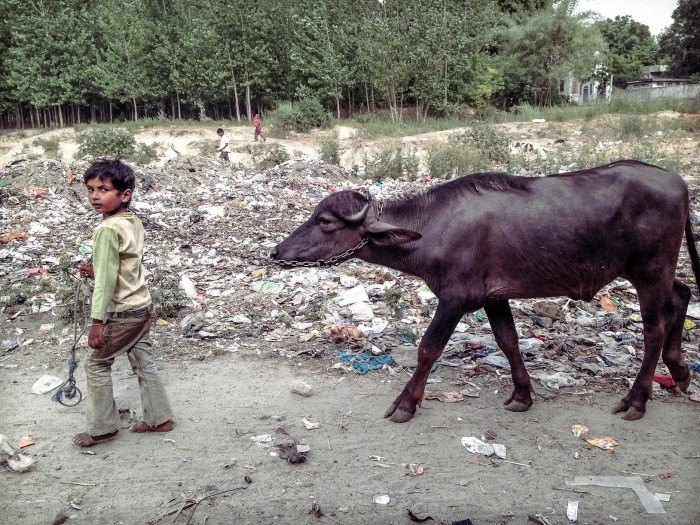
In the foreground, a young boy in a migrant camp in Hariana, Punjab tends a water buffalo. Like other children in the camp, he’s kept home from school to contribute to chores like tending animals or sorting trash. In the background, another boy sorts trash to be sold and a woman walks to a forested area in the camp where ditches serve as makeshift toilets.
2nd Place: Roxanne Rahnama, Fort Dauphin, Madagascar
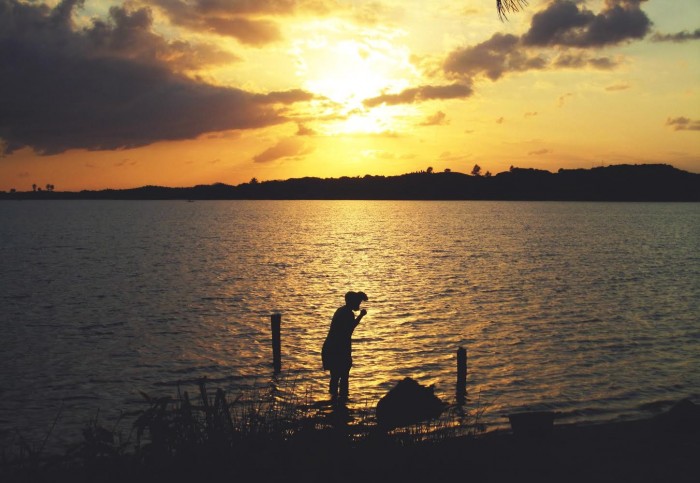
A woman brushes her teeth at sunrise, using water from a lake in Fort Dauphin, Madagascar, where villagers bathe, wash their clothing, and often openly defecate. Water supply and sanitation are serious problems in Madagascar, where diarrheal disease is a top lethal illness among children under the age of 5.
3rd Place: Thoa Hoang, New Delhi, India
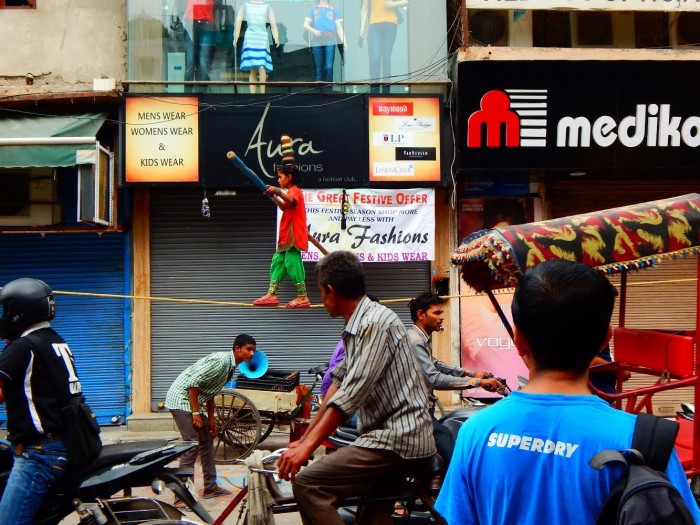
Walking across a tight rope in the middle of a busy market, this little girl is earning her keep, working to support her family. New Delhi residents tend to pay her only a swift glance, whereas foreign tourists sometimes drop a couple rupees into her metal bowl.
Students’ “Feeding Forward” fights hunger, food waste
http://newscenter.berkeley.edu/2014/11/12/students-feeding-forward-app-fights-hunger-food-waste/
TechCon 2014: University Innovators Transcend Academic Silos to Present Cutting-edge Collaborations for Global Development
FOR IMMEDIATE RELEASE
TECHCON 2014: UNIVERSITY INNOVATORS TRANSCEND ACADEMIC SILOS TO PRESENT CUTTING-EDGE COLLABORATIONS FOR GLOBAL DEVELOPMENT
Young solvers put theory into action to improve quality of life for the global community
Berkeley, CA (November 10, 2014) – Powered by the idea that science and technology together with academic curiosity can help find transformative solutions to development challenges, over 350 student innovators, faculty researchers, development experts, investors, and thought leaders met this weekend in the Bay Area for the Higher Education Solutions Network’s TechCon 2014.
TechCon 2014, which concludes this afternoon, was the second annual meeting of the Higher Education Solutions Network (HESN), a program launched in 2012 by the United States Agency for International Development (USAID) and located in USAID’s new U.S. Global Development Lab. Through HESN, USAID has created a network of eight Development Labs that harness the ingenuity and passion of university students, researchers, and faculty to incubate and develop new science and tech-based solutions to global challenges in areas such as food security, health, poverty, conflict, and climate change. One of them is UC Berkeley’s Development Impact Lab, which the Blum Center founded in 2012 with a $20 million grant from the USAID, in collaboration with the Center for Effective Global Action, the College of Engineering at UC Berkeley, and the Lawrence Berkeley National Laboratories.
“This Network represents something new and especially exciting in development—something more than a simple collection of universities. It represents a groundbreaking partnership—one that stretches from California to Massachusetts, from Texas to Uganda, united by a single purpose: to mobilize the energy and ingenuity of a new generation of students, inventors, and entrepreneurs—and harness the power of science, technology, and innovation to deliver transformational results in development. These efforts are ensuring that hungry children have nutritious meals; that rural entrepreneurs have access to power; and that smallholder farmers have strong, resilient harvests,” said Rajiv Shah, USAID Administrator.
The three-day summit, themed “Connecting to Accelerate Global Development,” featured an Innovation Marketplace where young innovators showcased their work, a “Shark Tank” styled pitch competition, and keynotes that both challenged and inspired attendees to identify new approaches and solutions to the development challenges we face. The annual meeting also served to further strengthen and cultivate this emerging global network of solvers, all of whom are committed to changing development.
Ticora Jones, HESN Division Chief said, “Bridging the divide between invention and global impact is one of the most challenging issues of our time. It’s like running a marathon, while trying to combine strangers and friends to run with you along the way. Connecting individuals and communities with diverse viewpoints, resources, and skills is incredibly hard, but absolutely essential to cross the finish line.”
HESN’s eight university-led Development Labs regularly manage projects in collaborations with networks that include other universities, innovators, investors, and institutions in developing countries. Each Development Lab has a distinct focus, ranging from food security to global health. You can learn more about each HESN Development Lab at www.usaid.gov/hesn.
This year’s TechCon also brought together many of HESN’s partners and stakeholder to celebrate their initiatives and contribute to a dialogue focused on creating, testing, and scaling of solutions. For example:
The Institute for Globally Transformative Technologies at the Lawrence Berkeley National Lab (LIGTT) announced the publication and launch of “50 Breakthroughs” Report, a transformative study conducted over the course of two years that analyzes the problems facing the global poor and identifies where technology can play a pivotal role. The study incorporates input from over 1,000 of the world’s leading experts, and is made possible in part through HESN funding. Find out more at www.ligtt.org.
Development Innovation Ventures (DIV), another flagship program of the U.S. Global Development Lab, announced a $3 million dollar, Stage 3 award to the Zusha! Project. In Kenya, the Zusha! initiative combats road accidents through the simple method of putting stickers in buses, therefore empowering passengers to speak up about reckless driving, for a fraction of the cost of other road safety interventions. The innovation has already had tremendous success and though DIV’s support, will move from a pilot to a solution with potential to reach millions of people, starting with expansion in East Africa. Zusha! is led by researchers from the Georgetown University Initiative on Innovation, Development, and Evaluation (gui²de).
To learn more about the Higher Education Solutions Network and the eight Development Labs, visit www.usaid.gov/hesn
Water Comes First: Ashley Miller’s Work To Support Infrastructure in Southern Kenya
By Sean Burns
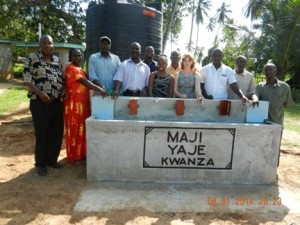
How can a wedding change a village? Sounds like some kind of development riddle, or maybe even a Hollywood screenplay. Not for Global Poverty & Practice senior Ashley Miller.
In the summer of 2013, Miller travelled to Nairobi to participate in a study abroad program at Kenyatta University. As is the case for many students’ international sojourns, Miller’s most transformative experience didn’t occur in the classroom. In the final week of her summer program, Louisa Mwenda, a fellow Kenyatta student invited her to a family wedding in the Kaloleni region of Kenya. The trip would profoundly redirect the course of Miller’s undergraduate education and the entire community of Mihingoni, a sub-county of Kaloleni.
Mihingoni is a 6,800-person village in the southern coastal province of Kenya. Miller and Mwenda made the seven-hour bus ride from Nairobi together through farmlands to the Indian Ocean. During the weekend, Miller found herself in all kinds of engaging conversations. Mwenda’s father, an American R&B aficionado, bonded with her over Marvin Gaye, Nina Simone, and the global diaspora of African-American culture. But one thread of conversation trumped them all: the limited access to safe drinking water in the Mihingoni village.
For Miller, conversations about water access and public policy were not new. Concern for the political and environmental dimensions of water distribution were part of what drew her to the Blum Center’s Global Poverty & Practice Minor at UC Berkeley and led her to define her own major in Interdisciplinary Studies. Miller’s courses at Kenyatta built upon this interest, focusing on the intersection of resource conflicts with the politics of gender and the challenges of environmental degradation. During her weekend in Mihingoni, she witnessed how everyone depended on rain catchment and, as she began the trip back to Nairobi, filled with the joy and connections of a wedding weekend, she found herself envisioning an ambitious water project with members of the Kenga Family.
“I remember saying to Louisa’s aunt during the car ride: Why don’t we work together to get safe water to Mihingoni? But, at first, she misunderstood me; she thought I was suggesting drilling a community bore hole—a small-scale and short-term water source that is commonly funded by outside NGOs.” What Miller envisioned was more ambitious.
About 1.5 miles outside of Mihingoni, access to municipal Kaloleni water stops. Beyond, there exists no public infrastructure for the distribution of safe, treated water. What Miller and her comrades in the Kenga family began to flesh out—in the weeks and months after the wedding weekend—was a plan to extend the public water main to Mihingoni, bringing safe water to at least 3,000 community members.
Being an entrepreneurial Cal student, Miller sought out the Big Ideas@Berkeley competition as a venue to develop and seed fund the idea. Between the fall of 2013 and spring 2014, Miller, through continual and in-depth communication with members of the Kenga family, created a proposal for a community-built project that, in collaboration with Kilifi-Mariakani Water & Sewage Ltd., the Kaloleni municipal water supplier, would bring safe water to a community-accessible water kiosk located at the central Mihingoni Primary School. The location was chosen for many reasons. First, the school serves more than 800 students; drinking taps and hand-washing sinks would make a significant improvement to quality of life for students and teachers. Second, the Kenga Family had direct ties to the school faculty, and everyone felt that the school administration was well poised to equitably oversee the community water kiosk through a newly created water committee made up of parents, teachers, and the school principal.
When Miller’s proposal won 2nd Place in the Big Ideas @ Berkeley Human Rights category, she knew she had accomplished an important step toward the project’s realization. To complement this momentum, the Clinton Global Initiative University (CGIU) invited her to the 2014 annual conference. Both Big Ideas and CGIU provided Miller with the mentorship and networking essential to the developing project.
In her lengthy conversations with the Kenga Family, the phrase “maji yaje kwanza” became a guiding aphorism. It translates: water is the first thing or water comes first. For Miller, the phrase struck her as an ideal name for the project. Much of her undergraduate study has focused on the relationship between water access and broader social justice determinants, including access to education.
“My goal in the project was always about assisting the Mihingoni community in overcoming infrastructural and political barriers to self-determination,” she said in an interview. For Miller and her local collaborators, this decidedly meant working with rather than around local government. “Many of the international nonprofits in Kenya are digging wells for clean groundwater. While this is good and often reliable, it does not sufficiently address bigger systems of inequality,” she explained. Maji Yaje Kwanza therefore is a community project that seeks to hold the public sector accountable to the populations it is underserving.
During a three-week period in June and July of 2014, Miller and her Kenga Family collaborators successfully coordinated the construction of the 1.5-mile extension of the municipal water main to reach Mihingoni Primary School. With essential support from the local chief, a government water engineer, and school officials, the project hired nearly 200 village residences to dig the trenches and backfill over the new piping. For storage and distribution of the water, two 10,000-gallon tanks were installed at the school property, which now lead to washing sinks and drinking taps.
The Maji Yaje Kwanza team handled the budget and payroll, with a total cost of $20,000 largely subsidized through the Big Ideas award, additional Blum Center support for standout CGIU student projects, and a collection of grants from other sources, including the Donald A. Strauss Foundation, Berkeley’s Center for African Studies, and the Shinnyo-En foundation.
Miller is now waiting to hear news of the commencement of water delivery to Mihingoni. While Maji Yaje Kwanza completed the water main extension and water storage aspects of the project, a larger World Bank-funded initiative is necessary to provide sufficient pumping capacity to get the water to consistently reach the village. Once this comes together, thousands of people will have access to the school water kiosk and, over time, to domestic taps along the 1.5-mile pipe. The school will sell the water for approximately 6 cents for 5-gallon container of water. This price will enable the school to cover the meter costs, with any additional income going toward the purchase of hand soap (for the three new sinks), antiseptic for the pit latrines, and toilet paper for the students and staff. For Miller, once the water begins to flow, the next steps will be multiple. First, she aspires for all sub-counties within the Kaloleni region to have similar access to municipal water; this means replicating and scaling up the community process just completed in Mihingoni.
While the first phase of this might be community water kiosks, a further step, in the minds of many residents, should be infrastructure for people to directly receive water in their homes and on their farms. Miller agrees, and she has a particular interest in expanding the practice of rainwater harvesting and drip irrigation in agriculture, the predominant industry in the province. In part, her aspirations are informed by international perspective. “There are many other regions in the world more arid than Kaloeni that have the infrastructure of sophisticated, public water systems,” she said. “Think about many areas in the Middle East. Why isn’t this the case in Kenya?”
The answer is not lost on the people of Mihingoni. According to Miller, they analyze the inequities that confront their daily lives within the longer history of colonial exploitation of the coastal regions of Kenya. This history has included land acquisition and forced resettlement by successive waves of Portuguese, Omani, and British control. The Mihingoni are committed, pitchfork by pitchfork, community meeting by meeting, to reverse these colonial legacies.
Sean Burns serves as the Director of Student Programs for the Blum Center for Developing Economies at University of California, Berkeley.
A Contest to Catalyze Literacy Via Mobiles Worldwide
By Andrea Guzman
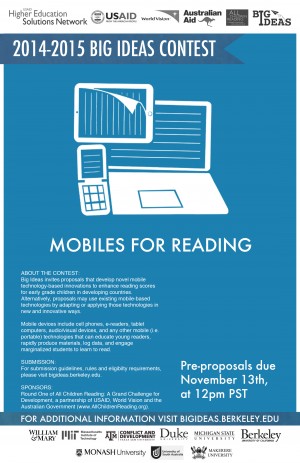 A 2013/2014 UNESCO report found that 250 million children across the globe are not learning basic literacy and numeracy skills. Of these, 57 million children—a disproportionate number of whom are from disadvantaged backgrounds, live in conflict-afflicted countries, or are disabled or simply girls—aren’t enrolled in school at all.
A 2013/2014 UNESCO report found that 250 million children across the globe are not learning basic literacy and numeracy skills. Of these, 57 million children—a disproportionate number of whom are from disadvantaged backgrounds, live in conflict-afflicted countries, or are disabled or simply girls—aren’t enrolled in school at all.
Big Ideas@Berkeley and USAID’s Global Development Lab are aiming to change these numbers through the Mobiles for Reading contest category by inviting students to develop novel technology-based innovations to enhance reading skills for youth in developing countries. This new contest category is sponsored by All Children Reading: A Grand Challenge for Development, a partnership between USAID, World Vision and the Australian Government.
The creation of the category comes amidst a growing international movement to use mobile technologies as tools for enhancing children’s reading skills. Numerous studies have shown that children who do not develop reading skills during early primary education are on a lifetime trajectory of limited educational progress and economic opportunities. Meanwhile, mobile devices are ubiquitous, even in low-income regions. According to the International Telecommunications Union, 96.2% of people on the planet have mobile cellular telephone subscriptions.
To Rebecca Leege, project director of the All Children Reading initiative, mobile technology can be a particularly effective tool to disseminate local language instruction materials. “Evidence confirms that children best learn to read in the language with which they are most familiar,” said Leege in an email. “However, many children enter schools where they are taught in a foreign language and have little or no access to mother tongue reading resources, making it difficult for them to gain the foundational skills needed to learn to read. This, coupled with low engagement from family or their community to support their learning to read, limits the reinforcement needed to develop a proficient reader.”
Leege added: “A basic phone or tablet can provide new and vital mother-tongue reading resources to engage children’s curiosity and interest in reading in communities with sparse access to books.”
While mobiles for reading remains a new approach, some programs have illustrated promising results. A pilot program for illiterate women conducted by the Afghan Institute of Learning showed that between May 2011 and May 2012 reading via mobile halved the time in which students were able to attain literacy at a basic 2 level. Teachers sent daily texts to students, who read the incoming messages and responded via SMS, demonstrating reading comprehension and writing skills. Researchers found that cell phone texts generated excitement among students, as literacy became not an “abstract skill” of alleged importance, but a tangible skill that could bring the students to “another level of understanding of the world around them.”
Over the past few years, a growing number of NGOs, academic researchers, social entrepreneurs, donors, and policymakers have begun to develop and support mobiles for reading technology. On October 15-16 2014, USAID and the mEducation Alliance held the third annual Mobiles for Education Alliance Symposium in Washington, DC, which brought together 185 participants from the Americas, Africa, Asia, Australia, Europe and the Middle East to discuss trends and topics to advance the field.
Although participants repeatedly underscored that technology and mobile devices are exciting new tools to foster inclusive and quality education, many also pointed out that the human element is crucial. “What matters is the human interaction,” said Brian Gonzalez, the symposium’s keynote speaker and director of the global education sector at Intel. “But not one-to-one, but one-to-many in order to improve the way teachers teach and children learn.”
Leege believes that among the greatest barriers to innovation in mobile reading are access to electricity and connectivity. “To assist those learning to read in low-resource settings, low-cost and open source materials easily maintained by the user are vital,” she said. “We would like to see student innovation that addresses unreliable—or absent—electricity and connectivity in low-resource communities.”
The Mobiles for Reading contest is open to over 500,000 students across 18 universities, from Uganda to Australia (for a full list of eligible universities, visit the Mobiles for Reading webpage.) Students who wish to participate must develop novel mobile technology-based innovations to enhance reading scores for early grade children in developing countries. Alternatively, proposals may use existing mobile-based technologies to improve early grade reading scores by adapting or applying those technologies in new and innovative ways. A five-page pre-proposal is due November 13 to the bigideascontest.org website. Three to to six student teams to be selected to continue on to the full proposal round in the spring. Winners will receive awards up to $10,000 to go toward further developing their idea.
“We hope to capitalize on student’s creativity, knowledge, personal experience of learning to read, as well as their desire to innovate for a better world,” Leege said.
USAID’s Alex Thier on Ending Extreme Poverty
By Abhik Pramanik
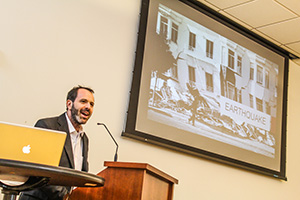 On October 20, the Blum Center for Developing Economies hosted a talk by Alex Thier, head of the Policy, Planning, and Learning Bureau at the U.S. Agency for International Development. Entitled “Ending Extreme Poverty: What UC Berkeley Can Do,” Thier’s talk centered around the Post-2015 Development Agenda, USAID’s role in the development community, and the need for bilateral and multilateral donors to partner with innovative entrepreneurs to make a difference.
On October 20, the Blum Center for Developing Economies hosted a talk by Alex Thier, head of the Policy, Planning, and Learning Bureau at the U.S. Agency for International Development. Entitled “Ending Extreme Poverty: What UC Berkeley Can Do,” Thier’s talk centered around the Post-2015 Development Agenda, USAID’s role in the development community, and the need for bilateral and multilateral donors to partner with innovative entrepreneurs to make a difference.
Thier reminded the packed hall that today roughly 1 billion people, or 18 percent of the world population, live in extreme poverty, which the World Bank defines as earning or consuming less than a $1.25 day. Although these numbers may seem alarmingly large, extreme poverty rates are actually down from more than 40 percent in 1990. This reduction represents a fulfillment of Millennium Development Goal 1: to halve the rate of extreme poverty by 2015.
With the imminent expiration of the Millennium Development Goals, the international community is now debating development goals for the next 15 years. Yet one objective is clear: almost every bilateral and multilateral organization, including the World Bank, USAID, the European Union, and the African Union, has set a target of bringing the number of people living in extreme poverty to zero by 2030.
Thier argued that the elimination of extreme poverty is a distinct possibility. While some scholars have talked about severe poverty as inevitable, the remarkable economic movement over the past two decades—which saw 700 million people lifted out of extreme poverty—proves otherwise. Moreover, the political will to tackle the problem seems to be growing. In his 2013 State of the Union Address, President Barack Obama declared that the U.S. would band together with its allies and partner to end extreme poverty by 2030. Additionally, both USAID and the World Bank have changed their mission statements within the past year to commit to ending extreme poverty.
Though naysayers still exist, Thier said he believes that the outcome ultimately rests on choices—at the individual, village, institutional, and country level to fight for economic development. He noted that the biggest obstacles to ending extreme poverty are fragile institutions and weak governance. Citing the examples of the Democratic Republic of Congo, Botswana, and the Republic of Korea, he summarized how each country took a divergent path since enduring various weaknesses in the 1960s.
Due to rapid industrialization, foreign capital investment, and intensive manufacturing, South Korea is now a high-income country, with a higher life expectancy than the U.S., and it has created its own agency for international development. The DRC, on the other hand, has experienced botched governmental policies leading to debt crises and a bloody civil conflict that has raged for decades. As a result, citizens of the DRC are currently among the world’s poorest. In another example, Botswana has experienced years of high growth followed by sharp economic downturns and even sharper rebounds because of its over-reliance on extractive industries. The lack of economic diversification has hindered Botswana’s development, but the country is still much better off than the DRC. Thier said he believes that the key distinction among these nations’ economic growth is their level of good governance and effective institutional capacity.
As a result of these insights, USAID recently adopted a “New Model of Development,” which centers on leveraging local ownership, engaging in public-private partnerships, scaling up innovative ideas, and using cutting-edge technology to deliver measurable results. To illustrate how this works, Thier talked about two USAID programs: Feed the Future and Power Africa. The former, started in 2009 in response to the global spike in food prices, works with local farmers to increase their crop quality and yields. The initiative currently runs in 19 countries and already has improved nutrition for 12 million children and pushed 7 million farmers out of extreme poverty. Power Africa was launched in 2013 to help the 400 million Africans who currently lack access to electricity. It aims to double the number of people with access to electricity in Sub-Saharan Africa through the use of innovative financial tools and by applying the lessons learned from the Feed the Future initiative. Within a year, Power Africa has leveraged $25 billion in capital with more than half coming from African nations and the private sector.
Thier ended his talk with a plea to the next generation of problem solvers. He said he hoped UC Berkeley students would heed his call to develop new ideas and technologies to help make development assistance more effective, so that by 2030 extreme poverty could be eliminated. Some of this work is being done by the Blum Center’s Development Impact Lab (DIL), which received a $20 million grant from USAID in 2012 to help transform the way universities source, design, evaluate, and scale up technologies that have a potential to alleviate extreme poverty. Currently, 90 DIL innovations are being tested and scaled in 30 countries, involving more than 500 interdisciplinary students, and over 400 industry, government, and social sector experts.
Generation Innovation: Jessica Praphath on the Realities of Direct Service Work
By Sybil Lewis
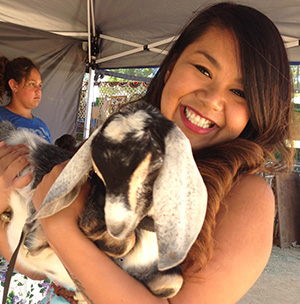 Many students graduate from Cal intent on making an impact in the world. The reality of direct service work, however, can cause even the most committed to feel discouraged and to question what meaningful and financially sustainable work looks like—challenges that Jessica Praphath, a Cal alumna, faced while working on poverty alleviation in her hometown of Stockton, California.
Many students graduate from Cal intent on making an impact in the world. The reality of direct service work, however, can cause even the most committed to feel discouraged and to question what meaningful and financially sustainable work looks like—challenges that Jessica Praphath, a Cal alumna, faced while working on poverty alleviation in her hometown of Stockton, California.
Stockton was hit hard by the 2007 financial crisis. In 2008, foreclosures soared to 9.5 percent and housing prices fell by 39 percent. In July 2012, it became the largest American city to file for bankruptcy protection.
Praphath, whose parents immigrated from Thailand, grew up in “pockets of poverty” in the predominantly Southeast Asian communities around Stockton, and returned there a week after graduating from UC Berkeley in 2013, determined to work on public health and community issues at the grassroots level. She could have stayed in the more affluent cities of the Bay Area, but after minoring in Global Poverty & Practice (GPP), she said she decided her vocation was to better “understand the systemization of poverty and how I and my community fit into that system.”
Praphath’s first job out of Cal was at a resource center of the Community Partnership for Families of San Joaquin, where she completed her GPP practice experience. There, she was in charge of establishing a virtual education program for students in low-performing schools in south Stockton. But when you “work in a nonprofit in Stockton you wear 25 different hats,” she said. She soon became involved with the nonprofit’s umbrella program, Neighborhood University, providing online parenting and English as a Second Language (ESL) classes.
Praphath worked countless hours to provide ESL, one of the community’s highest demands. Although the first few weeks of classes started off with about 40 people, over time the numbers slowly faded. Eventually, the classes were cancelled due to low attendance. Praphath said she was disappointed to “work so hard and then watch the project fail.”
The failure felt personal. Yet she also knew that the class’s low attendance might have something to do with the culture of welfare in south Stockton. Many people were distrustful of organized social assistance, in part because Stockton’s district lines had been redrawn so that most of the post-crash development money went to renovating downtown rather than to helping low-income south Stockton. Residents became accustomed to social workers using data about their lives to collect grant money that eventually went elsewhere.
Praphath said she discovered that one of biggest problems in development work is to empower a community that has been exploited or ignored. Another challenge is the lack of funding for community members and those who want to work with them. Praphath’s $13 hourly wage did not cover her monthly bills, which include payments on almost $20,000 in student loans. The Community Partnership for Families of San Joaquin also wasn’t able to provide her health benefits or employ her full-time, even though she was putting in 40 to 50 hours per week.
After months of exhausting work and financial difficulties, Praphath reluctantly left the family center for a job at the Health Education Department of Community Medical Centers, a federally qualified health center in Stockton. Yet two months into the job, she said she felt something was missing—the one-on-one interactions with people, the community aspect.
To fill this gap, she volunteered for the Reinvent Stockton Coalition, a community-based initiative spearheaded by Stockton City Councilman Michael Tubbs. Praphath said the coalition has made her rethink what works in community development. “I graduated from Cal thinking that meaningful work was measured by how many people you can get in a program,” she said. “But in the field, it’s not about that. Being effective is not about 40 people attending your ESL class or health workshop. It’s about whether you can change people’s lives.”
Looking back, Praphath said she thinks attendance of the family center’s ESL classes dropped partly because beneficiaries were not involved in shaping the classes. She is a believer in the participatory development of social programs. Yet she realizes this is easier said than done, especially when there is a “disconnect between professional and college-educated people and community members.”
At Community Medical Centers job, she sits on a bimonthly public health task force that brings together representatives from nonprofits, foundations, and government organizations to discuss plans for public health initiatives. Praphath believes in the mission of the taskforce and sees a strong desire to enforce change, but she notes that a fundamental piece is missing: a community representative. The same was true for the initial planning meetings of Reinvent Stockton. When she looked around the table during those first meetings, all she saw were dedicated people who went to good universities and, like her, returned to Stockton to help improve it.
Praphath has since played a vital part in the Reinvent Stockton coalition’s expansion to south Stockton community members. They helped write two assessment surveys, which mapped Stockton’s “community strength index,” focusing on issues such as education, public safety, housing, economic development, and health. And in July 2014, the coalition launched its first community assessment survey, from which community members and volunteers collected more than 800 surveys.
Praphath, who is collecting follow-up surveys, recalled an emotional phone conversation with a south Stockton resident named Regina about crime and policing. Regina told Praphath that her son had recently been shot and that distrust of the police was high. “I talked to Regina for 56 minutes and 8 seconds,” she said. “I know the exact time because I remember getting off the phone and feeling like it was one of those experiences where you feel so connected to another human being and it helps you understand your purpose and why you are doing what you are doing. All the stress goes away and it all makes sense.”
Praphath said when she first returned to Stockton with her UC Berkeley degree, some people expected her to have all the answers. She made it clear that she was there to learn. “When I meet community members, I let them do a lot of the talking,” she said. “This way, I am seen not as someone who is trying to push knowledge or test out my education, but as someone with a genuine interest in what they have to say.”
A year later, she has come to believe that community members are the ones with the answers. They are the experts—the “think tanks” as she puts it.
What If Everything We Knew About Poverty Was Wrong?
There’s no getting around the veracity of Matthew 26:11. “…For ye have the poor always with you,” as the King James Version has it. But as long as there has been poverty, there have also been decent souls trying to eliminate it.
So how are they doing? Not very well. According to the World Food Programme, 805 million people don’t have enough to eat. World Bank figures confirm that more than 3 billion people—or somewhat less than half the total planetary population–eke by on less than $2.50 a day, while almost 1.5 billion subsist on less than $1.25 a day. Fully 80 percent of the planet’s people get by on less than $10 a day. In other words, it’s not so much a case of the poor always being with us. Considered from a global perspective, the poor are us. Most human beings live in poverty, and for many the situation is utterly desperate.
Electrification for “Under Grid” Households in Rural Kenya: Five Questions for Ken Lee
By Sybil Lewis
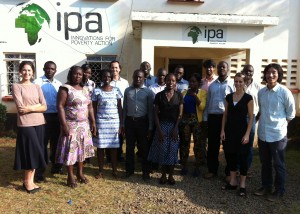 In the summer of 2012, an interdisciplinary research group at UC Berkeley set out to study the demand for and effects of community-level, solar-powered microgrids in Western Kenya. To the surprise of the members of the group—led by Professors Edward Miguel (Economics), Catherine Wolfram (Business), and Eric Brewer (Electrical Engineering and Computer Science)—they could not identify many communities that were truly “off grid.” There just always seemed to be an electricity line nearby.
In the summer of 2012, an interdisciplinary research group at UC Berkeley set out to study the demand for and effects of community-level, solar-powered microgrids in Western Kenya. To the surprise of the members of the group—led by Professors Edward Miguel (Economics), Catherine Wolfram (Business), and Eric Brewer (Electrical Engineering and Computer Science)—they could not identify many communities that were truly “off grid.” There just always seemed to be an electricity line nearby.
As a result, the group shifted its focus to populations who were “under grid”—in other words, people whose homes and businesses were near but not directly connected to the grid network. In partnership with Innovations for Poverty Action, the research group began the time-consuming process of mapping out 150 communities in order to gauge each household’s relation to the grid. The census data quickly began to generate a lot of interest from local policymakers and led to the July 2014 working paper “Barriers to Electrification for ‘Under Grid’ Households in in Rural Kenya,” published by the National Bureau of Economic Research (NBER).
To make available the significant economics and engineering findings of the NBER paper, supported by UC Berkeley’s Development Impact Lab, the Center for Effective Global Action, and the Technology and Infrastructure for Emerging Regions, we asked lead author Ken Lee, a PhD student in Agricultural and Resource Economics, the following questions.
1. What is the main difference between “off grid” and “under grid” electricity connections, and what policy implications does this distinction have for African countries?
The International Energy Agency estimates that in Sub-Saharan Africa, 600 million people live without access to electricity. What follows quite naturally is an assumption that most of these people are “off grid”—or too far away to realistically connect to a national electricity network. As a result, we’ve seen growing support for off grid, distributed energy technologies, most of which are best suited for regions without access to grid power. Yet many countries are expanding the reach of their national grid infrastructure. In Kenya, for example, there has been a recent push to connect all of the country’s secondary schools, health clinics, and markets, suggesting that a large proportion of the population is now within walking distance of an electricity connection.
We are hoping to change the framework in which we view this problem. It is possible that a substantial portion of the 600 million people without electricity are not “off grid,” but are “under grid,” or close enough to connect to a low-voltage line at a relatively low cost, and this is what we illustrate in our research paper. This distinction is important because the policy implications for off grid and under grid communities are quite different. In under grid communities, it may be preferable to focus on supporting policies that will leverage existing infrastructure with the goal of increasing “last-mile” grid connectivity.
2. Your research showed that despite Kenya’s strong push for rural electrification, national electrification levels remain below 30 percent. What have been some of the biggest challenges in effectively connecting rural communities to power grids?
The most important barrier to grid connectivity has been the high price of an electricity connection. Currently, the price of a household connection is $410, which is incredibly expensive even by American standards. In a country where gross national income per capita is $1,730, this price is simply unaffordable for poor, rural households. There are several other barriers to electrification as well. For example, even if the price were lower, it may still be necessary to provide households with an option to finance their connections, so that they could pay back the principal amount over time. Finally, rural households in Kenya tend to be spread apart and there are few straight lines through which one could easily run a power line. This makes it challenging for electricity planners to build out cost-effective low voltage networks, particularly when they are unable to connect all of the neighboring households at the same time.
3. What effect does reducing energy poverty have on other aspects of development, such as income, well-being, and education?
There is no question that access to modern energy is a key input for economic development. For example, electricity opens up the possibility for households to extend their lighting hours, changing the way that people use their time, and allowing children to (hopefully) study later at night. It also allows households to engage in all kinds of new income-generating activities. In one of our study sites, we met a woman who had already begun selling cold fruit smoothies to her neighbors, within a month of gaining an electricity connection.
Given the high cost of rural electrification, there is a need to rigorously document the socioeconomic impacts of modern energy. There is also a need to better understand how newly connected households will consume energy moving forward. Our research team is currently implementing a randomized evaluation of grid connections in Western Kenya, and through this project, we hope to shed additional light on these questions.
4. What are the options available to poor rural Kenyan households to finance electricity installation and continued use?
Currently, the options available for households to finance installations and appliance purchases are limited. Although the national utility had offered a financing plan in the past, the program encountered many challenges. There is, however, high demand for financed energy solutions. The recent success of the “pay-as-you-go” solar home system offered by M-KOPA provides an interesting example. Households are paying as much as $200 over the course of a year to finance a limited solar home system product. What makes their financial model work is that the daily payments can be processed through the M-PESA mobile money platform. So while there is a general need for additional financing options for grid connections, the example illustrates that there is an equal need to develop innovative billing and collection technologies for financed grid connections that will incentivize both lenders and borrowers in a sustainable way.
5. How can governments in Africa design projects to improve national electrification levels?
Our study region in Western Kenya has high population density and extensive grid coverage, making it an ideal setting in which we would expect to observe rapid rural electrification. Yet the vast majority of the 15,000 rural households and businesses that we document remain unconnected despite being located within connecting distance of a power line. So the real issue is not the lack of an electricity supply, but the fact that both the price of a connection and the cost of supplying that connection is prohibitively high. It just doesn’t make sense for a utility to spend lots of money to connect a single household in a remote, rural community, even if the grid is physically present.
The most promising strategies for improving national electrification levels will vary from country to country. Wherever there is grid coverage, however, governments may wish to consider policies that will leverage existing infrastructure, while taking advantage of the economies of scale in supplying last-mile connections. Connecting multiple households at the same time would not only reduce transportation costs but also would allow utilities to plan local distribution networks that minimize costs. Coordinating these connections poses the collective action problem that would need to be solved through a government policy, such as a mass connection program. The idea of subsidizing last-mile electricity connections to households is, of course, nothing new. This is how many developed nations, including the United States, reached universal electrification.
Generation Innovation: Sergio Venegas Marin’s Quest to Influence Public Policy
By Andrea Guzman
In 2010, Sergio Venegas Marin, an ambitious student at Cosumnes River College in Sacramento, was aiming to transfer. He looked at eight universities, and settled on UC Berkeley because of its Global Poverty & Practice (GPP) minor.
Born and raised in Cadiz, Spain, Venegas said the GPP minor attracted him because poverty and social problems were part of his everyday life. The youngest of three children, he was raised by a single mother who worked several part-time jobs. Venegas said it seemed unfair that his mother had to work 20-hour days sometimes in order to provide basic necessities for her children.
“It was complicated to make a living,” Venegas, now 25, said. “It was difficult and it didn’t feel right that it was that difficult.”
In Spain, Venegas’ family and many of his neighbors relied on social assistance programs to make ends meet. But when more conservative political parties took office, the programs were cut, school dropout rates increased, and many youth became involved with crime and drugs. Cadiz, a southern port city that has long struggled with high unemployment, is now experiencing rates of 40 percent. Venegas said his old friends from Cadiz are living “completely different lives”—marked by low job prospects and economic struggle.
When he was 17, Venegas’ life changed. He followed his mom and dad to Sacramento, California, where his father’s family lived. There, he learned English and enrolled in community college.
At Cal, he majored in economics and took as many classes with a development focus as possible. He said the GPP minor enabled him to channel his passion for social and economic justice. He found like-minded fellow students—people with similar experiences and interests and who sought to use their education to reduce poverty and inequality in the United States and around the world.
After graduating in 2012, Venegas searched for jobs and discovered that many social sector positions were unpaid. Frustrated and worried about money, he applied to investment banking and private sector jobs. But at the interviews, he realized those jobs were not for him. Seeing the lack of minority professionals reminded him of the social problems that need to be addressed. He decided to turn down a $75,000 job offer, and worked part-time as a campus host at the Academy of Art University in San Francisco and as a part-time instructional assistant at his community college in Sacramento.
“I was very frustrated, because I felt every opportunity in the development field was open only to people who didn’t need to be paid, who already had an economic advantage,” said Venegas.
But he soon landed a job as an analyst at a consulting firm called Mission Analytics, which evaluates and provides technical assistance to government social welfare programs. Venegas not only found a way to influence public policy through the job, he opened the door to fellow GPP students to do the same. Two other members of the Mission Analytics team are GPP alums. He said the firm chose to hire the GPP students because of their unique skills and education.
“I think it’s the ability of looking at a problem from different standpoints,” he said. “GPP students have a way of mixing everything they have learned. They are able to care about the methods but also the end goal we want to accomplish.”
In the future, Venegas intends to get a Master’s in Public Policy and return to Spain to help create a more participatory democracy and a stronger welfare state. He advises students still in the GPP minor to get involved in their communities and pursue their passions before and after graduation.
“Instead of wasting your time and just wanting to graduate, you should get involved,” Venegas said. “Being passionate prepares you to take on the world.”
A New “OnRamp” Class for Social Innovators
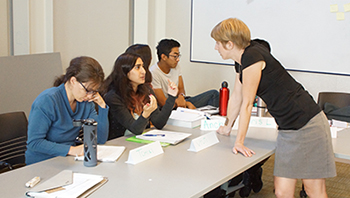 By Tamara Straus
By Tamara Straus
Some people have called it the personalization of higher education. Others see it as the natural evolution of pedagogy at a world-class public research university. Lina Nilsson doesn’t disagree with either of these interpretations, but she definitely sees on-campus, in-class social impact work as “the changing face of education.”
“Connecting academic learning to real-world issues and problem solving is something that students are demanding,” said Nilsson, director of innovation at Blum Center for Developing Economies. “And students can’t be expected to pull together all the pieces needed for their ideas to have impact. In addition to subject-matter expertise, they also need coaching and mentorship. They need to learn by example. And there’s no reason that can’t be made available to them at the university.”
These are among the reasons Nilsson launched a new Blum Center-sponsored course this fall called “Social Innovation OnRamp.” Created in part to provide a space to accelerate the projects of UC Berkeley students who have won the prestigious Big Ideas@Berkeley contest, the course provides an overview of a broad range of skills for the creation, evaluation, implementation, and growth of early-stage projects that serve the public good. The course also comes with an OnRamp website that provides resources for budding social innovators to find funding, startup and training programs, and recommended reading.
In its very first offering, the OnRamp course quickly oversubscribed. In October, UC Berkeley’s Jacobs Institute for Design Innovation awarded the course a teaching grant. Several of the students, such as Political Science Major Michael Alexander Clark, have unabashedly said, “It is the best class I’ve taken at Cal.” Part of the energy in the class comes from Nilsson herself, who while a post-doc in bioengineering at UC Berkeley, created a startup called Tekla Labs, which provides guidelines for medical professionals in developing countries to build lab equipment using locally available supplies. For this, Nilsson was named a MIT Technology Review Innovator Under 35. But Nilsson herself admits that she and her Tekla Labs colleagues “could have done a lot of things better, if we had learned a few things earlier.” This need to learn from both successes and failures has shaped the theory and the practical drive of the OnRamp course.
The OnRamp’s high-energy atmosphere also comes from the students themselves. They are a mix of graduate and undergraduate students representing departments as diverse as business, political science, computer science, psychology, information management and systems, mechanical engineering, applied mathematics, anthropology, environmental economics, energy resource, and peace and conflict studies. Some projects focus on mental health; some on agriculture; others are pushing along ideas that might “innovate” or “disrupt,” to use the parlance of social innovation, student career support and homelessness. About half the student teams in the class are focused on U.S. social impact, and the other half on developing countries.
Along with Nilsson, Course Facilitators Kate Fenimore and James Roditi, and a dozen guest speakers serve as both cheerleaders and cautioners for student innovation. “What we try to say is: ‘Here’s a scaffold of skills and insights you need to master and evaluate if you want to have meaningful impact as a social entrepreneur,’” explained Fenimore. The course presents 12 such scaffolds, including: framing and pitching ideas; developing a theory of change; identifying, understanding, and communicating with stakeholders; understanding, maximizing, and measuring social impact; network, outreach, and communication; social impact concepts; product/service prototyping and design; execution and logistics; business models and legalities; and knowing when to pivot or quit. Every week, a practitioner engages the students in an hour-long discussion on these scaffolds, with the possibility of additional mentorship.
John Romankiewicz, a dual master’s degree student at the Energy & Resources Group and the Goldman School of Public Policy, said he enrolled in OnRamp to move along his idea for The Food Bikery, which seeks to deploy a low capital, low footprint alternative to food trucks. He reasoned that food trucks, which are now a $1 billion industry in the U.S., may not be as green as many people think. They cost about $50,000 to outfit with a kitchen and generator, whereas food bikes cost around $5,000, and generate much lower emissions, take up less space, and serve as a more affordable pathway for budding chefs to showcase their talents. Eventually, Romankiewicz would like to see co-ops of food bikes in relatively flat, temperate cities like Berkeley and Austin that could share food storing and prepping facilities.
To put his idea into action, he and Jason Trager, a Cal mechanical engineering PhD student, built a prototype in 2013 made from recycled materials for a 150-pound, two-wheel trailer. They outfitted the trailer with a griddle and propane tank and rigged it to a standard street bike. Romankiewicz, who goes by the moniker “Sustainable John,” began to show up at parties and make Jian Bing, a Chinese egg crepe garnished with green onion and cilantro that he mastered while living in Beijing. He wrote a proposal for The Food Bikery, entered it in the Big Ideas contest, and won a $2,000 prize in May 2014. Two weeks later, he won another $2,000 prize from a food company called So Delicious, which was running a small sustainability grants competition on Twitter. “I have a minimum viable product,” he said. “I know it works. What I don’t know is if I can get around the regulatory issues.”
That’s where the OnRamp course comes in. Romankiewicz said the OnRamp has forced him to refine his pitch, research the regulatory hurdles for food bikes—which like food trucks would need to meet health and food sanitation requirements—and analyze the financials. He estimates that food bike owners could sell 30 to 40 meals per shift, taking in $200 to $400 in revenue, which, he said, “would come to about $25/hour, well above the minimum wage earned by kitchen workers.” Right now, the project’s greatest hurdle is refrigeration and sanitation. “Nobody wants to carry a refrigerator on their bike or drag a generator through the streets,” he said. So he needs to argue to city and county officials that food bikes should have a four-hour operation window, during which time a bike cook could load his trailer, arrive at his location, cook his meals, and call it quits before any food spoils.
The OnRamp class has served a similar prod for Tchiki Davis, a NIH-funded doctoral student in psychology. She has been working with her father, a software engineer, on a series of online games that train young people to focus on positive information. Davis is among a growing group of psychology researchers who believe that happiness, much like math or music, is a skill that can be learned—and that positive cognitive stimulation, such as looking repeatedly at a sea of smiling faces, can reduce stress. Her Lifenik games are based on peer-reviewed papers by psychology scholars like Derek M. Isaacowitz of Northeastern University and Mark W. Baldwin of McGill University, who have conducted repetitive visual training tests that have been shown to increase self-esteem and reduce stress.
“So much of our behavior is socially engineered in negative ways, but we can change our engineering,” said Davis. “Most people know that if we can retrain ourselves to regularly exercise, then we will improve our physical health. But it is also true that if we retrain ourselves to regularly think about the world in more effective ways, then we will improve our emotional health.”
Like Romankiewicz, Davis is a Big Ideas contest veteran seeking practical guidance. “I have the research training,” she explained, “but not the business training,” adding that what she has found in the OnRamp classes is quite different from for-profit business workshops. “My greatest hurdle is not necessarily understanding the market for the games,” she said. “It’s making sure the games are psychologically effective. It’s balancing the social impact and scalability aspects of the project.”
Davis is currently applying for a $450,000, two-year NIH grant to help build and test Lifenik games. Like her teacher Nilsson, she doesn’t intend to use her doctorate to pursue a tenure track academic career. “I want to turn research findings into actionable, user-centered products, tools, and interventions that improve people’s quality of life,” she said. “Right now, this project is my passion, and I intend to pursue it.”
#Global POV: Can Experts Solve Poverty?
Generation Y is on a mission to solve global poverty. A group of professors at the University of California, Berkeley is on a mission to stop them. It’s not that these Berkeley academics are not dedicated to alleviating poverty and inequality — in fact, quite the opposite. It’s just that they want students first to study and think about the history of attempts to solve, alleviate, and even understand poverty.
The Challenges of Development Economics: An Interview with the Blum Center’s Kweku Opoku-Agyemang
By Tamara Straus
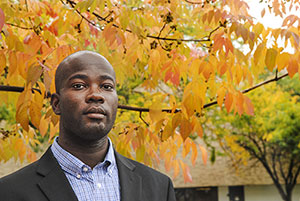 Kweku Opoku-Agyemang, a postdoctoral fellow at the Blum Center, believes that one of the greatest downfalls in the field of international development is detachment.
Kweku Opoku-Agyemang, a postdoctoral fellow at the Blum Center, believes that one of the greatest downfalls in the field of international development is detachment.
“Training in development is often solution-oriented. It involves implementing projects,” the 34-year-old Ghanaian said. “This may be why it’s easy to be detached from people and places. But detachment can have bad outcomes.”
Opoku-Agyemang has been subtly underscoring this point in his UC Berkeley course, “Poverty, Technology, and Development.” During a recent lecture, he told students the case of the Lake Turkana fish processing plant, a $22 million project designed in 1971 by the Norwegian government to provide jobs to the Turkana people of Kenya. The idea was to get the Turkana to run a fish processing plant for export, but the Turkana are nomads with no history of fishing or eating fish. Furthermore, the plant operated for only a few days, because running the freezers and providing them clean water in Kenya’s northwest desert were just too costly.
The field of international development is strewn with such stories of ineffectiveness or, to use Opoku-Agyemang’s word, “detachment,” in all its cultural, psychological, sociological, and historical variations. “About half of World Bank projects fail, costing billions of dollars,” he reminded his students—before launching into the larger question of the course and his current research: whether the current wave of technological advancement can alleviate global poverty.
“That’s an ongoing discussion,” said Opoku-Agyemang. He is measured in his opinions, perhaps from a decade-plus of education and research, in which he earned a doctorate in Development Studies from the University of Wisconsin-Madison, an M.A. in Economics from Ohio University, and a B.A. in Geography from the University of Ghana. “It depends on the example. There is a lot of excitement about technology and development now, but I think it’s too early to tell how successful the results will be.”
Still, Opoku-Agyemang is not waiting on the sidelines to find out. He is among a new generation of international scholars using interdisciplinary approaches from political economy, development economics, behavioral economics, business economics, and applied econometrics to understand the effects of technological advances, particularly mobile banking and communications, on poverty alleviation. Already, he has designed several applied research projects that document, through both qualitative and quantitative methods, how best to both formulate and evaluate development projects.
According to one of his mentors, Jeremy D. Foltz, a professor of agriculture and applied economics at University of Wisconsin, Madison, Opoku-Agyemang’s doctoral thesis was a standout because it provided new insights into informal finance, particularly in savings and credit markets. Opoku-Agyemang’s thesis looked at Ghanaian susu collectors, who work out of marketplace kiosks and through whom rural earners without bank accounts deposit and access their own money. Susu collectors are one of the oldest financial groups in Africa. For a small fee, they will hold onto people’s money and enable savings. But Ghanaians who deposit money with susu collectors do not establish formal credit worthiness with banks, even though their savings rates can be relatively high. Opoku-Agyemang’s question was why—and, in turn, what does credit worthiness really mean?
In the summer 2010, he conducted a survey to explore how small entrepreneurs use susu collectors. Some made daily or twice daily deposits; others parted with their earnings twice-weekly, fortnightly, or monthly. What he found from collecting questionnaires from 400 clients confirmed a hunch: the more frequently a person deposited money with a susu collector, the higher that person’s credit score would be in traditional finance. Banks took note. Rural banks in the Central Region of Ghana even used Opoku-Agyemang’s credit worthiness measurements to expand their customer base.
“Kweku gained exceptional access to local bank officials in the Central Region of Ghana, where there is a banking sector project to scale up micro-lending and do mobile banking,” said Professor Foltz in an email. “In the space of one summer, he was able to collect the best most comprehensive dataset on susu banking in West Africa that I have seen.”
Opoku-Agyemang has been pleased to see the results of his research: More Ghanaian banks now work with susu collector unions to mobilize funds to their best clients. But he wonders whether some entrepreneurs’ savings rates will change as they enter the formal banking sector. “Working with a susu collector is very social,” he explained. “One of the shortcomings of formal banking is that it’s relatively impersonal.” In other words, there may be less motivation to save when you give your earnings to a machine as opposed to a person who can commend your will power to save rather than spend.
Opoku-Agyemang’s current research is looking at the role of mobile technologies in Ghanaian activism and political reforms. He explains that a decade following the reforms of the 1990s, which led to new constitution and a multiparty system, Ghanaians’ confidence in local government has dipped—in spite of a robust national democracy. Especially in rural areas, many Ghanaians are politically disengaged. District and town meetings are badly attended. Even the strong Ghanaian tradition of using radio shows as means for citizens to complain directly to elected politicians, seems to have waned. “People used to line up around the block to call into the radio shows. It was a very influential way to be heard and make change,” Opoku-Agyemang said.
His current study, like his previous one, is based on a hunch: people will become more informed and politically active if they have an easy mechanism to voice their opinions—particularly to those in power. To test this, he designed a field experiment in five languages for Ghana’s Central Region that randomly varies access to politically participatory radio shows and enables more call-ins through mobiles and voice messages. Opoku-Agyemang plans to see if those who call in more often are more likely to vote in local elections.
Opoku-Agyemang, who grew up in the historic trade city of Cape Coast, does not think he necessarily has an advantage being a Ghanaian studying Ghanaian and African development issues. “I am only one person,” he said. “I tend to be very hesitant if someone is generalizing about a people or a situation. Ghana is a nation of 25 million people.”
This preference for individual perspectives may have something to do with Opoku-Agyemang’s early education and family background. Unlike most academic economists, he grew up on literature. Opoku-Agyemang read Shakespeare as a teenager. He penned short stories in college. Literature is also the Opoku-Agyemang family business. His father, Kwadwo, is an emeritus professor of literature at University of Cape Coast, an expert on African oral literatures, a poet, and a novelist. His mother, Jane Naana Opuku-Agyemang, is a literary scholar as well, an internationally acclaimed expert on the African diaspora, and Ghana’s minister of education. Even Kweku’s siblings have felt the strong tug of books. His sister, Adwoa Atta, is a graduate student in French literature at University of Toronto; and his brother, Kwabena, is a graduate student of English literature at University of West Virginia.
Opoku-Agyemang explains his break from the family business in a matter of fact way “Mathematics is a language, too,” he said. But he admits that economics has appealed to him “because it tries to provide solutions. It provides me with a way to think about poverty as lived experience and as a public policy problem.”
Opoku-Agyemang said the experience that confirmed his interest in political economics occurred after he graduated from college. In Ghana, all public university graduates are required to spend a year working for the government. Opoku-Agyemang got assigned to the HIV/AIDS Secretariat and to a project aimed at lowering infection rates. Although there was public awareness of the disease, by 2005-2006 rates were rising. One of the results was that Ghanaians with HIV dropped out of basic school. The HIV/AIDS Secretariat decided the best approach would be reinvigorate the curriculum and set out to work with the Teacher’s Union. They decided that to reach students, all taboos should be on the table for discussion.
The creation of the teaching guide took six months of continual student-teacher workshops and a year before a final document was published. “The experience put me in touch with basic technology adoption—understanding how many iterations and modifications are required and how long it takes,” said Opoku-Agyemang. The experience also led to results. HIV infection rates fell from 3.6 in 2003 to 2.2 by 2008, and in 2013 only 1.3 percent of the Ghanaian population had contracted the disease. “I think it would have been very easy to quickly write up a teaching guide, give it to teachers, and be done with it,” Opoku-Agyemang said of the project’s success. “Instead, we realized that there needed to be as frank discussion as possible, that teachers and students would have to make themselves vulnerable.” In other words: no detachment.
Development experts around the world are now using psychological insights to inform social and economic policies—sometimes with results like one Opoku-Agyemang experienced at Ghana’s HIV/AIDS Secretariat. “Behavioral economics has become popular because in the past economists had a limited view of how people acted,” he said. “There wasn’t enough attention paid to basic human behavior, to procrastination and forgetfulness. What I like about behavioral economics is that what looks common sense is only proved after the fact. Common sense before a rigorous study is actually not so clear to pinpoint.”
UC Berkeley Professor Ananya Roy, who serves at the Blum Center’s education director, views Opoku-Agyemang’s work as part of an interesting moment in development studies and especially development economics. “On the one hand, there is great interest in specific methodologies such as RCTs [randomized control trials], as well as in the technologies that can be used to perfect such methodological approaches,” she said in an email. “On the other hand, economics is returning to broad questions of political economy, tackling the puzzles of capitalism and persistent poverty and inequality. What is inspiring about Kweku is how comfortably he inhabits both worlds. He thinks like a political economist, recognizing the need to have a global, historical, and critical understanding of development. But he is able to act alongside the practitioners of development economics and the advocates of poverty action. In this sense, Kweku represents the best aspects of the amalgam of approaches and worldviews that make up the academic programs of the Blum Center, notably the Global Poverty & Practice Minor and the Designated Emphasis in Development Engineering.”
Learn more about Dr. Opoku-Agyemang’s work in this video, “Mobile Democracy in Ghana.”
The Blum Center Postdoctoral Fellowship is supported by the Development Impact Lab at UC Berkeley in partnership with USAID. The fellowship aims to support research and teaching in a wide range of interdisciplinary fields and on a variety of subject areas relevant to poverty, inequality, and poverty action.
Engineering Improvements for the World
(Published in the Washington Post) By Lina Nilsson and Shankar Sastry In labs around the world, a new generation of engineers is emerging. They are men and women concerned by the gulf between rich and poor and by environmental changes and resource depletion. They are what we call “development engineers” — engineers (and often economics, business and social science majors, as well) who are dedicated to using engineering and technology to improve the lot of the world’s poorest people.
Free Speech Movement Legacies and the Promise of Community Engaged Scholarship
By Sean Burns
While the 1964 Free Speech Movement at UC Berkeley focused on one central demand—the freedom of students to openly speak about and engage in political advocacy and organizing on campus—the many months that students dedicated to winning this struggle was nourished by much broader discussions about the nature of higher education and the role of the university in a democracy. This week’s 50th anniversary of the Free Speech Movement at UC Berkeley marks an opportunity to reflect on these broader discussions and their legacy. Specifically, as a student advisor and faculty member affiliated with the Blum Center’s Global Poverty & Practice Minor, I want to offer a few thoughts on the meaning and challenge of “community engaged scholarship” in higher education today.
For those of you new to the phrase, community engaged scholarship is a set of educational practices and principles that fits within a much larger civic engagement movement in higher education. While community engaged scholarship has many roots (some of which go back to the 19th century), it’s fair to say that the Sixties’ era student appeals for political relevance in their education was a historical milestone. Certainly here at UC Berkeley, the Free Speech Movement must be seen as the fountainhead for contemporary social justice struggles faced by students today.
In the fall of 1964, through countless meetings, rallies, and protests, the students of the Free Speech Movement built a culture of social transformation. At the heart of this culture was a dedicated passion for dialogue and debate on the pressing issues of the era—most notably, the persistence of white supremacy in 1960s America. As students shared their concerns on the steps of Sproul Plaza, in dorm rooms, dining halls, and occupied administrative buildings, they began to increasingly ask why their college courses were not taking up such issues. In short, they began to ask fundamental questions about the relevance of their schooling to the urgent social issues of their day. Today, those of us committed to community engaged scholarship—students, faculty, and citizens in general—continue to ask these questions.
At the most basic level, community engaged scholarship is about invigorating the public and democratic character of education by linking up classroom learning with the efforts of communities (both local and international) to address the social problems they face. While this might sound a lot like the popular, educational practice known as “service-learning,” community engaged scholarship projects are often conceived as efforts to remedy some common, problematic features of service-learning. Rather than discuss these problems abstractly, I want to talk a bit about two, complementary programs I am involved at UC Berkeley and how these programs approach community engagement.
Founded in 2007, the Global Poverty & Practice Minor aims to support students from all disciplinary majors who seek to understand why high levels of poverty persist throughout the world. Born at a moment when the “Millennials” began arriving on campus, the Minor sets out to examine and complicate a number of contradictory features of the era. On one hand, the 21st century has seen a proliferation of concern for injustice. It is no longer the task of a small collection of international agencies to solve famines, mitigate sprawling urban slums, and tackle new epidemiological crises. Rather, all of us are called to take action. Well, at least certain kinds of action: to run races to support the homeless, to shop to fund education, to party to reduce infection. Sound familiar? Students are especially recruited into this alluring logic. An enormous industry exists through which they can “make a difference” during their education, be it through volunteer-centered spring breaks, semesters abroad, summer trips, or co-curricular programs like ours.
So how does our program try to navigate this climate of what might be thought of as the neoliberalization of social action—where efforts to change the world are so often channeled into individualized and monetized activities that more or less reproduce social inequalities (or, at worst, aggravate them).
To start with, the Global Poverty & Practice Minor aims to work with students in understanding global problems through historical and critical examination. Critical here means: rigorously investigating the assumptions through which we see problems. When we ask a specific question about poverty, we also ask what are the political ingredients of that question? If we find ourselves desiring to take up action in specific ways in specific communities, we ask what are the ingredients of those desires? (Many examples of faculty demonstrating this kind of thinking can be found in our #GlobalPOV social media project.) Our program, as such, isn’t framed in terms of impact, but instead is focused on the kind of study and reflection that we feel is requisite for making any meaningful, long-term impact. We see this humility as vital in light of the long history of Western higher education’s implication in colonialism, empire, and environmental destruction. Our intentions are not to stifle student action; the world itself provides enough obstacles in this regard. Rather, we aim to inspire a certain kind of reflective action that can guide them throughout the course of their lives. As GPP founding professor Ananya Roy eloquently states, we seek to open up a space for students “between the hubris of benevolence and the paralysis of cynicism.”
Crucial to this space is a vision of working with communities rather than serving them, as “service” is often heard as a paternalistic term—expressive of the attitude that when university students engage with communities, the student is there to give, while the community is there to receive. In our time of such profound poverty and inequality, certain kinds of service provision are undoubtedly necessary. My point is: they are insufficient. Food pantries are not a substitute for food justice. Homeless shelters are not a substitute for establishing housing as a right. Tutoring in prisons must be seen as one node in a web of activity to dismantle mass incarceration of poor communities in the United States. A primary learning objective for our program is that students gain tools for thinking, strategizing, and innovating at this systemic scale, and, in terms of how we seek to relate to community efforts, solidarity has become a cornerstone concept in our program.
Now, even if we set out to partner with communities in their work in a spirit of solidarity, that doesn’t end the challenges. In fact, it really just begins them. Students and faculty who aspire to engage with communities in a manner that is reciprocal and mutually beneficial have to grapple with a range of tensions. First, we all know that systemic social change takes a long time—certainly beyond the time frame of a student’s college years. So an important question we are sitting with (along with many others engaged in community engaged scholarship) is: how to build community partnerships that last and that can incrementally build a more just society? Second, the framework of partnership is an ideal. Contained within this ideal are the realities of building relationships across space—from campus to community, from community to campus—when these relationships are mediated through complex, historical issues of power, knowledge, and representation. The points of encounter between powerful research universities and marginalized communities are not innocent spaces. Precisely for this reason, the transformative possibility for all involved is immense. Free Speech Movement students like Mario Savio who participated in the 1964 Mississippi Freedom Summer knew this edge of peril and promise, and so do, perhaps better than anyone, today’s first generation college students who often arrive at Berkeley from these marginalized communities.
To speak to these challenges and possibilities of partnering, I want to reflect a bit on a course I teach through the American Cultures Engaged Scholarship program called “Social Movements, Urban History, and the Politics of Memory.” The motivation for the course stems from two basic observations I’ve made in my 20 years of social justice education in the San Francisco Bay Area. One: students have little awareness of, let alone contact with, the dynamic and diverse population of social justice activists in our area. Two: these community organizers so often have insufficient time to document their work; the immediate struggles are too pressing. Therefore, the course trains students in methods of community history and social movement scholarship and links them up with community members to document important social histories of the Bay Area. We do this in collaboration with a respected community history organization called Shaping San Francisco and make the collaborative research available through an online wiki-based archive “Addressing Injustice: Bay Area Social Movement Histories.” Because the course foregrounds the analysis and experience of community activists, it illuminates the benefits of what might be thought of as an important form of “public education.” The impact on students is profound. Intellectually, it makes all the difference when the questions that shape the class are not emanating solely from the professor or “the academy” but rather from dialogue with communities. This makes deep impressions on the students about what voices matter, who speaks with legitimacy on what topics, and what democratic education can mean. On a personal level, the results are even more telling. Students have told me (and community members) time and time again how their visions for their future are altered by building relationships with these activists and the movements they are committed to.
The key word here is relationships. Nothing meaningful in the development of community engaged scholarship can happen without committing significant time and energy to building campus-community relationships. If we at Cal want to truly honor the legacy of Free Speech Movement on this 50th Anniversary, we have to recognize the need to embolden our commitment to this public purpose. Many other research universities are doing just this, and the results are significant: in terms of the quality of student learning, the direction and scope of faculty research, and, in the most fundamental sense, the blossoming of our commitment to a just and democratic society.
Dr. Sean Burns, who serves as the Blum Center’s Director of Student Programs and lectures in International & Areas Studies and Peace & Conflict Studies, has recently been awarded an Impact Award for his Bay Area focused course on “Social Movements, Urban History, and the Politics of Memory.” Awarded by UC Berkeley’s American Cultures Program and the Haas Institute for a Fair and Inclusive Society, this honor recognizes Burns’ efforts to deeply engage Cal students with regional community members around issues of social movement history in a way that publicly disseminates student work. In spring 2014, he received the Chancellor’s Public Service Award for Faculty Civic Engagement. Burns’ course is offered each spring as IAS 158AC / PACS 148AC.
Makerere University Team First Africans To Win Big Ideas Contest
By Tamara Straus
Growing up in a rural town in Kyankwanzi District, Uganda, Moses Rurangwa witnessed an epidemic of preventable blindness. In his community many people become blind or near blind from trachoma, an infectious disease that affects places with poor sanitation, crowded living conditions, and not enough water and toilets. Trachoma forces the eyelid to turn inwards and causes the eyelashes to scratch and eventually damage the eye.
“Many people don’t know they have the disease until it is too late,” said Rurangwa, “and they don’t know how to get medicine. The first stage is a small itching below the eyelid, which is not always noticeable. But the last stage, if there is no diagnosis or prevention, is impoverishing blindness.”
When Rurangwa moved to Kampala to enroll in Makerere University in 2011, he became a tech geek. He could not put down his cell phone. He decided to major in computer science. Looking at the issues facing his country, he said he began to feel that “although ICT [information and communication technologies] is not very strong in Uganda, it is a path to solving our own problems. There is capacity—people just need motivation.”
Rurangwa, now 22, might as well been talking about himself. A year or so into his studies at Makerere, he decided to figure out a way to use ICT, specifically mobile phones, to diagnose and prevent trachoma, which 8 million (nearly one fifth of) Ugandans are at risk of contracting. He and two Makerere University classmates—Anatoli Kirigwajjo, a computer science student, and Kiruyi Samuel, a medicine and surgery student—developed an idea for an mobile phone app that would photograph the eye using a smart phone, and examine and compare the image for color, far- and near-sightedness, and the presence of cataracts and other conditions. The images could then be sent to doctors who could make an initial diagnosis, contact the patient for testing, and even track the progress of treatment, if medication was administered. Rurangwa, Kirigwajjo, and Samuel call their app E-liiso: “e” for electronic and “liiso,” the Lugandan word for eye.
Rurangwa says his reason for inventing the app is pragmatism; it could save time, money, and livelihoods. Diagnosing trachoma and other eye diseases is not terribly difficult, what has been difficult for Ugandans is the cost of ophthalmological examinations. A typical eye exam in Uganda costs approximately US$50, too high for a country where the annual per capita income is US$506. The number of trained eye professionals is also very small; most are found in big cities. And in village schools, there are no longer routine screenings because of government funding cuts. But Ugandans do have mobile phones. The Uganda Communications Commission reported there were 12 million subscriptions in the country in 2011 and the number could be slightly above 17 million today, among a population of 36 million.
To fund E-lisso, and its umbrella company, Sight for Everyone, Rurangwa and his colleagues have turned to innovation contests, especially ones with cash prizes and Western connections. In March 2014, they took third place in the BigIdeas@Berkeley contest, which had opened several contest categories for the first time to the seven universities in USAID’s Higher Education Solutions Network (HESN), which includes Makerere University.
“The E-liiso team was not the only Ugandan team that beat out hundreds of student groups from Berkeley, Duke, and Texas A&M,” said Phillip Denny, project manager of BigIdeas@Berkeley and Chief Administration Officer of the Blum Center for Developing Economies, which runs the contest. “There was another finalist from Makerere, behind an idea called Agro Market Day, a mobile app for farmers. What this shows is that African students have plenty of social impact solutions for their own countries.”
Deborah Naatujuna Nkwanga, engagement manager at HESN’s Makerere-based Resilient Africa Network, said that the university is focusing on ensuring that more students and faculty engage in innovation and research activities that serve local needs. “By teaching entrepreneurship, Makerere is also striving to turn out students who are job creators rather than job seekers,” she said. “We have incubation centers within departments, where student ideas are tested, refined, and readied to be scaled.”
Nkwanga noted that Makerere students faced technical challenges that their American counterparts did not. “Internet and power were a regular problem,” said Nkwanga. “At one point, Phillip [Denny] extended the deadline of submission because of Internet and power problems.” Still, eight Makerere groups applied in the tech-dependent open data for development contest category.
The Sight for Everyone team is now finishing up its first testing phase. This has involved processing algorithms for more than 100 photos of trachoma-infected eyes that can serve as comparison images. The team is also testing its mobile application with doctors at Jinja Hospital, an eye center in Kampala, as well as improving its website so that users can post images of infected eyes and get responses from ophthalmologists.
Rurangwa says Sight for Everyone is seeking $30,000 in startup funds this year to proceed with commercial testing of E-liiso. It received $3,000 from the UC Berkeley prize and in 2014 participated in the Microsoft Imagine Cup and Orange competitions. Although the Ugandan government halted new e-health initiatives in January 2012 due to e-health “pilot-itis” and researchers there and at MIT are working on other eye disease apps, Rurangwa is not worried about competition.
“My main worry is that we do not have enough people embracing technology in the [Ugandan] medical sector,” he said. “The only real competition we are facing right now is faith. People wonder if this thing, e-health, can really work.”
***
For those interested in learning more about Big Ideas past winners and how to apply for or support the contest, visit the Big Ideas website: http://bigideascontest.org
Three Questions for Peter Jerram About Open Data and Scientific Publishing
By Kate Fenimore
An occasional series with Blum Center and Development Impact Lab faculty, staff, students, visitors, and friends.
Peter Jerram served as CEO of the PLOS | Public Library of Science, a nonprofit, open access, and peer-reviewed academic publisher that began in 2000 with an online petition initiative by Nobel Prize winner Harold Varmus, Stanford University biochemist Patrick O. Brown, and UC Berkeley computational biochemist Michael Eisen, urging scientific and medical publishers to make research literature available for distribution through free online public archives. During Jerram’s six-year tenure, PLOS published about 85,000 articles representing the efforts of authors, editors, reviewers, and staff from more than 200 countries. He is currently managing director of Itertiv, a business model design and product innovation consulting firm.
1. Why are open access journals important?
At minimum, they’re important because the public has a right to the results of research it’s already paid for through tax dollars funding. The National Institutes of Health, for example, has a $30.1 billion annual budget. And academic libraries shouldn’t have to pay exorbitant journal subscription fees for information that has in effect already been funded. Most important of all, wide access to the results of research will allow a much broader cross-section of people to engage with the information, to discuss and interpret it, and even to assess its impact. All of this will accelerate progress in science and other endeavors.
2. Tell us about an exciting development in your field that has happened in the last year?
The steady growth, especially in the last year, of academia.edu is very encouraging. It’s a kind of social network where academics can post their own research immediately, and get analytics about how it is being viewed and used. The site is free for anyone to use, and has 12 million academics signed up—an astonishing number representing about two thirds of academics worldwide. This is challenging the very nature of academic journals, and ultimately I believe it will help bring about the accelerated progress that traditional journals have systematically blocked.
3. Where do you see the future of online information sharing headed in the next five to 10 years?
I think that the so-called semantic web, which has been talked about for years, will finally fulfill its promise. The term refers to efforts to make the entire web machine readable in ways that will truly unlock the power of information. This goes well beyond access and sharing: it involved opening the vast web to machines that will unleash a host of evolving computational tools, which will profoundly advance human progress.
Peter Jerram can be reached at pj@itertiv.com.
Five Questions for Mattia Prayer Galletti About Agricultural Development
Mattia P. Galletti is lead technical specialist for the International Fund for Agricultural Development (IFAD), a Rome-based agency of the United Nations focused on the financing of food production projects in the developing world. For more than 20 years, he worked as program manager for IFAD’s Asia and Pacific Division, running programs for Bhutan, Laos, Mongolia, Papua New Guinea, Iran, China, Vietnam, Indonesia, and India.
In advance of his 5 p.m. September 16 visit to the Blum Center, we asked him five questions about agricultural development.
1. What are the most pressing issues in food production in the developing world?
In the past, most of the attention was given on maximizing agricultural productivity per unit of land. Now climate change and the need to safeguard long-term natural resource use are calling for additional challenges in terms of increasing productivity per unit of water, energy, and labor, depending on local contexts. There is also an effort to increase the nutritional content of food. While doing that, it is necessary to strengthen the profitability of small-scale farming activities without transferring additional risks to farmers. A neglected issue is also: How many farmers will be left in 20 years from now?
2. Which entities are best positioned to provide solutions to food production in the developing world?
These solutions can be provided thanks to the collaboration of all, public and private entities, starting with the farmers themselves, leveraging their own knowledge and skills. 2014 has been declared the Year of Family Farming, a unique opportunity to advocate the need to support smallholders who are the priority target group for IFAD’s investments.
3. When it comes to strengthening food security, which technologies have the greatest potential?
Food security is not only a matter of technologies to increase food production. It is a matter of ensuring access to adequate, healthy, and nutritious food by all. That’s why we need to address the issue of poverty, which is largely a rural phenomenon. At present, there is food for all in the world. More attention should be given to the potential of technologies and practices that can reduce the 30 percent to 50 percent of food that goes to waste every year.
4. If you could change one thing in your field, what would it be?
I would eliminate the complacency and the resignation to the idea that nothing more can be done. The amount of resources committed to hunger eradication is negligible compared to what the world spends in other sectors, like the military. Access to food will remain an issue until poverty and rising inequalities fall in both hemispheres.
5. What led you to work for the International Fund for Agricultural Development?
My purpose in life has been to work in international development on poverty issues. I started with IFAD, whose mandate is to fight rural poverty, right after the completion of my studies. I considered myself a privileged person because for more than 25 years I have been working on what I wanted.
All views expressed here are those of Mattia Prayer Galletti, not the UN’s International Fund for Agricultural Development.
Three Questions for Ananya Roy About Community Development
An occasional series with Blum Center faculty, staff, students, visitors, and friends
Ananya Roy is Professor of City and Regional Planning, Distinguished Chair in Global Poverty & Practice, and Education Director of the Blum Center for Developing Economies at the University of California, Berkeley. Among the most popular professors on campus, Roy has won multiple UC Berkeley teaching awards and was named California Professor of the Year by CASE/Carnegie Foundation in 2009. She has published extensively in the areas of international development, poverty and inequality, and global urbanism.
To provide greater access to Roy’s scholarship, the Blum Center asked her three questions about a recent article in the journal Cities entitled “‘The Anti-Poverty Hoax’: Development, pacification, and the making of community in the global 1960s,” which she co-authored with Stuart Schrader and Emma Shaw Crane. Professor Roy’s answers are below.
1. Why is the history of the word “community”—as used in poverty and development work—important?
Ananya Roy: The idea—and ideal—of community is central to poverty action, international development, and social justice organizing. In urban planning, I find that students see community development as a progressive space in and through which they can make social change. Similarly, in GPP [the Global Poverty & Practice minor at UC Berkeley], many of our students believe that acting at the scale of community and collaborating with community-based organizations is an ethical and responsible mode of poverty action. Yet, these young professionals and poverty activists are often frustrated once they are immersed in community action and community development. Our efforts to trace the history of U.S. community development are inspired by such aspirations and frustrations. In the Cities journal article, my colleagues and I wanted to show how the emergence of community development amidst the turmoil of the 1960s tells us something important about how and why community became the dominant concept for understanding and managing the urban geography of poverty (in the U.S. and elsewhere) and why it remains limited as an instrument of radical change. In other words, we hope that the history we narrate serves as an analytical framework for interrogating the consensus on community that seems to extend across various types of poverty action and development work.
Emma Shaw Crane (article co-author): The idea and ideal of community has been widely celebrated by everyone from social justice activists to philanthropic foundations to the police, who are now practicing not just policing but community policing. And yet, behind this celebrated idea, there is a very particular history of how the concept of community became important. In order to understand a popular idea almost always understood as benevolent and natural and empowering, we had to trace a messy history of fierce contestation about who gets to decide what constitutes a community, and who gets to represent this community once it has been created as a category! So in investigating where this idea comes from, we inevitably had to think critically about power and representation.
2. You write, “the emergence of poverty as a domestic and international public policy issue in the 1960s was closely linked to anxieties about racialized violence in American cities and wars of insurgency in the global South.” How close do you think this link remains today?
Ananya Roy: In the late 1990s, poverty (re)emerged as an urgent human problem of global concern. Unlike the 1960s, this framing is much more concerned with poverty in the global South. In fact, I would argue that there is a stark divergence between how poverty is framed in the U.S. (e.g., as welfare dependency) and how poverty is framed in the context of the global South (e.g., as human development). But it is clear that the concern with poverty remains closely yoked to strategies of pacification. With 9-11, the global war on poverty merged with the global war on terror. As I have shown in my previous research on microfinance, anti-poverty policies were promoted to manage “hotspots” of terrorism. And in many ways, the concern with poverty, especially in institutions such as the World Bank, USAID, and IMF, appeared in direct response to powerful and vocal global social movements that rebelled against the structural adjustment policies of the 1980s. Activist Walden Bello, founder of Focus on the Global South, calls this the “people’s counter-offensive” and notes that it is this type of action that brought an end to the austerity agenda of the Bretton Woods institutions. In other words, as we demonstrate in the article, there is an interesting and complex relationship between poor people’s movements and bureaucracies of poverty. As a side note, I should add that quite a bit of the current academic and policy research on poverty and poverty action ignores poor people’s movements.
3. In light of your research on community development and pacification, how do you view what has been unfolding in Ferguson, Missouri since the police shooting of Michael Brown?
Our co-author Stuart Schrader is completing a dissertation (at NYU) on the history of the police in the U.S. and its entanglement with histories of American imperialism. We finished writing this article in the wake of the Trayvon Martin tragedy, and we now see it published as the Michael Brown tragedy unfolds. Our article argues that the history of U.S. community development is inevitably racialized. Once again, poverty studies and the proliferating modes of poverty action remain silent on this matter. That silence must be broken. We must recognize that marginalized communities in the U.S., often defined and redlined through a long history of racialized exclusion, continue to suffer from both economic oppression and police oppression. To act on poverty requires acting on both forms of oppression.
Big Ideas Turns Nine
By Jenna Hahn
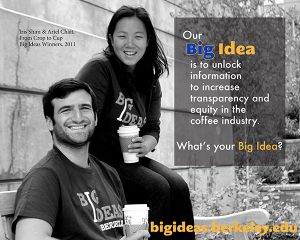 In 2006, Big Ideas @ Berkeley was launched to support multidisciplinary teams of UC Berkeley students interested in big challenges such as clean energy, safe drinking water, and poverty alleviation.
In 2006, Big Ideas @ Berkeley was launched to support multidisciplinary teams of UC Berkeley students interested in big challenges such as clean energy, safe drinking water, and poverty alleviation.
Nine years later, the yearlong student innovation contest has become a model for on-campus collaboration and action—and has expanded to 16 universities around the country and world, including the entire University of California system and the USAID Higher Education Solutions Network.
As Big Ideas moves toward its 10th anniversary, it is facing big numbers. More than 4,000 students have submitted 1,248 proposals to the contest. During the last three years, participation from undergraduate students has increased dramatically—from 35 percent in 2010 to 70 percent in 2014.
According to an internal study from the Blum Center for Developing Economies, which manages Big Ideas, the contest’s 400-plus student teams and award winners have gone on to secure over $35 million in additional funding. Thirty percent of winners from 2006-2011 have won at least one additional award or business plan competition after participating in Big Ideas, and 50 percent have reported that their Big Ideas project is still running.
Among the projects that originated from Big Ideas are: Acopio, a data sharing software platform for agricultural producers, now managed by Fair Trade USA; Nextdrop, which uses mobile phone technology to transmit water supply and distribution information for Indian consumers; and Back to the Roots, a U.S. company that sells mushroom kits made from coffee grounds.
“From the beginning, Big Ideas was about developing an ecosystem of innovation to help bright young people get from idea to reality,” said Maryanne McCormick, executive director of the Blum Center for Developing Economies. “The contest is run and organized around the belief that there’s a value to giving young people more autonomy early in their career—and there’s a value to encouraging them to identify something that they’re passionate about. Over the last nine years, we have seen those values bear fruit.”
This year’s contest will offer up to $300,000 in funding for winning teams. It also will offer applicants a new contest category, Food System Innovations, sponsored by the UC Global Food Initiative and the Berkeley Food Institute. The UC Global Food Initiative, launched in July 2014 by UC President Janet Napolitano, brings together the university’s research, outreach, and campus operations in an effort to develop and export solutions throughout California, the United States, and the world for food security, health, and sustainability.
The contest launches on September 2, and spans the academic year, beginning with the submission of a five-page pre-proposal by November 13. If selected, finalist teams will be then prepare a full proposal by mid-March.
This year’s contest categories include:
- Clean & Sustainable Energy Alternatives
- Conflict & Development
- Creative Expression for Social Justice
- Food System Innovations
- Global Health
- Improving Student Life
- Information Technology for Society
- Mobiles for Reading
- Open Data for Development
- Scaling Up Big Ideas (for past winners only)
From September to March, when the final proposals are due, teams have the opportunity to attend information sessions, idea generation and networking events, writing workshops, editing blitz’s, and office hours with Big Ideas advisors in person and online. In addition, teams will be matched with mentors with expertise relevant to their project from a range of social enterprises, academia, nonprofits, and businesses.
Unlike many business competitions, Big Ideas is focused on supporting projects focused on social impact. The contest challenges students to step outside of their traditional university-based academic work, take a risk, and use their education, passion, and skills to work on problems important to them.
“The Big Ideas Contest helped us to think beyond what we had initially envisioned and push past our boundaries,” said Priya Iyer, a member of the Sahay team that won third place in the Information Technology for Society category in 2014.
For more information about rules, categories, resources, funding, and contact information, please visit the Big Ideas website at http://bigideascontest.org
Why I Do Development Work
By Nikki Brand
August 26, 2014 | Four days after graduation, I found myself on a plane to Guatemala. I had taken a dream job in Panajachel, or “Pana,” as the locals call the tiny, bustling town on the shores of Lake Atitlan, known for eternal spring weather, volcano-framed sunsets, and charming streets (okay, single street) lined with stands of brightly colored textiles sold by Mayan women. With a strong ex-pat culture and high quality of life, Pana is a Guatemalan hub for international development nonprofits like the one I was working for: Community Enterprise Solutions (CES).
But I didn’t go to Pana or Guatemala to loll in touristic charm. I was there to see what I could do to help. Almost two decades after the end of the country’s 30-year civil war, Guatemalans—especially indigenous Guatemalans who make up the majority of the country’s population—face persistent violence, inequality, poverty, and corruption. Roughly half of the country’s population lives in poverty, and Guatemala is the second most unequal country in Latin America—second only to Haiti—with most of the national wealth owned by a small and almost exclusively ladino (non-indigenous) upper class.
My job was to foster small businesses, and to generate income for poor women. The idea, based loosely on the success of the beauty company Avon, was to give local people products to sell with health, environmental, and economic benefits—products like eyeglasses, water filters, and cookstoves—and offer them a percentage of the profits from their sales.
At CES, I worked side-by-side with a Mayan woman named Juana Xoch. Despite our different backgrounds, Juana became a friend and confidant. While I had a comfortable childhood in a DC suburb, Juana at age 10 became a nanny in Guatemala City after the Civil War destroyed her community. She had no formal education, but she had taught herself to read and write, and was supporting her four-year-old son Jonathon through her work at CES.
Juana and I led charlas (educational presentations), piloted a referral program, and held guest lectures at schools to drive community interest. Slowly, we made contacts, sold a few products, and honed our marketing skills. Yet I often found myself frustrated.
At Berkeley, I was used to throwing myself into my studies and seeing immediate results. Now, I worked 15-hour days and traveled up to eight hours on rickety, undependable public transportation in torrential downpours—often without much to show for it. An example: Juana and I would try to sell water filters in an area where another nonprofit had already given them away for free. And despite the fact that the filters no longer worked, the families wouldn’t purchase something, even at a low cost, that they previously hadn’t paid for.
Halfway through the year, I reached out to UC Berkeley Lecturer Khalid Kadir, a mentor and member of the Blum Center’s Global Poverty & Practice faculty, for help. I explained that my work was not succeeding as I expected or wanted. Khalid commiserated with me over the challenges of development fieldwork. Then he encouraged me to think of success not just as end goals and long-term plans, but as a process. Even if I couldn’t take something from A to Z immediately, just getting it from A to C might be an accomplishment.
I began to retrain myself, to see that, in the long term, the contacts we made and the skills we learned were valuable. In the short term, however, Juana and I knew that for the sales representatives in our region, income was directly tied to product sales; lower sales would mean lower pay, regardless of what was learned in the process. And so, we sought to achieve a balance: we found ways to boost sales in the short term, while thinking about long-term ways to help Guatemalan communities facing hard challenges and ongoing conflict.
Now, I look back to see that my initial desire to get from A to Z was absurdly idealistic. Change, especially when dealing with issues of poverty and inequality, is slow. Yet I came to learn that this desire was both understandable and necessary, because without the energy to foster change, I would have found myself completely paralyzed.
Nikki Brand graduated from UC Berkeley in 2013 with a B.A. in Peace & Conflict Studies and minors in Spanish and Global Poverty & Practice. She spent her first year after graduation as a field consultant in rural Guatemala for Community Enterprise Solutions, and currently works at USAID’s Global Development Lab in Washington, DC.

